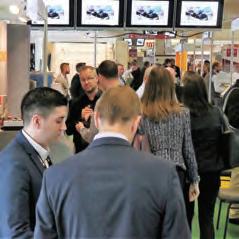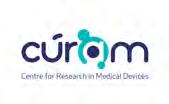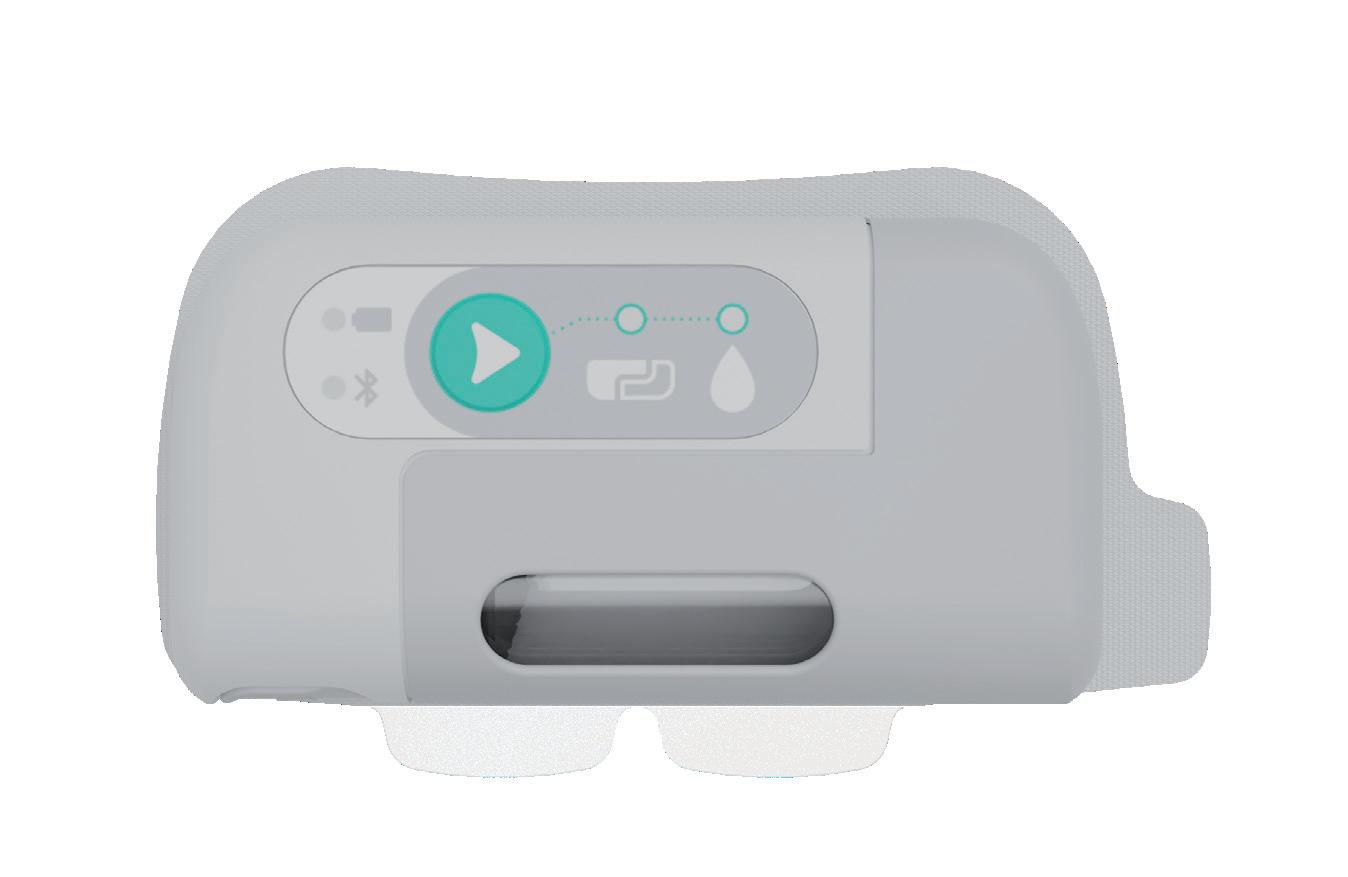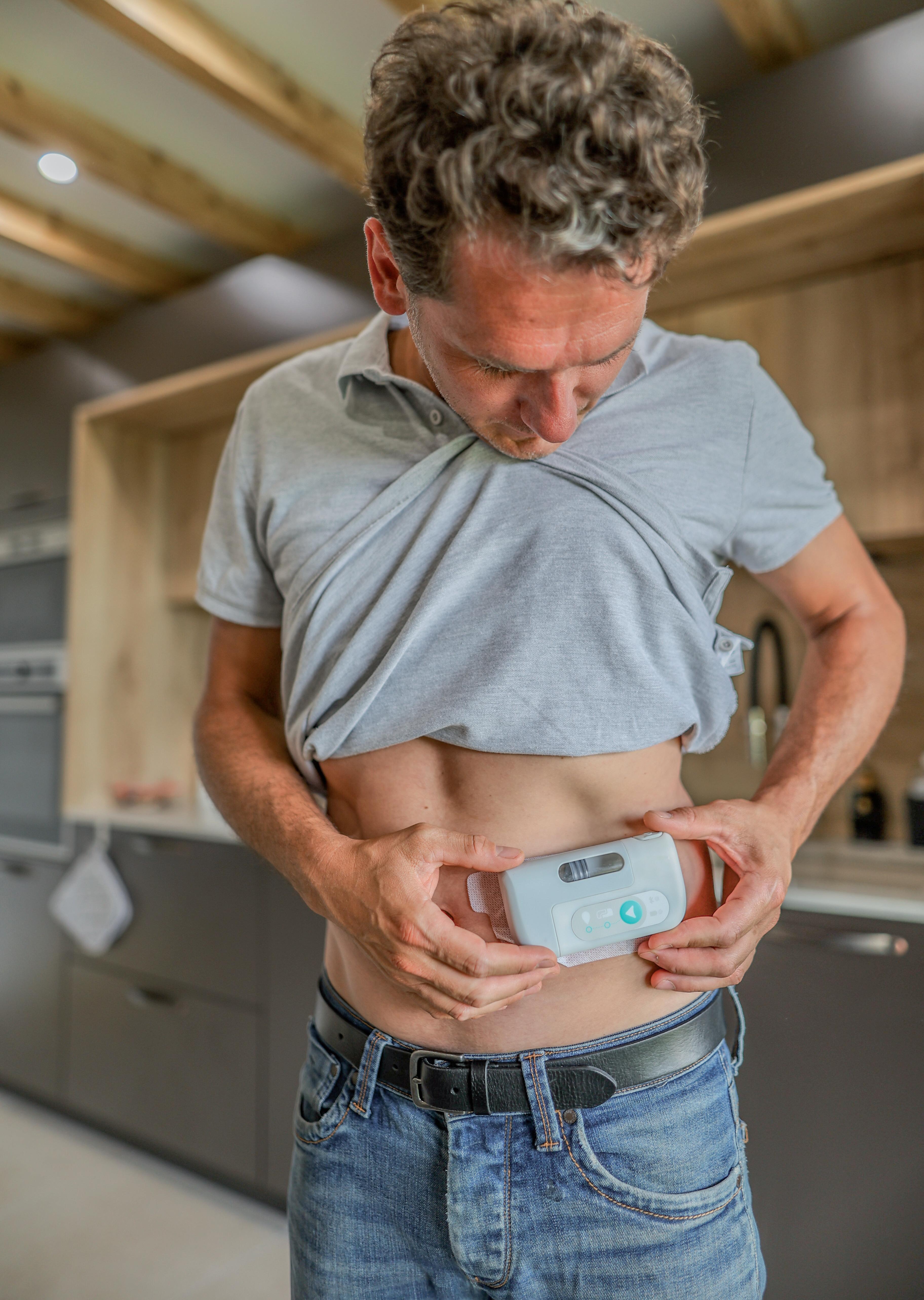WOULD YOU LIKE TO GO LARGE? KEY CONSIDERATIONS FOR LVIs
MECHATRONIC VS MECHANICAL WEARABLE DRUG DELIVERY SYSTEMS


WOULD YOU LIKE TO GO LARGE? KEY CONSIDERATIONS FOR LVIs
MECHATRONIC VS MECHANICAL WEARABLE DRUG DELIVERY SYSTEMS

THE VERTIVA™ ON-BODY DELIVERY SYSTEM: EXPANDING OPPORTUNITIES IN HOME-BASED CARE
OUTSTANDING ISSUE SPONSOR
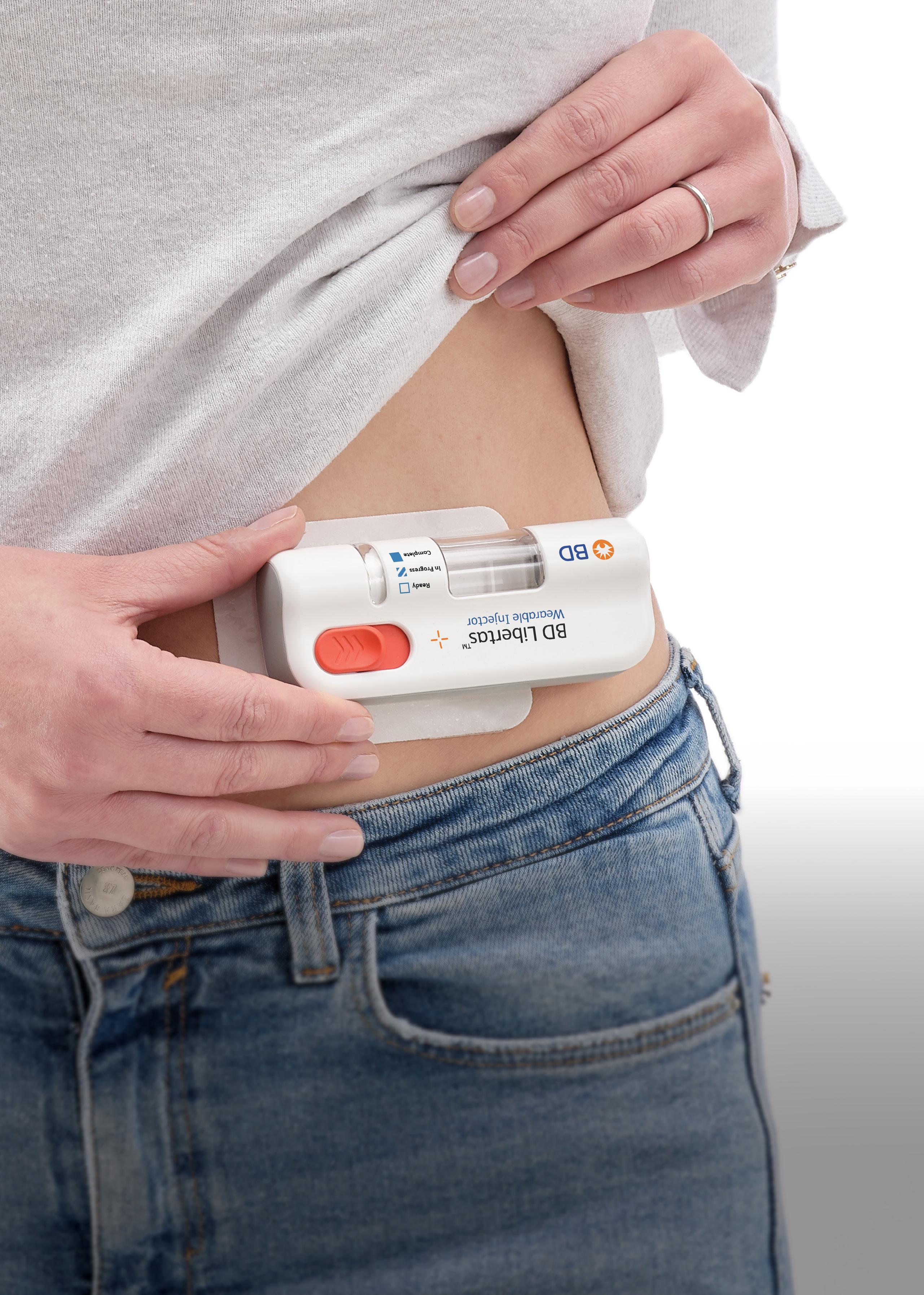
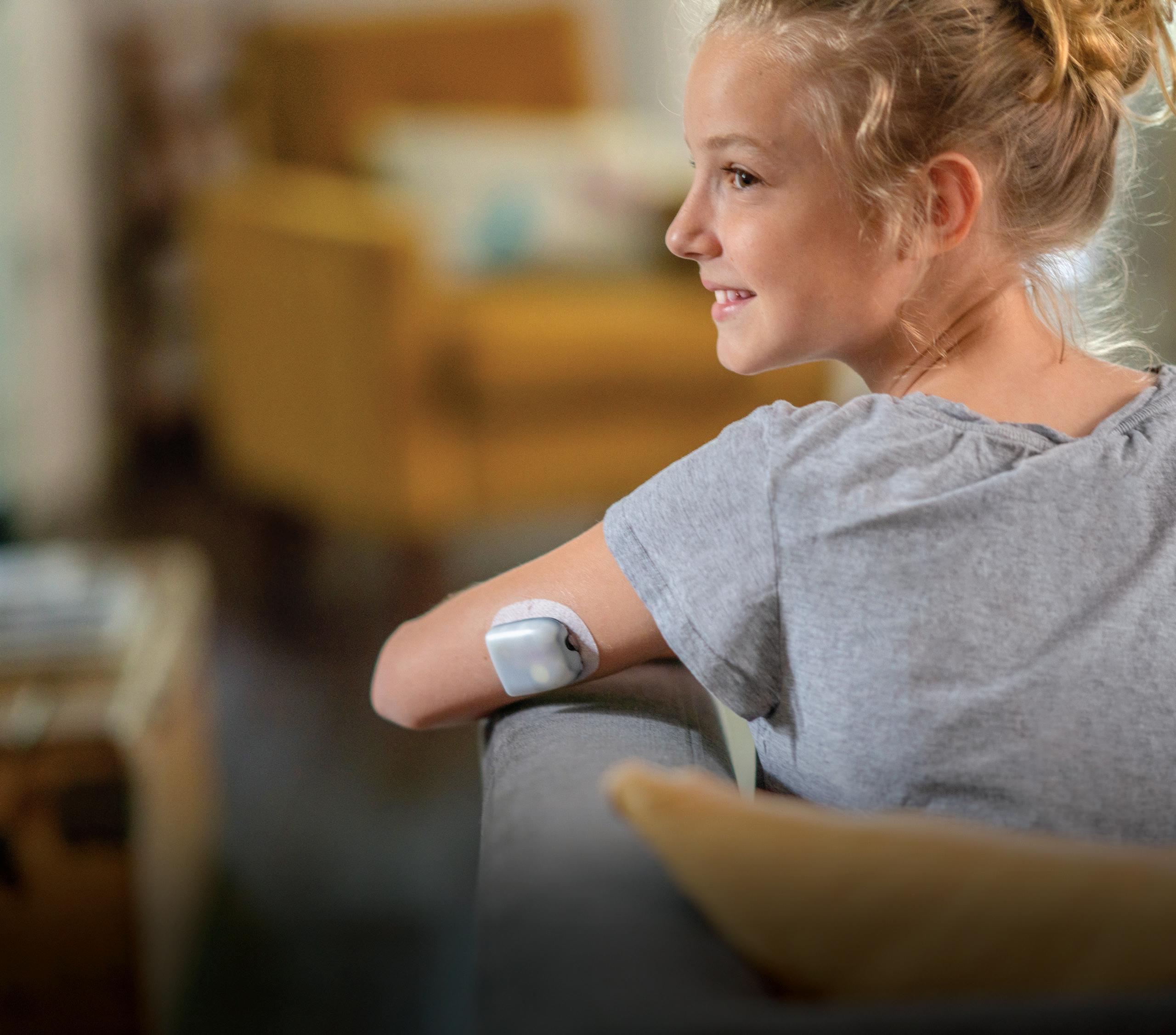
ONdrugDelivery Issue No 151, September 12th, 2023
WEARABLE INJECTORS
This edition is one in the ONdrugDelivery series of publications. Each issue focuses on a specific topic within the field of drug delivery, and is supported by industry leaders in that field.
EDITORIAL CALENDAR
Oct Prefilled Syringes & Injection Devices
Oct/Nov Drug Delivery & Environmental Sustainability
Nov Pulmonary & Nasal Drug Delivery
Dec Connecting Drug Delivery
Jan 2024 Prefilled Syringes & Injection Devices
Feb Skin Drug Delivery:
Dermal, Transdermal & Microneedles
Mar Ophthalmic Drug Delivery
Apr Pulmonary & Nasal Drug Delivery
Apr/May Drug Delivery & Environmental Sustainability
May Injectable Drug Delivery: Formulations & Devices
May/Jun Oral Drug Delivery
Jun Connecting Drug Delivery
Jun/Jul Industrialising Drug Delivery
Sep Wearable Injectors
EDITORIAL:
Guy Furness, Proprietor & Publisher
E: guy.furness@ondrugdelivery.com
CREATIVE DESIGN:
Simon Smith, Creative Director (Freelance)
E: simon.smith@ondrugdelivery.com
SUBSCRIPTIONS:
Audrey Furness (subscriptions@ondrugdelivery.com)
Print + Digital subscription: £99/year + postage
Digital Only subscription: free.
ADVERTISING:
Guy Furness (guy.furness@ondrugdelivery.com)
ONdrugDelivery is published by Frederick Furness Publishing Ltd
The Candlemakers, West Street, Lewes East Sussex, BN7 2NZ, United Kingdom
T: +44 1273 47 28 28
Registered in England: Company No 8348388
ISSN 2049-145X print / ISSN 2049-1468 pdf
06 - 09
12 - 15
17 - 21
22 - 24
28 - 32
34 - 36
37 - 40
YpsoDose – the Clinic-Ready 10 mL Patch Injector
Christian Esser Wiesemann, YpsoDose Platform Product Manager
Ypsomed
Directions For Wearable On-Body Injector Systems And Beyond
Matt Parker, Senior Consultant – Drug Delivery; Karthik Chellappan, Senior Consultant – Drug Delivery; and David Cottenden, Senior Consultant – Drug Delivery
TTP
Would You Like to Go Large? Key Considerations for Large-Volume Injectors
Malcolm Boyd, Senior Sector Manager – Medical and Scientific DCA
BD Innovation for Subcutaneous Delivery of Large-Volume Complex Biologics Beth McBride DiLauri, Director, Portfolio Marketing BD
Sustainable Design of a Drug Delivery Device for Biopharmaceuticals
Maike Wolf, Head of Innovation; and Marie Stockton, Marketing Manager Gerresheimer
Reusable Wearable Injectors: Lessons From In Vitro Diagnostics
Thomas James, Lead Mechanical Engineer
Key Tech
A New Frontier: Self-Administration of Lyophilised, Large-Volume Subcutaneous Biologics
Mehul Desai, Vice-President of Medical Affairs; and Daniel Waites, Director of Research and Development Enable Injections
42 - 45
46 - 50
Incorporating Motion Design at Early Stages of Wearable Injector Development Dave Beckstoffer, Business Development Manager Portescap
Comparison of Mechatronic vs Mechanical Wearable Drug Delivery Systems
Thomas Mayer, Medical Business Unit Manager; Nicolas Bailo, R&D Manager for the Business Unit Medical; and Martin Liniger, R&D Manager for electronics hardware and software Sonceboz
Extending Patient-Friendly Drug Delivery to High-Volume Wearable Devices
52 - 56
Iris Schnitzler, Head of Marketing and Market Services; Bas van Buijtenen, Business Executive and Non-Executive Board Member; and Andrei Yosef, General Manager and President LTS
57 - 60
ONdrugDelivery Magazine is printed sustainably by Newman Thomson Ltd, West Sussex, UK, using Forestry Stewardship Council® certified recycled paper, vegetable-based inks, biodegradable laminates and carbon balanced materials offset via the World Land Trust™ following ISO140001 processes.

Copyright © 2023 Frederick Furness Publishing Ltd
62 - 65
66 - 68
The ONdrugDelivery logo is a registered trademark of Frederick Furness Publishing Ltd.
The views and opinions expressed in this issue are those of the authors. Due care has been used in producing this publication, but the publisher makes no claim that it is free of error. Nor does the publisher accept liability for the consequences of any decision or action taken (or not taken) as a result of any information contained in this publication.
Front cover image, “YpsoDose Wearable Injector”, courtesy Ypsomed (see this issue, Page 6). Reproduced with kind permission.
The Vertiva™ On-Body Delivery System: Expanding Opportunities in Home-Based Care
Adam Stops, Head of Product Management for Drug Delivery Systems Stevanato Group
Chronic Patients at the Centre of Large-Volume Drug Subcutaneous Delivery with a Sustainable On-Body Injector
Cécile Gross, Global Category Manager, Parenteral and Mark Tunkel, Global Services Director Nemera
Injecting Innovative Solutions into Connected Delivery Devices
Roger Bohannan, Global Medical Segment Leader, Electronic Products Littelfuse
Technology Showcase: CCBio’s Felice Dose – Simplifying Subcutaneous Infusion
Jimmy Fan, Marketing Vice-President CCBio 72 -
Product Showcase: Complete System for Standard-Compliant Testing of Wearable Autoinjectors
Heiko Haller, Business Development Manager – Medical Industry ZwickRoell
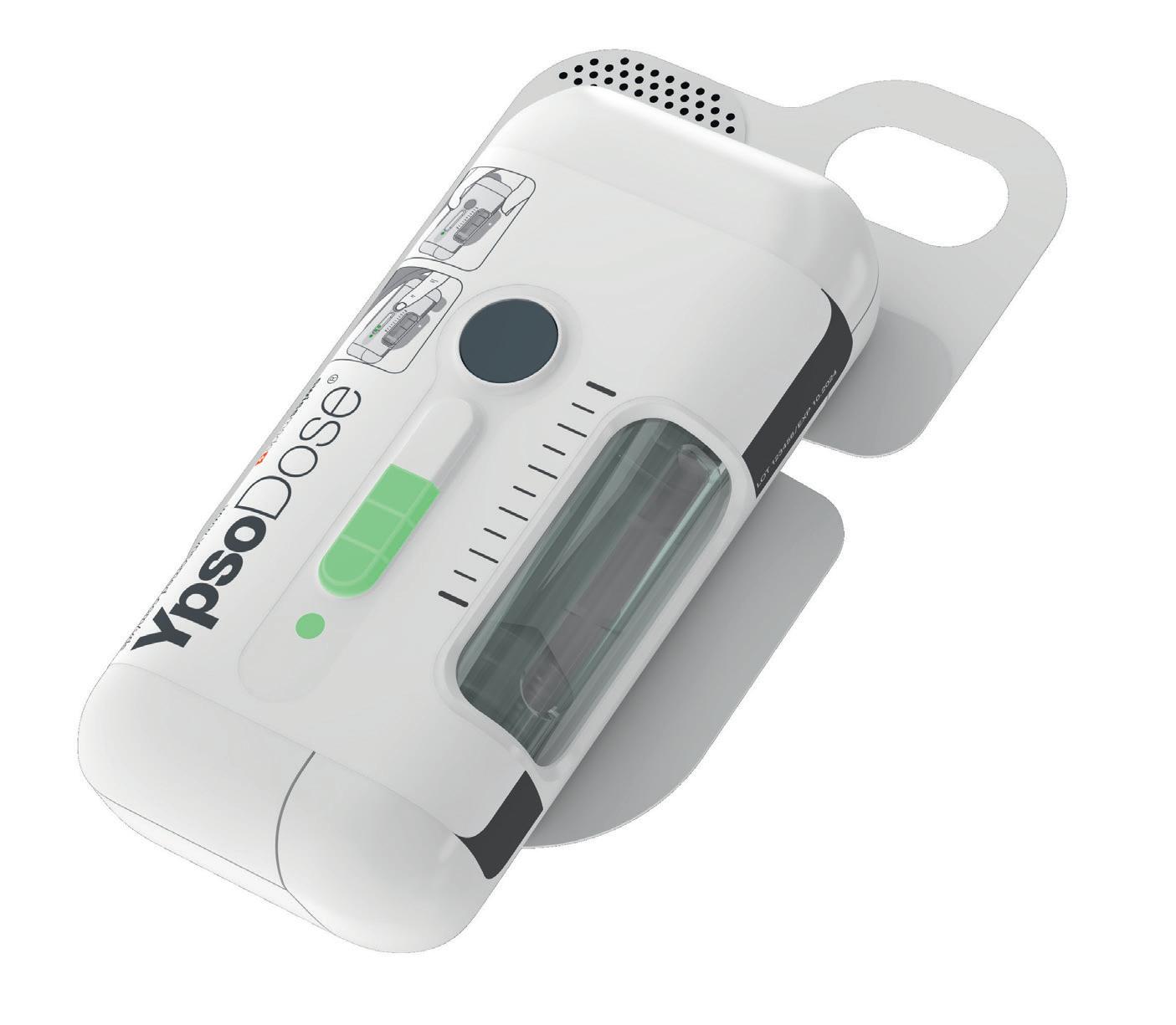
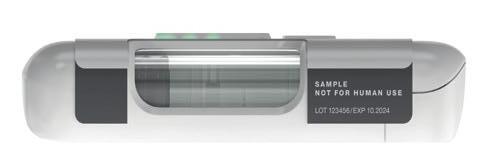


In this article, Christian Esser Wiesemann, YpsoDose Platform Product Manager at Ypsomed, provides the latest insights into the prefilled and pre-assembled YpsoDose patch injector, which is now available for clinical trials.
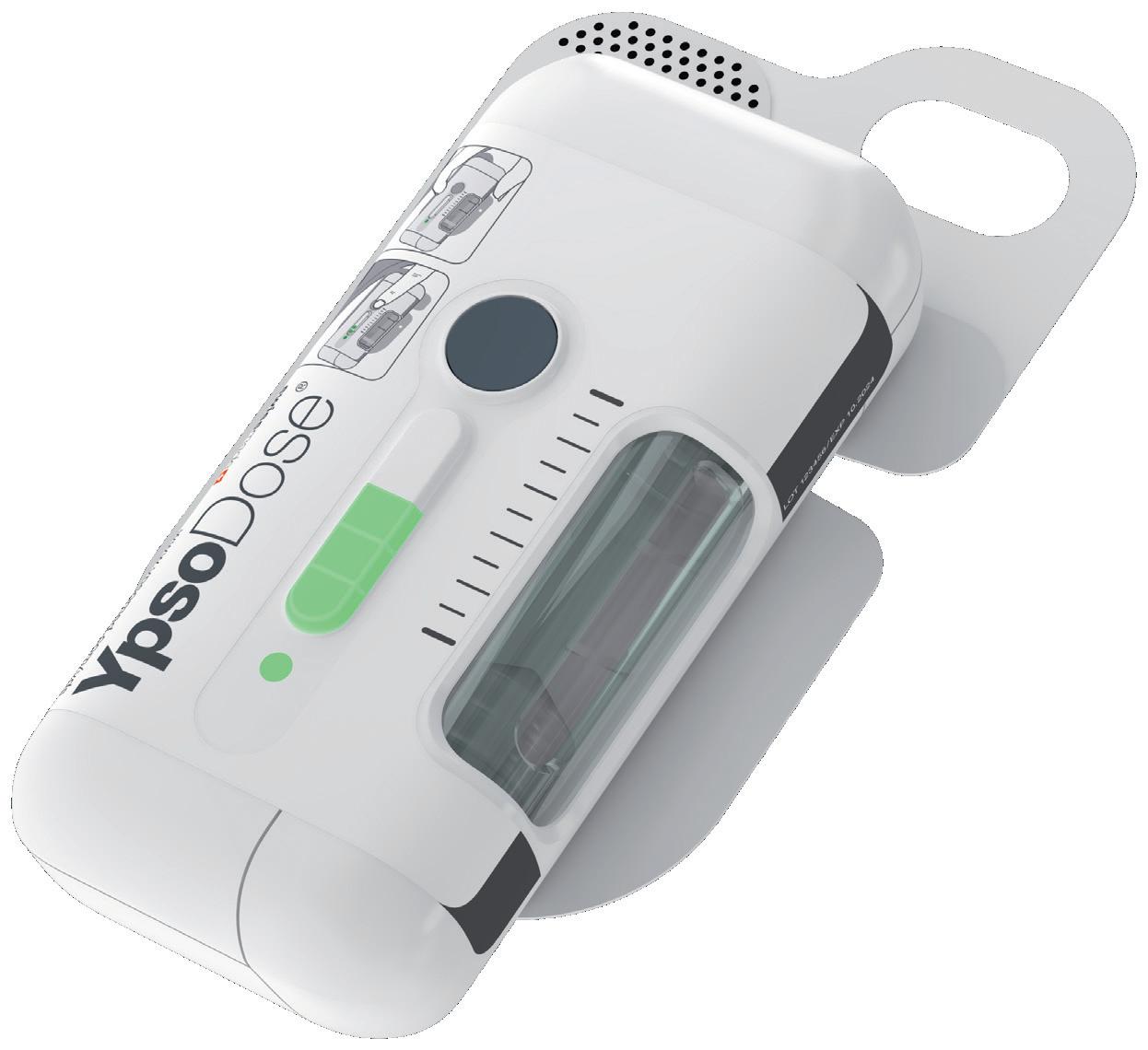
Subcutaneous injection has emerged as a prominent method of drug administration, with one-third of all injectable agents currently in development falling into this category. In recent years, there has been a noticeable shift towards fixed-dose regimens for antibody-based drugs, followed by an increase in subcutaneous dosing intervals towards once every four weeks, or even less frequent.
Therapy areas are developing in different ways regarding the use of patch injectors (Figure 1), such as highly potent subcutaneous oncology drugs, which
existing drugs, which lead to a higher administered volume in the already established homecare setting, as is the case with AbbVie’s Skyrizi (risankizumab).
These transitions have sparked discussions regarding the administration setting, and which devices are recommended for at-home care versus hospital settings, including the choice between on-body devices, autoinjectors or manual injection with syringes as the preferred routes of administration.
Christian Esser Wiesemann
YpsoDose
Platform Product ManagerT: +41 344 244 528
E: Christian.EsserWiesemann @ypsomed.com
Ypsomed AG
Brunnmattstrasse 6
CH-3401 Burgdorf Switzerland
www.ypsomed.com/yds
“Studies have shown that the total number of
Studies have shown that the total number of use steps plays a critical role in achieving a successful injection in the homecare setting.1 Fewer use steps enable patients to use the on-body device for treatment and perform a worry-free injection, whereas more use steps increase the incidence of user errors.
The patient preference between autoinjectors and on-body devices was tested in a study conducted by Ypsomed. It revealed that a reduction in injection frequency (biweekly to monthly to quarterly) increased the likelihood that patients would prefer wearable on-body devices to handheld autoinjectors. In addition, decreasing the injection duration of the on-body device (30 minutes to 8 minutes) increased the patient preference for the wearable on-body device.2
In another study,3 participants successfully completed simulated injections for the YpsoDose patch injector. The device received high ratings for wearability and usability, regardless of disease state, age or body size. Summarising the trends described above (less frequent, fixed dose, indication extension of existing drugs), a positive effect was seen from the use of on-body devices, which are designed to be patient centric for use in an at-home setting and mitigate the risk of potential misuse for patients who struggle with too many use steps (Figure 2).

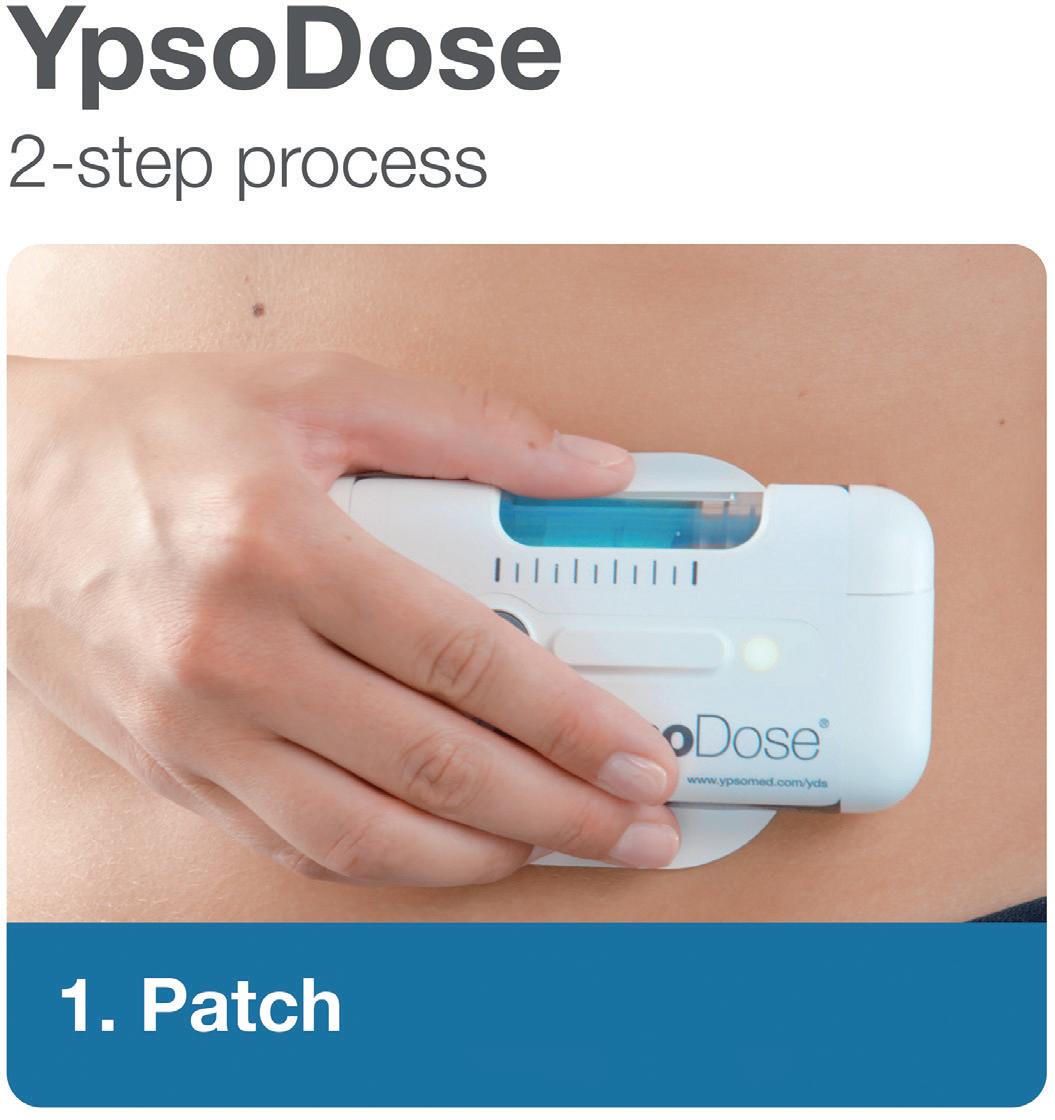
YpsoDose is supplied to the patient or healthcare provider (HCP) prefilled and pre-assembled to minimise the number of use steps and reduce the risk of misuse resulting in the handling steps. The pre-assembly of the ready-to-use (RTU) cartridge in YpsoDose is achieved using three sterile barriers protecting the skin needle, cartridge needle and cartridge stopper. All three sterile barriers are removed when the patch liner is removed immediately prior to placement on the skin and the start of injection.
The use of a conventional electromechanical syringe drive mechanism allows YpsoDose to be positioned in any orientation, enabling the patient to choose the most comfortable placing on the desired injection site. The drive mechanism and related software algorithm are designed to modify the injection rate if the patient does not allow the drug to warm up to room temperature. There is also the option for the user to interrupt the injection, due to pain, for example, if this provides an overall advantage in terms of usability for the therapy in question.
Ypsomed and SCHOTT Pharma (Mainz, Germany) have collaborated closely at their Swiss development and manufacturing sites to develop the 10 mL cartriQ® (Figure 3). The 10 mL cartriQ® is the perfect fit for YpsoDose, as it has unmatched inner surface properties (20% lower limit for hydrolytic resistance) and enables

“Ypsomed and SCHOTT Pharma have collaborated closely at their Swiss development and manufacturing sites to develop the 10 mL cartriQ®.”Figure 3: 10 mL cartriQ® from SCHOTT Pharma.
low levels of free silicone due to the stateof-the-art baked-on siliconisation process. Furthermore, the 10 mL cartriQ® nest offers 33% higher filling speed compared with other 10 mL cartridge offerings, enabling more efficient processing on fill-and-finish lines.
The cartriQ® sterile barrier crimp cap plays a central role in maintaining the sterility of the RTU cartridge within the pre-assembled YpsoDose device. The cartriQ® sterile barrier is applied during the cartridge assembly and packaging process on SCHOTT Pharma’s new RTU cartridge manufacturing line in Switzerland.
Ypsomed has implemented cleanroom manufacturing at its Swiss facilities for both the sterile fluid path, which is an integral part of the YpsoDose needle unit, and the sterile barrier crimp cap (Figure 4). The needle unit is ethylene oxide sterilised and the 10 mL cartriQ® is steam sterilised during their respective manufacturing processes at Ypsomed and SCHOTT Pharma. Sterility testing of the final assembled device has been completed internally and in collaboration with pharma clients during feasibility and clinical work.
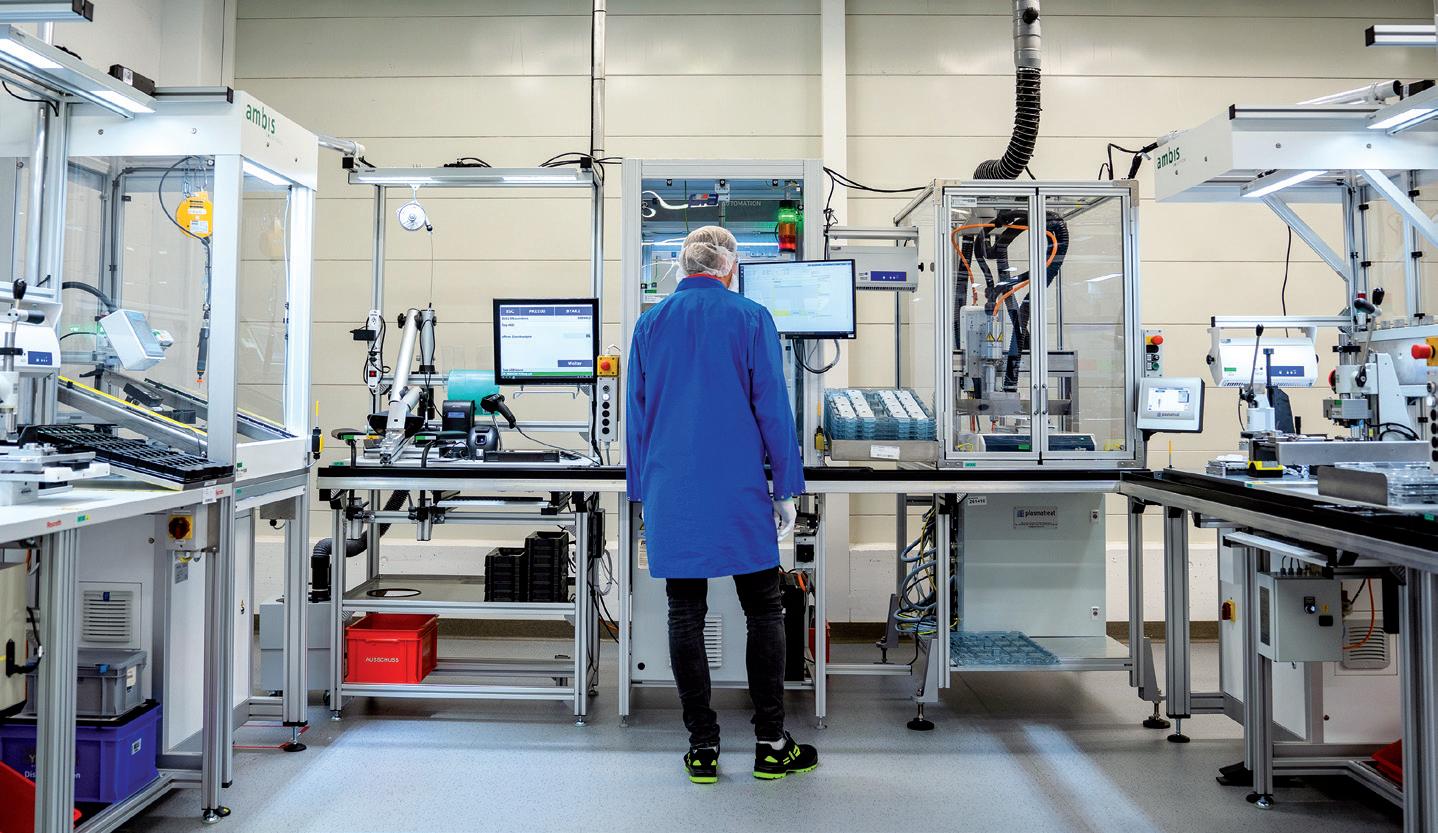
YpsoDose device assembly is performed using a dedicated line in a clean device assembly environment in Switzerland. Assembly is co-located with Ypsomed’s insulin pump manufacturing, which includes similar processes designed for electromechanical technologies. Dedicated design verification equipment has been developed and implemented at Ypsomed’s testing laboratories in Burgdorf (Switzerland) to facilitate the successful performance of ISO 11608 testing for multiple customers. The cleanroom and device assembly infrastructure are designed to serve multiple clinical trials as well as low-volume commercial quantities (Figure 5).
Fill-finish contract manufacturing organisations (CMOs) have performed filling batches with the 10 mL cartriQ® format on their filling lines and both SCHOTT Pharma and Ypsomed provide open and co-ordinated support to these companies and their pharma clients. Final assembly equipment is specified with leading suppliers and a first clinical/ commercial line will be placed at a leading CMO.
For pharma companies to consider and invest in patch injectors, they need to be able to access reliable device technology and implement standard filling and final assembly processes that provide a turnkey solution that fulfils the needs of pharma companies, HCPs and patients. Fulfilling these requirements with wellthought-out device technology will allow
the patch injector market to grow over the coming years and become established as the third self-injection device class, complementing the maturing markets for pen injectors and autoinjectors. The 10 mL YpsoDose has undergone thorough internal testing and comparative studies with pharma customers and Ypsomed is committed to the successful commercialisation of YpsoDose as a new state-of-the-art patch injector.
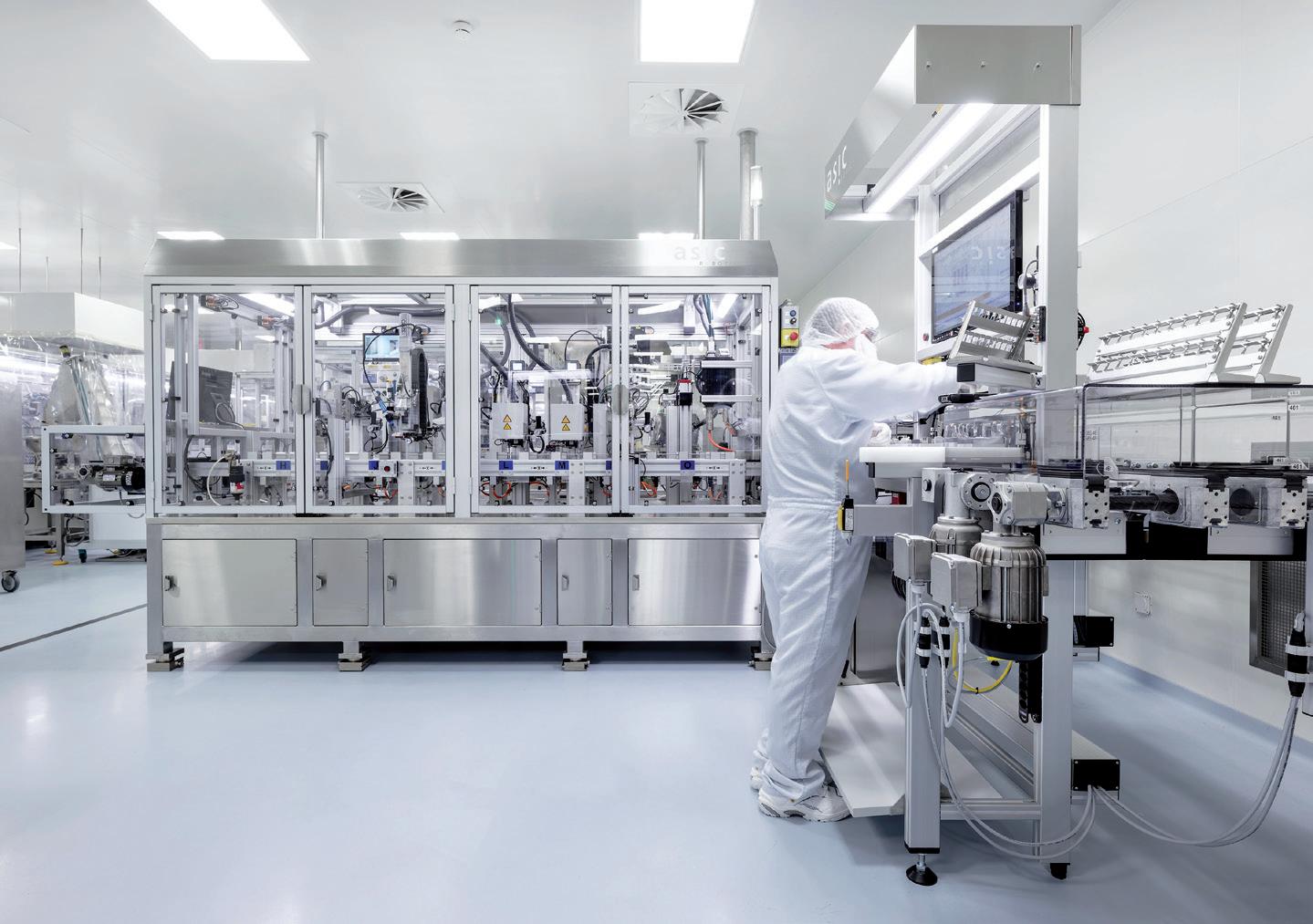
“Ypsomed is committed to the successful commercialisation of YpsoDose as a new state-of-the-art patch injector.”
Ypsomed’s comprehensive drug delivery device platforms consist of autoinjectors for prefilled syringes in 1 and 2.25 mL formats, disposable pens for 3 and 1.5 mL cartridges, reusable pen injectors, RTU prefilled wearable patch injectors and injection devices for drugs in dual-chamber cartridges. Unique click-on needles and infusion sets complement the broad selfinjection systems product portfolio.
With over 35 years of experience in the development and manufacture of innovative injection systems, Ypsomed is well equipped to tackle digital healthcare challenges and has strategically invested in the development of connected solutions and therapy-agnostic digital device management services.
Anticipating the future needs of patients, pharmaceutical customers, payers and HCPs, Ypsomed moves beyond manufacturing connected sensors. Ypsomed’s smart device solutions strive to transform patients’ lives by capturing therapy-relevant parameters, processing them to facilitate self-management of
chronic diseases and integrating these insights with digital therapy management ecosystems.
The company leverages its in-house capabilities in electronics, software and connectivity for the development of new devices and digital product systems. Ypsomed is ISO 13485 certified and all its processes comply with design control and cGMP guidelines with operational QA/QC experts on-site at each location. Ypsomed’s US FDA-registered manufacturing facilities are regularly inspected by pharma customers and regulatory agencies to supply devices for global markets, including the US, Europe, Japan, China and India.
1. Loftus EV Jr et al, “Efficacy, Safety, Patient Experience, and Tolerability of Risankizumab Administered by On-Body Injector for Moderate to Severe Crohn’s Disease”. Adv Ther, 2-13 Vol 40(5), pp 2311–2325.
2. Schneider A et al, “Understanding patient preferences for handheld
autoinjectors versus wearable largevolume injectors”. Expert Opin Drug Deliv, 2023, Vol 20(3), pp 273–283.
3. Lange J et al, “Formative Study on the Wearability and Usability of a LargeVolume Patch Injector”. Med Devices (Auckl), 2021, Vol 14, pp 363–377.
Christian Esser Wiesemann is YpsoDose Platform Manager at Ypsomed Delivery Systems. He has been with Ypsomed since 2016 in a number of roles in product and project management. Since 2020, his main focus has been on the YpsoDose patch-injector platform. Mr Esser Wiesemann holds a Diploma in Business Administration from RWTH Aachen (Germany). He has 11 years’ experience in many different positions across the supply chain and has seven years’ experience in the medical device industry.
24-26 October 2023 | Barcelona, Spain
Pharma’s largest event is making an exciting return to Barcelona on 24-26 October 2023.

Join us at CPHI Barcelona to position your company at the heart of pharma and to connect with international pharma professionals. Grow your business and expand your network in one of Europe’s leading countries in pharma.
45,000+ Attendees
160+ Countries
2000+ Exhibitors
cphi.com/europe
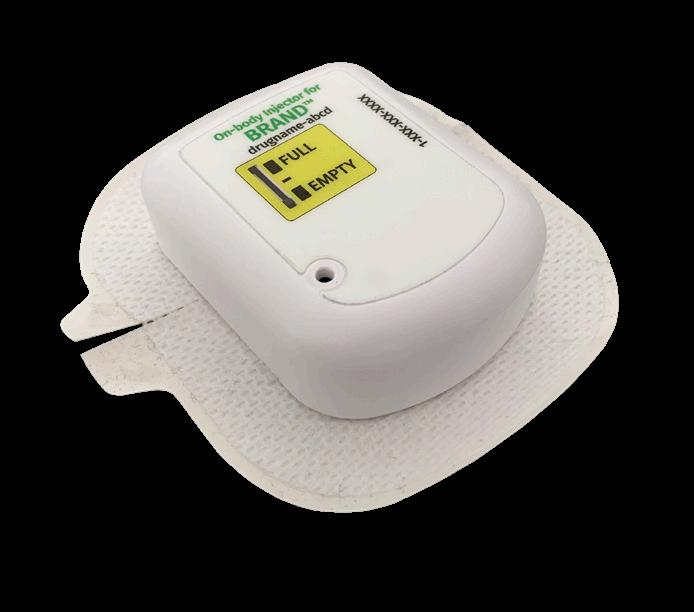

The semi-automatic systems of teamtechnik are designed for a short return of investment. They are scalable to be adapted to your production needs. All processes from fluid path, electronics assembly to the final functional test are included.
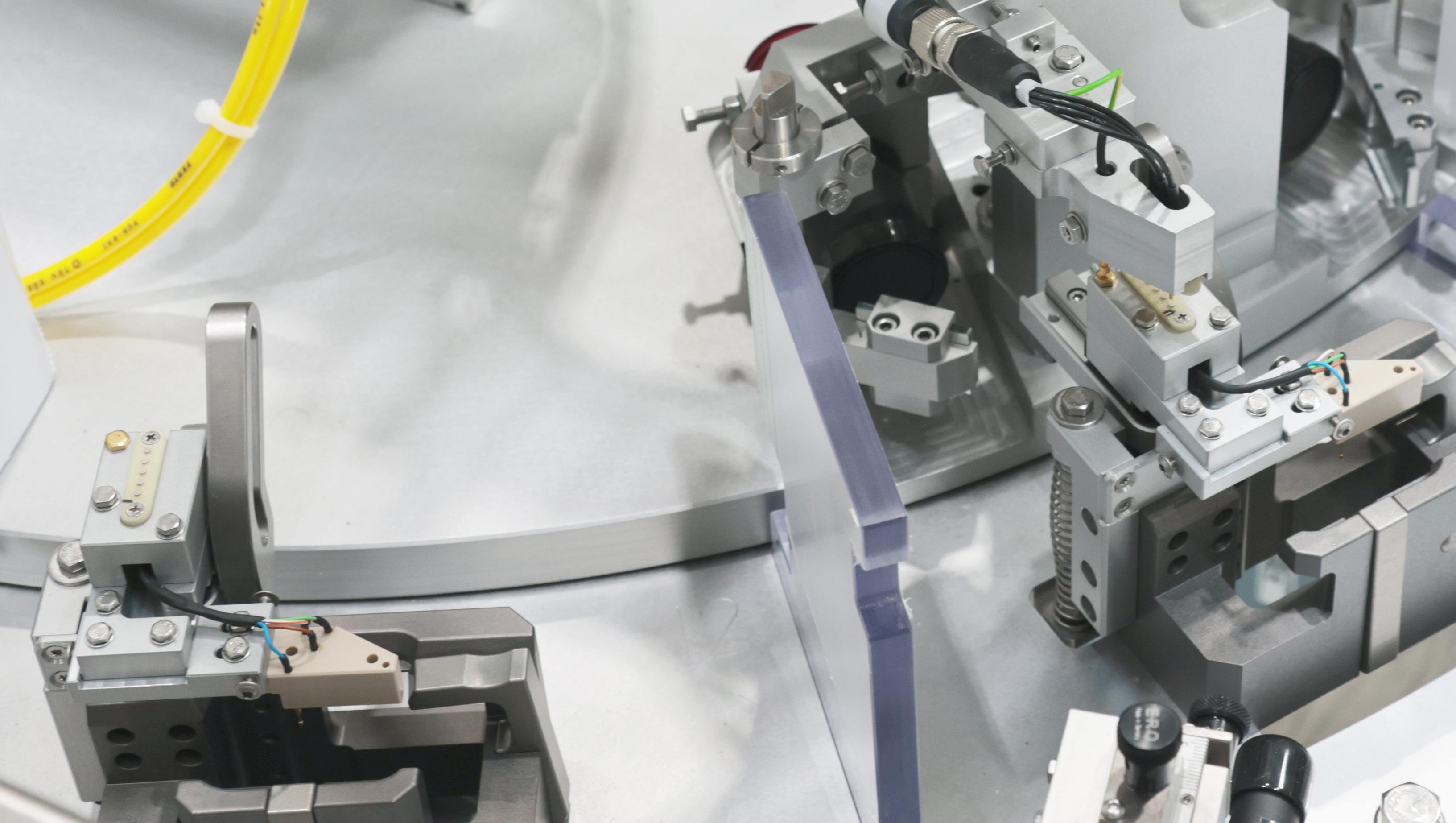
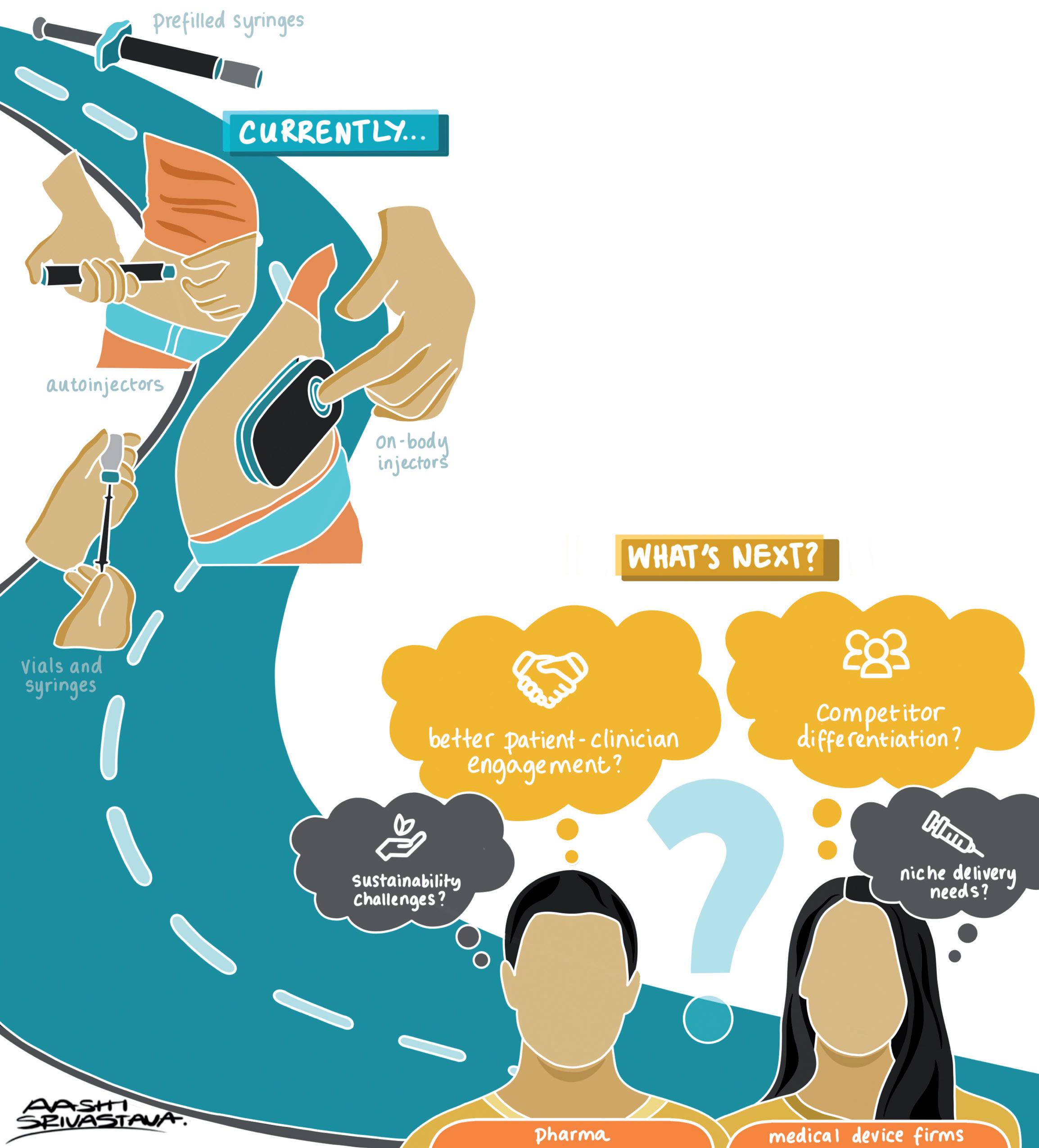
Here, Matt Parker, Karthik Chellappan and David Cottenden, PhD, all Senior Consultants – Drug Delivery at TTP, discuss the current state of play for large-volume injection and look into the challenges that on-body delivery systems currently in development will need to overcome to find success in a changing marketplace.
With the continuing movement of disease management into patient’s homes, injection device design will have to answer a changing set of demands – from dose volume and form factor to sustainability and cost per dose, as well as “platformability” and value-add – that will challenge existing partnership models in the industry (Figure 1). Future platforms could even borrow from the design of Nespresso coffee machines to accommodate a wider range of drugs.
Matt Parker
Senior Consultant – Drug Delivery
T: +44 1763 262626
E: matthew.parker@ttp.com
Karthik Chellappan
Senior Consultant – Drug Delivery
T: +44 1763 262626
E: karthik.chellappan@ttp.com
Dr David Cottenden
Senior Consultant – Drug Delivery
T: +44 1763 262626
E: david.cottenden@ttp.com
TTP plc
TTP Campus Cambridge Road Melbourn
SG8 6HQ United Kingdom www.ttp.com
So far, two main trends have driven the development of injectable drug delivery devices:
• The growing share of biologic drugs in pharmaceutical pipelines, causing a shift away from oral towards injectable delivery
• Treatment moving from in-clinic to at-home, creating a need for more “patient-friendly” solutions than traditional vial-and-syringe or prefilled syringe presentations.
In the smaller-volume injection space, this has led to a proliferation of autoinjector systems. These typically deliver volumes of 1–2 mL and offer a convenient and patientfriendly means of delivering therapies, due to few use steps, sharp safety, hidden needles and low dexterity requirement. However, many therapies present formulation challenges to achieving these volumes, either due to stability concerns or viscosity. As such, there is increasing demand for devices capable of delivering larger doses, ranging from 3 to 100 mL, or even more. Indeed, several vendors, including SHL (Zug, Switzerland) and Ypsomed (Burgdorf, Switzerland) recently announced 5 mL autoinjectors.
The fundamental limitation of this class of devices is time, or how long a user can reasonably be expected to hold the device against their skin to complete a delivery. If the user lifts the device before completion, or too soon after, they will cause a wet injection where the therapy will not be correctly delivered.
For standard injectable primary packaging, the maximum delivery pressure is generally set by the strength of the glass vial. Infusion time is therefore dominated by the flow resistance of the needle. The relationship between viscosity, volume and delivery time is described by a Poiseuille flow model.
For example, 5 mL of a 30 cP viscosity drug with a standard 27G needle leads to an expected delivery time in excess of two minutes, and over 45 seconds even with thin-wall needles.
Many patients find it difficult to continue after even 30 seconds, so the scope for extending the autoinjector format is clearly limited. Furthermore, physiological modelling of pain (nociception), suggests
that delivery of larger volumes of viscous drugs could also be unbearably painful within these timeframes.
One alternative is to use several autoinjectors to deliver the total dose. But sequential injections present other known challenges for patient compliance. Increasing the frequency of dosing from weekly to daily also presents similar compliance challenges and may not provide the required pharmacokinetic performance.
On-body delivery systems (OBDSs) –provide another route around the time challenge. By adhering the delivery device to the skin, the need to hold the device steady is removed, thereby enabling the delivery of larger doses. This realisation has prompted the development of at least ten large-volume wearable device platforms from a range of device manufacturers. These large-volume injection (LVI) solutions range from single-use mechanical to reusable electromechanical systems. Multiple companies are developing and commercialising these devices, including:
• Ypsomed (see this issue, p 6)
• West Pharmaceutical Services (PA, US)
• BD (see this issue, p 22)
• Sensile Medical, since acquired by Gerresheimer (see this issue, p 28)
• Nemera (see this issue, p 62)
• Enable Injections (see this issue, p 37)
• Sorrell, since acquired by LTS (see this issue, p 52)
• CCBio (see this issue, p 66)
• Subcuject (Hellebaek, Denmark)
• Sonceboz (see this issue, p 46)
• Weibel, since acquired by SHL.
But despite the proliferation of LVI devices available for license, few have launched. Neulasta (pegfilgrastim), by Amgen (CA, US), has been on the market
in a repurposed Omnipod (Insulet, MA, US) device since 2015. However, while wearable, this is only a 0.6 mL device. Amgen has also launched Repatha (evolocumab) in the West SmartDose 3.5 mL (5 minute wearable) in 2016, with AbbVie (DE, US) following in 2020 with Skyrizi (risankizumab) and, as of 2023, scPharmaceuticals (MA, US) are close to market with Furoscix (furosemide) in West’s 10 mL SmartDose. There have been some US FDA hold-ups relating to the manufacturing, testing, labelling and features of the Furoscix combination product, demonstrating the challenges of developing and launching in this market.
However, despite few launches to date, many of the companies developing these devices have announced partnerships with pharma clients. Numerous clinical trials of OBDSs are ongoing, further highlighting the interest from pharma in LVI.
Due to their increased part count, the cost of these systems is thought to be at least an order of magnitude higher than for autoinjectors. Increased complexity is apparent both in terms of the time and cost of R&D, as well as in the difficulties encountered by pharma when working with medical device partners to accommodate therapy-specific delivery requirements. In addition, high upfront licensing costs often limit the applicability of the current generation of OBDSs to a broader range of therapies.
While the aforementioned trends continue, new ones are making themselves felt. In particular, OBDSs are facing challenges from a greater demand for sustainable medical devices and delivering value in the context of changing reimbursement models.
The demand for higher volumes does not seem to be plateauing, not at 5 mL, or even at 10 mL. While West’s SmartDose 10 is one of the larger devices close to market, new therapy areas, including immunology
“The demand for higher volumes does not seem to be plateauing, not at 5 mL, or even at 10 mL.”
“By adhering the delivery device to the skin, the need to hold the device steady is removed, thereby enabling the delivery of larger doses.”
and oncology, are driving a need for even larger-volume devices. Multiple manufacturers are responding by adopting 20 mL primary pack sizes for their pipeline devices – Sorrel (20 mL), Sensile (up to 20 mL), Sonceboz (up to 20 mL) and Enable Injections (up to 50 mL). This trend is likely to continue.
Another important driver for volume is in enabling therapies that were previously delivered via the intravenous (IV) route to be reformulated for subcutaneous (SC) infusion at home. An example here is Abbvie’s Skyrizi, where the initial doses are delivered via IV infusion but subsequent doses are delivered by an OBDS.
In addition, future drug pipelines will demand greater flexibility from injector platforms. Challenges include the co-administration of multiple drugs, varying viscosities, complex reconstitution and mixing steps, weight-based dosing and stability. To date, the majority of devices have been optimised around a specific usecase – a specific volume, user interaction (prefilled or patient-filled) – or require the adoption of a specific dose container.
In terms of industry partnerships, this currently leaves pharma with the choice to either “lock-in” to the constraints of a specific partner’s device or maintain relationships with a suite of vendors with different offerings. A platform capable of accommodating all of the diverse and varied requirements of future pipelines is yet to be developed. Additionally, for medical device companies, supporting multiple pharma partners in the development stage represents significant overhead, adding cost and time to development. Flexible and adaptable technologies that robustly address these challenges would be highly desirable.
The majority of systems in development are single-use disposable devices. However, given that the majority are complex electromechanical systems, the sustainability impact is significant. The volume of
autoinjectors disposed on an ongoing basis is already recognised as problem and, with growing demands for sustainability, the industry should avoid a repeat with OBDSs. Growing societal pressures suggest that future platforms will need to be designed from the bottom up for sustainability.
By enabling new drugs to be delivered at home, OBDSs already add value for healthcare providers. Some of the existing devices already have a connectivity solution to connect with apps and mobile devices. Future devices may have to satisfy additional, more complex requirements, such as for dose and delivery verification.
The volume that can be delivered via the SC route is limited by the make-up of SC tissue. SC infusions of 20 mL of immunoglobulin therapies (SCIg) are routinely delivered over longer infusion times. Co-formulation or co-delivery with hyaluronidase permits the SC infusion of ever larger volumes. Facilitated SCIg delivery can allow up to 700 mL to a single site.1
However, the biomechanics of the skin is not the only consideration in device design. Increasing volume increases the size and weight of the device, especially if glass primary dose packaging is being used. There is a practical limit for what is tolerable to be worn on-body before other formats start to make more sense. Insulin infusion pumps, for example, use a separate cannula and are carried on the waist. For very high volumes, ambulatory pumps may become an option, albeit the user interactions are significantly more complex than the “stick and press” interface of many OBDSs.
The carbon footprint of patients travelling to a clinic often eclipses the footprint of individual devices, meaning that at-home therapy already represents a net carbon
saving.2 However, the footprint of a single-use, connected, electromechanical device is significant. This can be addressed through reduced material use and increasing circularity.
Considering sustainability from the ground up may result in very different device architectures, in particular with a disposable and reusable component. The former will likely contain the dose, needle and fluid path, as well as the adhesive; while the latter includes the energy source, control electronics and drive engine. Sensile and Nemera, among others, are taking this approach with their devices.
Design for sustainability is also linked to cost-per-dose performance. Cost modelling indicates that reusable-disposable architectures can achieve a cost per dose comparable to a regular autoinjector when considered over a year of monthly treatment.
Adapting to the Needs of Diverse Therapies
Platform approaches to device development bring benefits in terms of time-to-market and risk against a background of diversified drug pipelines. Modular designs can mitigate the technical risks of needle insertion, drive engines and power across varying device form factors. However, flexibility is often limited by the selection of a primary pack, which represents a significant qualification effort, particularly for larger volume formats that enable the delivery of a variety of combinations.
However, there is room for technologies that simplify the adaptation of platforms to various requirements, such as volume, viscosity and dose preparation. For example, the Owen Mumford (Woodstock, UK) Aidaptus autoinjector platform has a self-adjusting design to automatically accommodate different fill volumes without requiring a change in device or parts. It is likely that there will be a rise in “platformable” wearable injectors that adopt similar approaches to accommodate variation in fill volume, viscosity and flow rate.
Inspiration can even come from platforms outside of drug delivery. Nespresso’s Vertuo coffee machines encode the brew parameters in a barcode on-pod. This allows coffees with new brewing requirements to be released to distributed machines without updating them. Encoding delivery parameters into the dose-containing disposable element could similarly reduce the revalidation required to adapt the delivery system to new therapies, increasing the system’s potential as a platform.
“The volume of autoinjectors disposed on an ongoing basis is already recognised as problem and, with growing demands for sustainability, the industry should avoid a repeat with OBDSs.”
Finally, the changing scope of reimbursement in many geographies is creating a demand for platforms that provide additional value beyond delivery. With many newer drugs, sensing and remote monitoring will be essential for healthcare providers and pharmacists, who will need to play an increasingly active role in disease management. By integrating sensors and connectivity into devices, administration events can be tracked and reported. Timely intervention is required to ensure that patients keep to their dosing schedule, but also to manage treatment-associated reactions or adverse events and keep doses in the optimal therapeutic windows.
With the rise of reusable devices, medication authentication is also a critical concern. Wearables equipped with authentication mechanisms, such as barcodes, near-field communication and unique identifiers, can help patients verify the legitimacy of the medication being administered and prevent unapproved therapies from being delivered. Additional sensors may also help support the logistics of delivery, for example, by verifying the cold-chain storage of a temperaturecontrolled medication, or by verifying that a dose has warmed to the correct temperature prior to delivery.
Connected devices provide a unique opportunity to support disease management and engage patients with their therapies. Through real-time data collection and analysis, these devices can provide personalised insights and reminders to patients, encouraging patients to adhere to their medication schedule. However, uncertainties in the commercial viability of pharma-contract manufacturer partnership models need to be addressed before the full clinical potential of connectivity can be unlocked.
The trends behind the rise of autoinjectors and proliferation of OBDSs continue
unabated. OBDSs that move the delivery of drugs to the home setting hold great promise, but it seems likely that future platforms will have to address a new set of technical and commercial challenges. As dose volumes and viscosities increase, filled-device weight will become a greater consideration in design and may prompt alternative form factors, energy sources and delivery strategies. To meet societal demands for greater sustainability, devices could be split into hybrid (reusableconsumable) architectures. Despite this, the user workflow needs to be kept simple; human-centric and behavioural design will be essential to maximise adherence and to empower patients to manage their condition at home.
Hybrid architectures and larger primary packs will also raise new technical challenges, such as transferring power between components (mechanical, electrical or other) and verifying dose authenticity. Finally, the addition of sensing and connectivity will provide additional opportunities to build solutions that empower patients to monitor their condition. These demands will test existing partnership models and accelerate innovation in future platform technologies.
TTP is an independent technology company. Its combination of science and engineering means that it has the know-how to help solve the toughest challenges and get technology to market fast. The company’s consultants are empowered to collaborate with clients, and each other, in a truly agile way. This has been a cornerstone of the company’s success for over 30 years, allowing TTP to develop and deliver thousands of pioneering products and services. From start-ups to blue chip organisations, what unites TTP’s clients is their desire to make brilliant things happen.
1. Jolles S, “Hyaluronidase facilitated subcutaneous immunoglobulin in primary immunodeficiency”. Immunotargets Ther, 2013, Vol 2, pp 125–133.
2. Wilkinson N, “Ready for Net Negative? Minimising Healthcare’s Contribution to Climate Change through Innovation”. TTP white paper, Apr 2023.


Matt Parker is Senior Consultant – Drug Delivery and a project lead at TTP. With a background in mechanical engineering, he has led multidisciplinary teams developing next-generation devices across drug delivery, rapid diagnostics and biosensors. Mr Parker’s experience stretches from early concept development through taking devices from first prototypes to clinical trials.

Karthik Chellappan is Senior Consultant – Drug Delivery at TTP and a mechanical engineer specialising in advanced mechanics, mechatronics and system design optimisation. He has led connected medical device projects across the spectrum from early-stage concept generation through to detailed design optimisation, clinical trials and transfer to manufacture. Mr Chellappan is passionate about exploring the key technical, user and commercial factors that underpin successful value propositions and determining the trade-offs required to get impactful products to market.
David Cottenden, PhD, is a Senior Consultant – Drug Delivery at TTP. He holds a Master’s degree in Mathematics from Cambridge University (UK) and a PhD in Biomechanics from UCL (London, UK). Dr Cottenden’s work has encompassed everything from developing medical devices to exploring and mapping pain in drug delivery.
“The changing scope of reimbursement in many geographies is creating a demand for platforms that provide additional value beyond delivery.”
2023 PDA
17-18 OCTOBER 2023
GOTHENBURG, SWEDEN
CONFERENCE, EXHIBITION: 17-18 OCTOBER 2023
PRE-CONFERENCE WORKSHOPS, EXHIBITION: 16 OCTOBER 2023
TRAININGS: 19-20 OCTOBER 2023 PDA.ORG/EU/2023UPS
In this piece, Malcolm Boyd, Senior Sector Manager – Medical and Scientific at DCA Design International, discusses the factors that need to be considered early in the development of large-volume injectors, which will have a major influence on the performance, usability and cost of a device.
There is a growing need for injection devices that can deliver higher dose volumes than have traditionally been self-administered in the past. It seems that yesterday’s large dose is rapidly becoming today’s normal dose for some indications.
Handheld autoinjectors and variable dose pens used to typically max out at 0.8–1.0 mL for a single dose. This was then raised to 2.25 mL in devices from leading companies around 2019 – and even to 5.5 mL in the latest variants from 2022. As single-dose volume has increased in handheld devices, much has been discussed about how long a user can comfortably hold a pen-like device on their skin for reliable dose delivery. This holding time consideration has come hand in hand with a growth in the understanding of the body’s tolerability for a large-volume dose delivered in a single injection.
The move to increasingly large injection volumes has been further influenced by both micro and macro trends from within the medical sector, as well as wider socio-economic trends. For example, as a result of the covid-19 pandemic, there was a near overnight shift to online and virtual engagement across the world in all industries. This has ultimately led to an accelerated need for, and acceptance of, healthcare delivery outside the clinic.
When combined with a forecast growth in the global population of more than one billion people in the next 20 years and the fact that it is estimated that approximately a third of all adults already suffer from multiple chronic conditions, the prevalence and cost of managing chronic disease is only going to grow. Increasing the availability and quality of home healthcare offers a way forward in addressing the associated challenges, as well as having the potential to reduce healthcare costs. Furthermore, “disconnecting” patients from intravenous poles by offering at-home injection
solutions, where possible, has the potential to increase quality of life – not just for the patient but for their family and friends too.
Such market-influencing factors, combined with the growing injectable drug market and the continued need to reduce needle injury risk and save costs overall, are driving exciting opportunities in drug delivery, particularly for devices capable of delivering large-volume doses in patient-centric ways. The combination of these considerations has led to a growing interest in wearable autoinjectors capable of delivering a fixed dose of 2, 5, 10 and 25+ mL in a matter of minutes, without the need for the patient to hold them for an extended period of time.
When it comes to actually putting pencil to paper, however, and beginning to consider what sort of embodiment may be appropriate to address the market needs for large-volume injectors, there are a number of important aspects that need to be considered early on that will have a major influence on the direction of development and, ultimately, the performance, usability and cost of the device.
At the heart of the device, the primary container must hold the drug in a sterile and stable environment over the lifetime
Malcolm Boyd Senior Sector Manager –Medical
and Scientific
T: +44 1926 499461
E: malcolm.boyd@dca-design.com
DCA Design International Limited
19 Church Street Warwick
CV34 4AB United Kingdom
www.dca-design.com
“The format of the primary container is one of the decisions that will have the greatest impact on the product’s development direction and overall format.”
of the filled device. The format of the primary container is one of the decisions that will have the greatest impact on the product’s development direction and overall format. There are generally three main routes for integrated primary containers, with selection influenced by a number of factors, including long-term storage implications, drug stability, device form factor, manufacturing implications, filling strategy and compatibility with the drive system:
• Rigid glass container: glass containers offer excellent chemical durability but are fragile during transport and handling and weigh more than their plastic counterparts. They are also limited in their form and closure mechanism.
• Rigid plastic container: materials such as cyclo-olefin copolymer (COC) and cyclo-olefin polymer (COP) may offer more flexible form options with better tolerances, while maintaining good stability. However, care must be taken to ensure that gas permeation is minimal and any leaching does not affect drug performance.
• Flexible bag: multilayer constructions can potentially provide robust yet flexible pouches for drug storage. Additives or foils can be used to improve gas barrier properties, although long-term storage capabilities may be dependent on the specifics of individual drugs. Flexible bags can also be an attractive option for “fill at time of use” scenarios, where the drug is dispensed into the container from a vial or prefilled syringe by the user and is therefore only in transient contact.
Directly linked to the primary container and filling strategy is the device’s fluid path. If a device contains a prefilled primary container, it is not generally appropriate to sterilise the device with a drug on board and definitely not acceptable to introduce a non-sterile fluid path to a primary container or patient. As a result, a fluid transfer strategy needs to be conceived to enable movement of the drug from the container to the outlet/patient without compromising
sterility. This will require consideration of factors such as container closure integrity, needle sterility, needle gauge, the point at which fluid connection is made and the point at which drug is introduced to the system, as well as the implications for assembly, packaging, storage and transportation of device sub-assemblies and the final product. This is a critical interface and one that needs careful technical and usability consideration to balance potential additional steps and risks against other benefits.
The choice of drive system is very closely linked to the choice of primary container. The selection and integration of the drive system has to be considered in the context of whether the device is disposable or reusable, whether it is body-worn or not and the fluid path strategy, as well as configurability if it is intended to be a platform device –i.e. how easy it is to modify the drive system to accommodate, for example, different dose sizes, flow rates and viscosities. Each combination of decisions will impact device architecture and the user workflow, so must be considered together for optimal design efficiency and output.
Specifically thinking about the choice of drive system, at a high level there are push systems and pull systems. Push systems are the more traditional design, driving a piston forward to expel fluid, whereas pull systems draw the fluid from a reservoir. In pull systems there is the added consideration of whether or not the mechanism is in contact with the fluid – each option has its own advantages and disadvantages, depending on other architectural decisions.
Push systems are generally better suited to rigid containers, whereas a pull system could feasibly draw from any container, potentially offering the most flexibility – and therefore smallest package size. In both instances, consideration of the possible impact of the drive system, primary container and fluid path choices on the drug integrity should not be overlooked.
The cost per treatment is directly influenced by device cost. Device cost is, in turn, often linked to functionality and sophistication. It therefore follows that a simple, easy-to-use device, minimising cost and environmental impact, is a good route forward. However, in some cases it may be appropriate, or necessary, to introduce more advanced functionality – for example, to support user feedback, adherence, monitoring, connectivity, platform flexibility, etc. Such a sophisticated device may have a high cost of goods, making a disposable version both financially and potentially environmentally unattractive. A reusable embodiment may offer a significantly cheaper and more sustainable route if reused a sufficient number of times.
Where sophisticated features are needed, reusable and partially reusable devices offer significant potential for cost-effective and environmentally sustainable solutions through the reuse of high-value parts and sub-assemblies, such as motors, display screens and batteries. This approach potentially makes features such as enhanced feedback and connectivity more viable by “amortising” the cost of the device over an extended life. However, these advantages nearly always come with additional user task steps that, in turn, can create the potential for additional use errors.
With this in mind, and notwithstanding the above points, it is crucial to understand and consider the wider treatment ecosystem when making decisions on disposable versus reusable strategies. For example, a sophisticated disposable device may ultimately be more environmentally and financially appropriate in some circumstances – for example, where a reusable approach is considered too challenging for a particular user group, potentially leading to poor adherence and increased hospital visits and stays, all of which add cost and environmental burden in the bigger picture.
“Consideration of the possible impact of the drive system, primary container and fluid path choices on the drug integrity should not be overlooked.”
“The cost per treatment is directly influenced by device cost. Device cost is, in turn, often linked to functionality and sophistication.”
If developing a reusable system, a particularly important consideration is the injection needle and associated fluid path. This is normally a single-use, disposable item and therefore requires parallel consideration of device interlocks and the logistics of manufacturing and distributing replacement fluid paths.
Commensurate with the projected life of the device, in any design, the mechanisms to permit appropriate reuse and/or prevent inappropriate reuse need consideration. Furthermore, for reusable devices, it is also key to consider capability to recharge power, where needed, and replace disposable elements safely and easily when required.
Whether disposable or reusable, the development approach for each strategy requires a considered device architecture and user interaction experience and workflow, as well as an understanding of disposal regulations in the markets being targeted.

Different scenarios may lead to different conclusions but – in combination with the other points outlined – whether a device is to be disposable or reusable will have a strong influence on its detailed design
and should therefore be considered early on, in particular to weigh up added user benefits from a more sophisticated reusable system against the additional user task steps and associated risks it may introduce (Figure 1).
Whether a disposable or reusable route is taken and whether development is a “platform” or a targeted embodiment will, in combination with dose volume, influence whether a device is better designed to be specifically body-worn or not. Patient satisfaction is also likely to be influenced by the comfort of wearing/interacting with the device, along with other factors such as ease of use, frequency of use, injection time, the injection process and size.

Fundamentally, the level of “inclusiveness” of the device should be considered. This needs to be assessed at sensory, cognitive and physical levels. A device should be sized to fit the target population comfortably, all interactions should lie within the target population’s
physical capabilities (for example, the ability to grip, control and actuate) and it should be possible to easily sense and understand all feedback.
Considering these points, for scenarios at the lower end of the large-dose volume range, the optimal solution is most likely to be an integrated/“co-located” bodyworn solution. In this scenario, a single enclosure that is directly attached to the skin would contain the drug, needle path and drive mechanism. However, as the dose volume increases, there is likely to be a threshold where a non-body-worn/ distributed system becomes optimal or provides the most flexible platform. This may mean designing part of the system to sit on a table, attach to a belt clip or be housed in a shoulder bag. The exact tipping point will be specific to the embodiment and a factor of the size of the device, the size of the footprint, the total mass, the dose volume and the centre of gravity. With these and other points in mind, the following core aspects should be considered as part of the decision:
• Handling: as a device becomes larger, it will inevitably become more difficult to handle, particularly when trying to position in the correct place on the body. This difficulty is likely to be further magnified where users suffer from dexterity challenges, such as rheumatoid arthritis or multiple sclerosis. Industryaccepted human factors data suggests that dimensions greater than 85 mm are expected to be a problem for some people to grip in one hand. Therefore, assuming one-handed handling, at least one dimension – used to grip when fitting – should be below ~85 mm and ideally lower than 80 mm for a global market.
• Footprint: the footprint of the device may limit the options for positioning and orientation on the body, as well
*
using Forestry Stewardship Council® certified recycled paper, vegetable-based inks, biodegradable laminates and carbon balanced materials offset via the World Land Trust™ following ISO140001 processes.
as impact which injection sites are available. Smaller footprints offer greater flexibility, providing more scope for the injection sites to be varied, provided that the smaller footprint is not at the cost of stability, vulnerability to knocks or device removal forces due to a need for stronger adhesive. Various combinations and reflections on these may necessitate moving from body-worn to non-body-worn.
• User steps: a co-located body-worn disposable system will potentially have the least end-user tasks associated with delivering the medication, whereas a non-body-worn distributed reusable system will likely require further steps in managing the various system elements (e.g. the needle port/infusion set, the drive unit and the primary container/filling strategy).
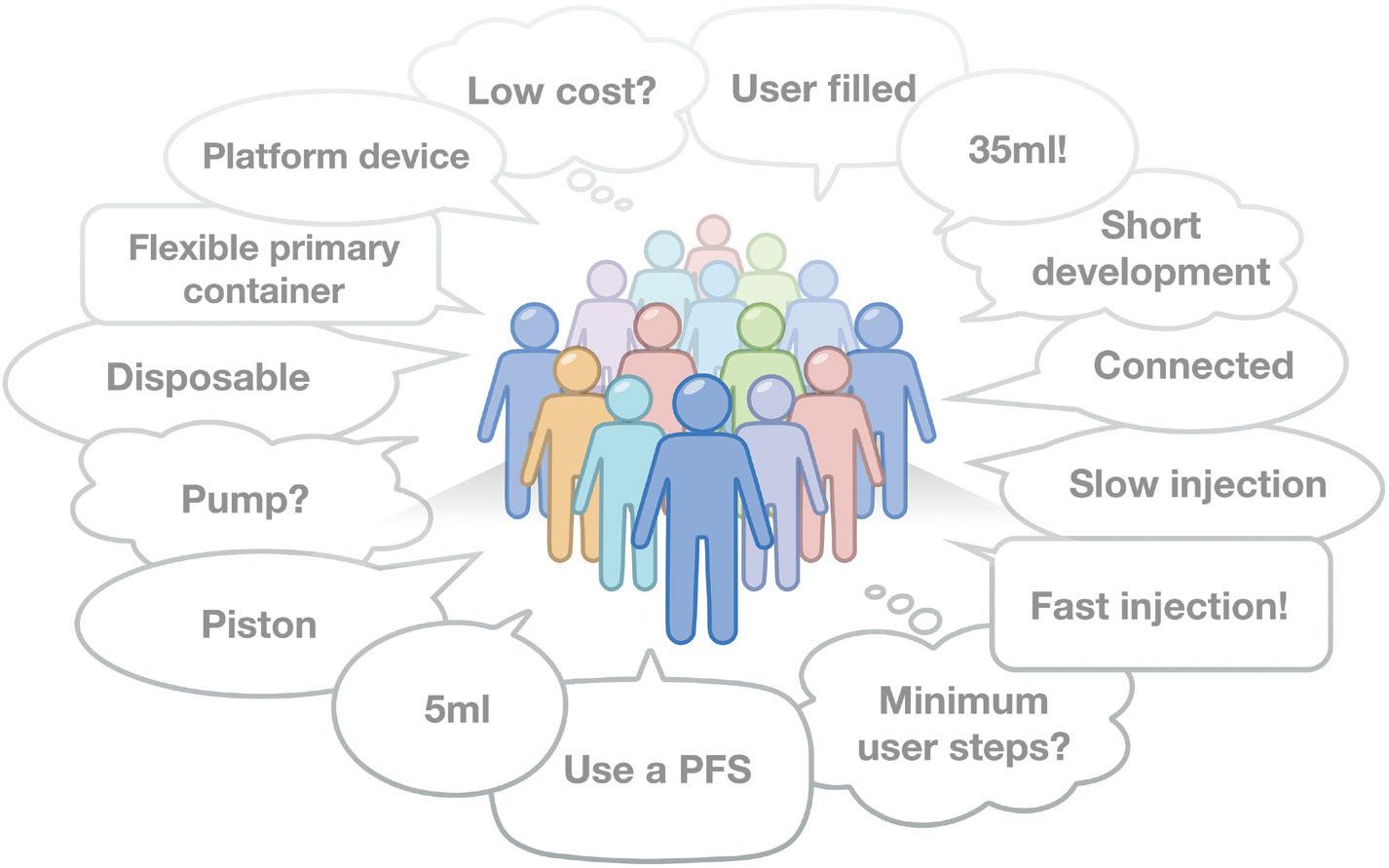

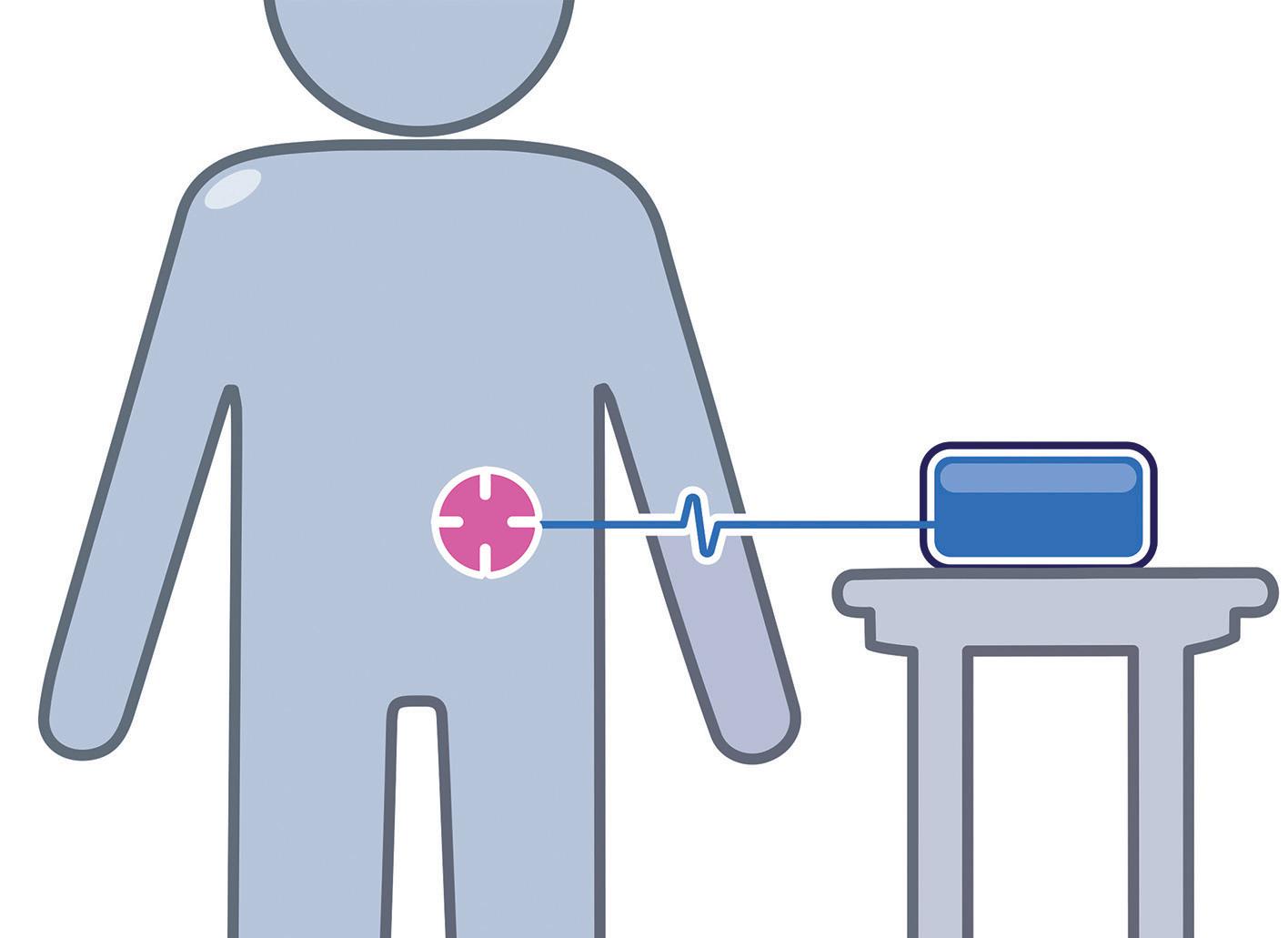
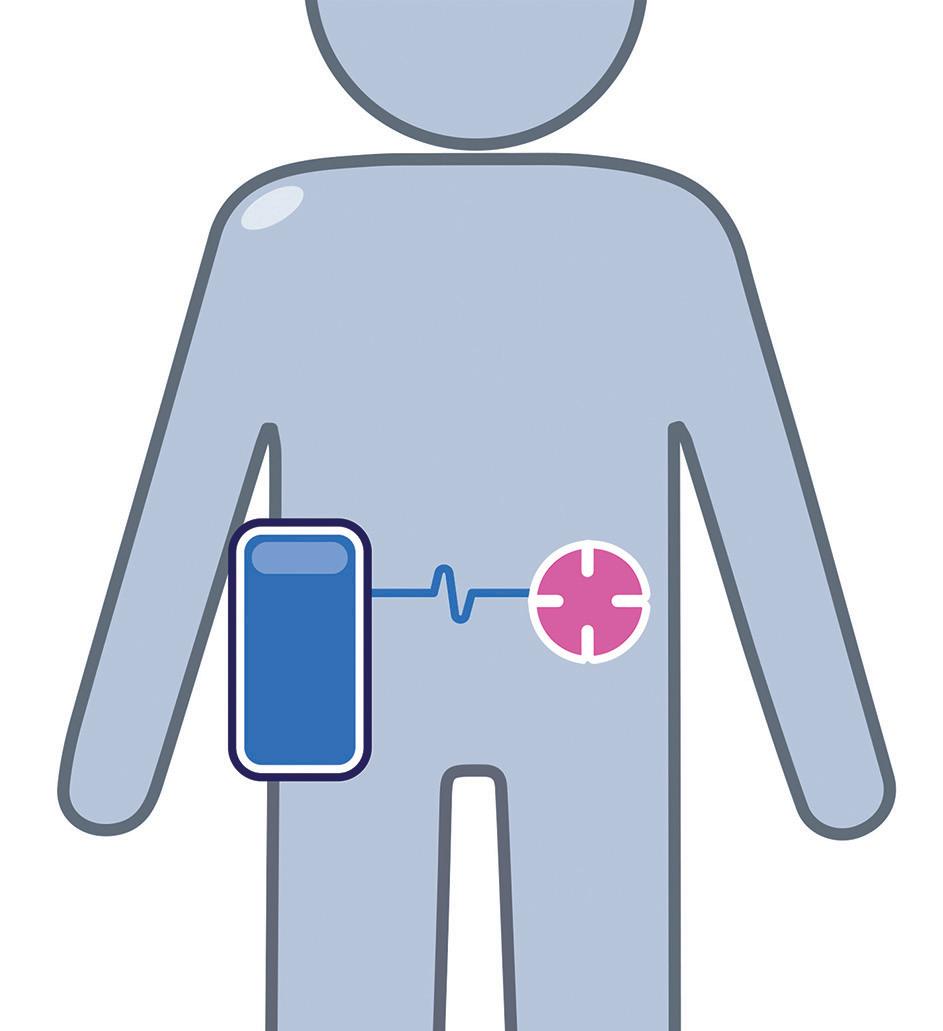
• Fluid path: a body-worn device, even if using a separately connected needle
port, is likely to have a shorter fluid path and therefore lower risk of accidental occlusion. Similarly, a short fluid path requires less system priming and therefore results in less dead volume of drug.
• Portability: some indications may not need to consider the ability for the user to move around during drug delivery, but for others this may be a key requirement or an opportunity for differentiation. This affects both bodyworn and not, whereby if body-worn, the adhered device needs to be resilient to movement and knocks, and where non-body-worn needs to be easy and discrete to carry around (Figure 2).
The past few years have seen rapid growth of the biologics and biosimilars markets. This growth has also seen development of very specific molecules that are
tailored to treat specific diseases, whether they be specific neurological disorders, autoimmune diseases, oncology or other therapeutic areas. With increasingly tailored treatments and regimens, the specific needs for delivery of each drug and each patient can vary subtly or significantly between relatively small markets. While more markets and the existence of more opportunities is exciting, it comes with the challenge of managing return on investment when developing a device for use across multiple “niche” markets.
It is key, therefore, to explore and align on an appropriate development and product strategy based on internal and external commercial and market information early on.
It may be that the appropriate route is to develop a sophisticated modular platform that can be adapted efficiently to address a number of market opportunities (e.g. flexible for various volumes, bodyworn or portable with infusion set, etc.) or, conversely, to develop a very specific embodiment for a focused target. With each approach having particular pros and cons, considering and defining a target market or markets is a key factor in formulating a successful development strategy (Figure 3).
Figure 2. Co-located body-worn, distributed body-worn and distributed non-body-worn options.“This is a young and still emerging and evolving device technology space in which no single format has yet been firmly established as the benchmark.”
A range of socio-economic and industry influences are increasing the number of opportunities for larger volume injection devices but the market “pull” isn’t entirely straightforward at present. However, this is a young and still emerging and evolving device technology space in which no single format has yet been firmly established as the benchmark (unlike pens and autoinjectors, which are much more mature). As a result, there is arguably still significant potential for interesting new concepts and strategies to emerge. The winners in this space will be the
products that find the best balance of the key factors, such as those discussed in this article, for their target market and user populations, and use informed, evidencebased decision making as a foundation for efficient and effective device development.
Founded in 1960, DCA is a leading product design and development consultancy. Its multidisciplinary service offering includes systems engineering, mechanical engineering, industrial design, insight and strategy, UX/UI, human factors, electronics, software and prototyping.
With a range of global pharmaceutical, biotech and device companies amongst its long-standing clients, DCA has deep experience in the field of drug delivery devices. Work undertaken in this area includes design, development, analysis and industrialisation support for injection devices, inhalers, wearables and intranasal devices and applicators, including smart and connected devices. DCA has won multiple major industry awards and contributed to over 1,700 granted patents in the last 10 years. The company’s development service is certified to ISO 9001 and ISO 13485 standards.
Malcolm Boyd is a Senior Sector Manager within DCA’s Medical and Scientific Sector, leading programmes with key strategic clients to explore, design and develop commercially successful healthcare solutions that make a difference in people’s lives. He has over 19 years of experience consulting on product strategy, design and development for major global pharmaceutical and medical device companies. Mr Boyd has led a number of award-winning projects and has over 15 years of specialist experience in development of drug delivery devices. He has extensive experience of leading multidisciplinary project teams, working from early-stage road mapping to detailed design development and industrialisation support. He is passionate about efficient integration of skills to develop world-class products for DCA’s clients.
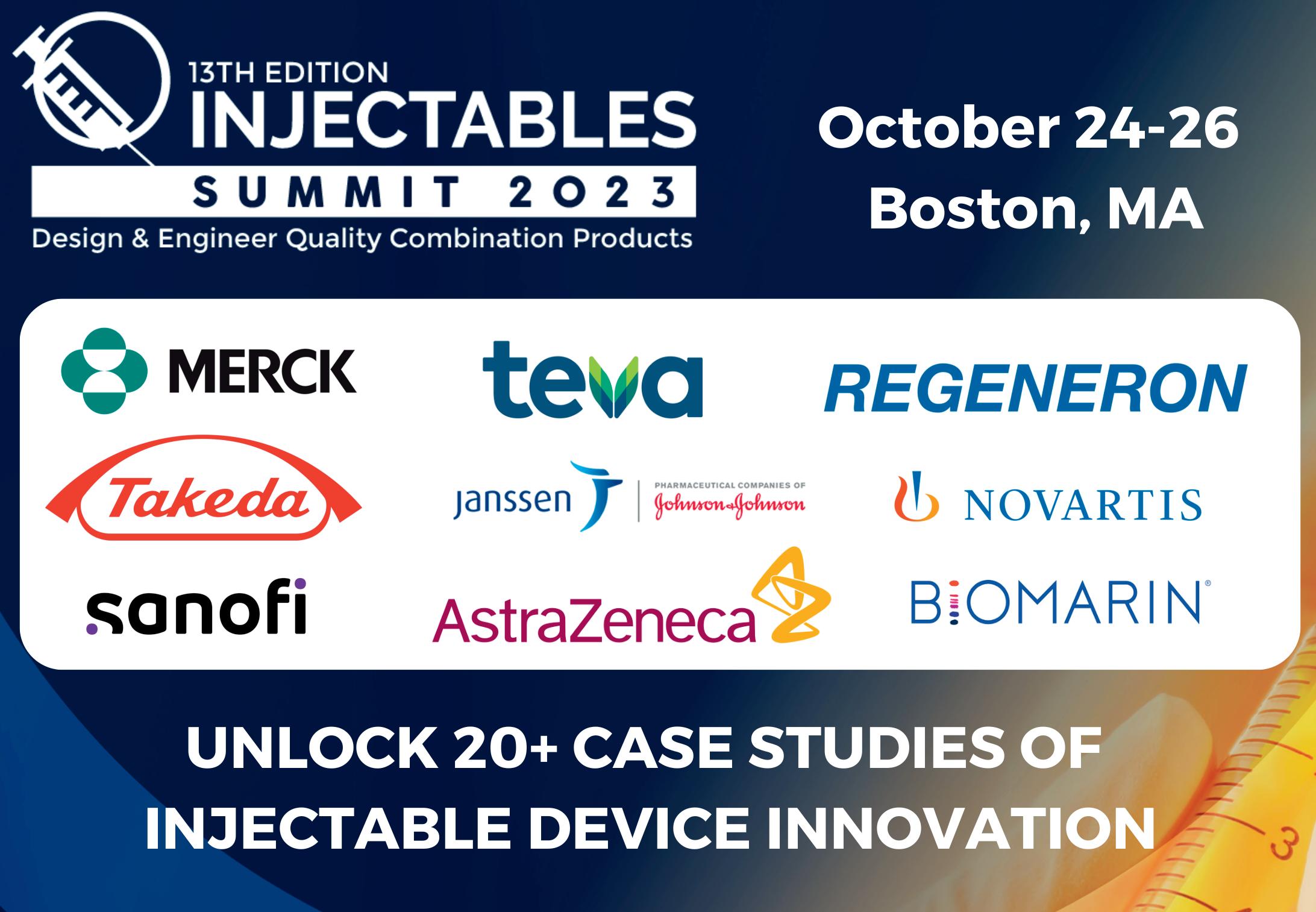
In this article, Beth McBride DiLauri, Director, Portfolio Marketing at BD Medical – Pharmaceutical Systems, summarises the results of a clinical study on the BD Libertas™ Wearable Injector. The results position the device as a viable alternative to traditional intravenous administration.
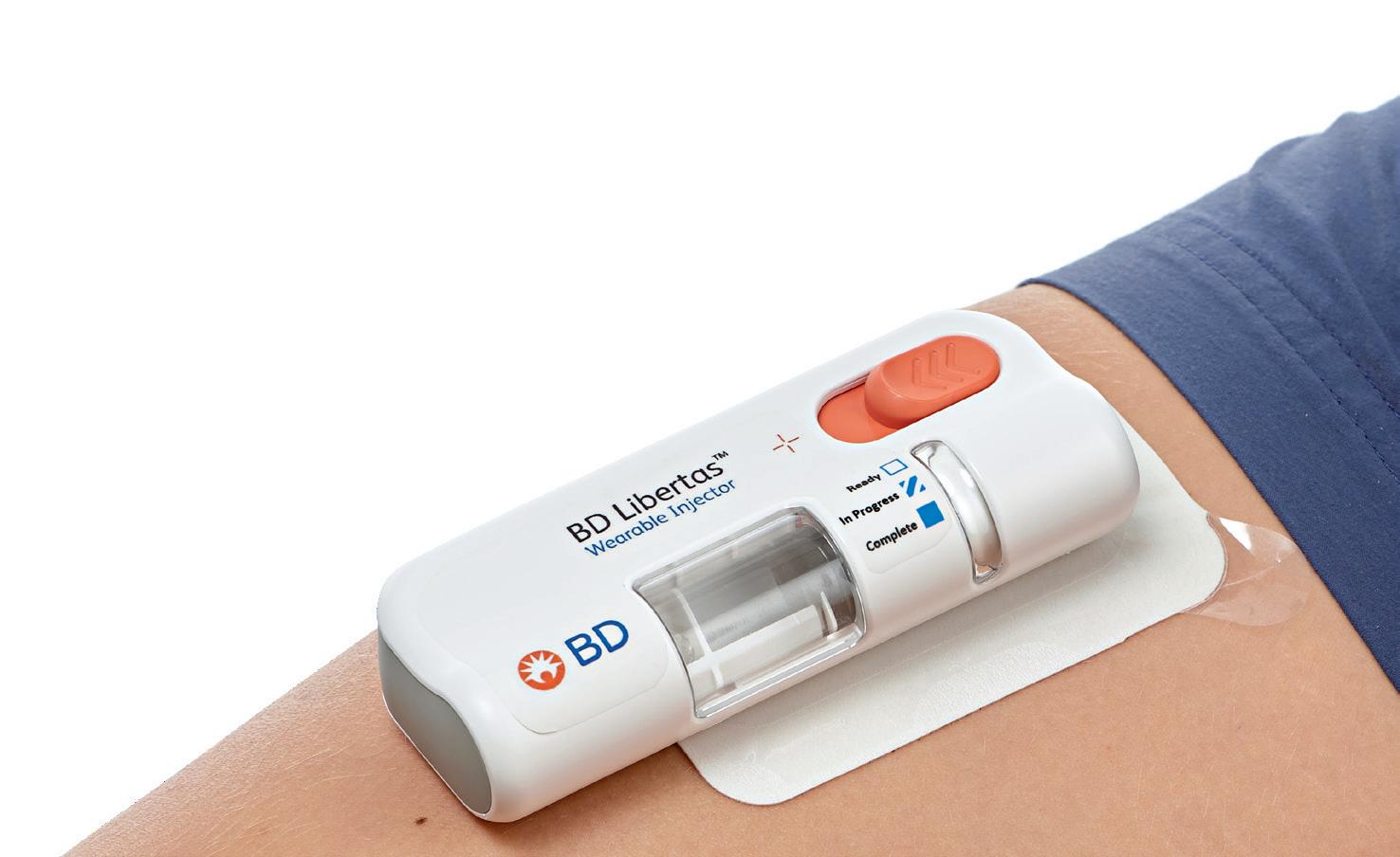
From human factors engineers in the medical affairs organisation to line operators in the company’s manufacturing facilities, everyone at BD recognises that there is a patient at the centre of everything they do.
The BD Medical – Pharmaceutical Systems business regularly conducts a combination of primary market research, human factors studies and clinical research studies to understand the patient experience better. These insights are applied to injection device design and combination product development.
BD is focused on high-growth therapeutic areas, such as obesity and diabetes, as well as other leading chronic diseases. The company
BD recognises that the patient experience can impact adherence and treatment outcomes, as highlighted by the US Association for Healthcare Research and Quality (AHRQ) and other leading organisations.1,2 The BD Libertas Wearable Injector programme is an example of BD’s work to enable the transition of care to new settings by shifting from intravenous (IV) to subcutaneous (SC) delivery.
To de-risk that transition, BD conducted interviews with patients and pharma companies, as well as multiple generative and formative human factors studies in an iterative cycle, to inform usability and the patient experience with a wearable
Beth McBride DiLauri Director, Portfolio Marketing
T: +1 201 847 6538
E: beth_dilauri@bd.com
BD Medical –Pharmaceutical Systems
1 Becton Drive Franklin Lakes New Jersey 07417 United States www.bd.com
the results of which were published in Clinical Translational Science in 2021.3
This study assessed key parameters, including subject tolerability and device acceptability, which can impact the patient experience. Among the findings was confirmation that 100% of subjects were likely to use the BD Libertas Wearable Injector, if prescribed.3 We see this as a leading indicator of positive patient experience and compliance.
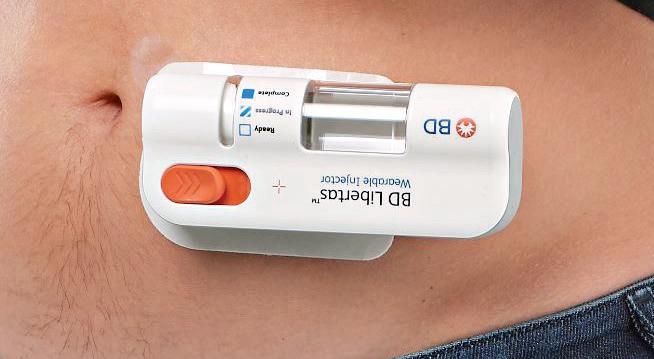
The BD Libertas Wearable Injector (Figure 1) is designed to deliver SC injections of large-volume (2–5 mL or 5–10 mL) and/or high-viscosity (up to 50 cP) fixed-dose complex biologics in home or clinical settings. The 2–5 mL device (Figure 2) was evaluated in an early feasibility clinical study, using a viscous placebo, for its functional performance, tissue effects, pain tolerability and overall acceptability among 52 healthy participants.
The study demonstrated consistent device functionality and acceptability across the study population tested. Reliable targeted delivery was demonstrated by the fact that 98.6% of injections were successfully delivered within the targeted
SC tissue – 93.2% completely SC and 5.4% predominantly SC. When it came to tolerability, the transient injection pain was well tolerated, with rapid resolution. On the safety front, no serious adverse events were reported.
Consistent and reliable functional performance was demonstrated by the study, confirming that 5 mL (±5%) of the placebo bolus was delivered to the SC tissue. Consistent performance was demonstrated across injection sites, gender, age and body mass index (BMI) categories tested, with and without movement during injection. Three BMI categories were tested – normal, overweight and obese – and two age groups, 18–64 years and ≥65 years. There was consistent injection delivery and duration – with a mean of 5.42 minutes. Reliable adhesive and needle actuation/retraction performance was also documented.
Pain and tissue effects reported during the study were transient, with rapid
resolution and broad acceptability. The results showed that ≥94% of participants found the transient pain acceptable at the end of the injection, with 96% reporting the injection site appearance acceptable after receiving all four injections. In addition, ≥92% said the device was comfortable to wear during injection and ≥98% found the adhesive removal acceptable. When it came to the abdomen and thigh injection sites, the 52 study participants found both sites equally acceptable overall – with 25% preferring the abdomen, 26.9% preferring the thigh and 46.2% having no preference (Figure 3).
The key benefits of the BD Libertas Wearable Injector include the fact that the patient does not have to do any filling or assembly of the device. There is also automatic needle insertion and retraction, and the device is fully mechanical – with no software or electronics components. Compared with the IV route, SC administration offers3–5:


• Increased patient autonomy and convenience
• Reduced treatment cost, time and systemic effects
• Self or caregiver administration outside hospitals in new care settings, such as at home.
Added to that, wearable injectors may be capable of delivering wider volume and/or viscosity ranges than other delivery system options currently on the market.
“The study demonstrated consistent device functionality and acceptability across the study population tested.”
In addition to the patient experience, BD also recognises that there are multiple key decision criteria that inform pharma companies’ choices when selecting the optimal device for a given combination product. BD is committed to evolving its capabilities and portfolio to meet pharma companies’ requirements, including supply chain stability, partner agility and sustainability.
BD provides a broad portfolio of parenteral drug delivery systems, including glass and plastic prefillable syringes, safety and shielding systems and advanced drug delivery systems, including pens, autoinjectors and wearable and on-body injectors. The company also offers a wide range of combination product development testing services, leveraging its deep expertise partnering in combination product development.
BD Libertas™ Wearable Injector is a product in development; some statements are forward looking and subject to a variety of risks and uncertainties. BD Libertas Wearable Injector is a device component intended for drug-device combination products and not subject to FDA 510(k) clearance or separate EU CE marked certification.
*Early feasibility clinical study of investigational BD Libertas Wearable Injector evaluated 5 mL, non-Newtonian ~8cP SC placebo injections in 52 healthy
adult subjects of ≥18.5 kg /m2 BMI divided into two age groups (18–64 or ≥65 years) for functionality, tissue effects, subject tolerability and acceptability.
For 125 years, BD has pursued its purpose of advancing the world of health™
The company relentlessly commits to a promising future by developing innovative technologies, services and solutions, helping the healthcare community improve safety and increase efficiency. BD and its 77,000 employees have a passion and commitment to help enhance the safety and efficiency of clinicians’ care delivery process, enable laboratory scientists to accurately detect disease and advance researchers’ capabilities to develop the next generation of diagnostics and therapeutics.
1. “The Consumer Assessment of Healthcare Providers and Systems (CAHPS) Ambulatory Care
Improvement Guide: Practical Strategies for Improving Patient Experience”. AHRQ, May 2017, pp 2–3.
2. Manary MP et al, “The Patient Experience and Health Outcomes”. NEJM, 2013, Vol 368, pp 201–203.
3. Woodley WD et al, “Clinical Evaluation of an Investigational 5 mL Wearable Injector in Healthy Human Subjects”. Clin Transl Sci, 2021, Vol 14(3), pp 859–869.
4. Collins D, Sanchez-Felix M, Badkar A, Mrsny R, “Accelerating the development of novel technologies and tools for the subcutaneous delivery of biotherapeutics”. J Control Release, 2020, Vol 321, pp 475–482.
5. Bittner B, Richter W, Schmidt J, “Subcutaneous administration of biotherapeutics: an overview of current challenges and opportunities”. BioDrugs, 2018, Vol 32(5), pp 425–440.
Beth McBride DiLauri is Director, Portfolio Marketing for BD Medical – Pharmaceutical Systems. Her responsibilities include developing portfolio strategies and leading commercialisation of drug delivery solutions for biologics. Ms McBride DiLauri has dedicated her career at BD to developing and executing portfolio strategies that impact patient care based on deep market and customer insights in pharma/biotech, medical devices, diagnostics and healthcare IT. She spent the early part of her career focused on structuring strategic partnerships, equity investments and acquisitions within BD and at Transcend Therapeutics, an early-stage biotechnology company that went public in 1997. Ms McBride DiLauri received a master’s degree in Business Administration from the Tuck School of Business at Dartmouth College (NH, US) and a bachelor’s degree in Psychology from Boston College (MA, US).
“BD is committed to evolving its capabilities and portfolio to meet pharma companies’ requirements, including supply chain stability, partner agility and sustainability.”


Fostering Collaborations and Reporting on Cutting-Edge Scientific and Business Trends In Drug Delivery
Announcing 2023 Co-Chair and Keynotes


Co-Chair Keynote Keynote Mark Schiebler, PhD Al Sandrock, MD, PhD
Robert Langer, PhD

Roche Voyager Therapeutics MIT



2023 Featured Speakers
Vincent Ling, PhD Ester Caffarel-Salvador, PhD



Ionis Pharmaceuticals Takeda Chiesi USA



20% Discount with Code ONDD20
www.PODDconference.com
Annette Bak, PhD, MBA Lovisa Afzelius, PhD Chelsea Thorn, PhD AstraZeneca Flagship Pioneering Pfizer Sujit Basu, PhDHere, Maike Wolf, Head of Innovation, and Marie Stockton, Marketing Manager, both at Gerresheimer, discuss how sustainability is a fundamental strategic priority for Gerresheimer. They also highlight how eco-design principles have been applied to the development of an on-body injector for subcutaneous delivery of biopharmaceuticals.
Medical devices play a vital role in supporting quality of life for patients by delivering essential therapeutic drugs that manage life-threatening diseases. Ensuring that sustainability is integrated into a device’s design and lifecycle is also crucial for enhancing quality of life across broader communities – and the planet.
The manufacturing, distribution, use and disposal of medical devices have a significant impact on the environment. The need for sustainable practices in the industry has become vital. This is why Gerresheimer has embedded sustainability into its strategic agenda – committing itself to measurable targets.

The company has as its mission to “innovate and deliver for a better life every day”. This mission translates into development of innovative service and product solutions for customers, as
Maike Wolf Head of InnovationMarie Stockton
Marketing Manager

T: +41 062 209 71 00
E: marie.stockton@gerresheimer.com

Gerresheimer Solothurnerstraße 235 CH-4600 Olten Switzerland
www.gerresheimer.com
“The need for sustainable practices in the industry has become vital.”
well as a focus on how the organisation contributes to improved quality of life for patients, employees, communities and the environment.
To address these topics in relation to sustainability, Gerresheimer has introduced a systematic, integrated approach. The strategy is split into three pillars: GxPure, which focuses on climate and water; GxCare, which encompasses employee satisfaction, health and safety and community engagement; and GxCircular, which sets targets regarding sustainable product design, responsible supply chain management and waste management (Figure 1).
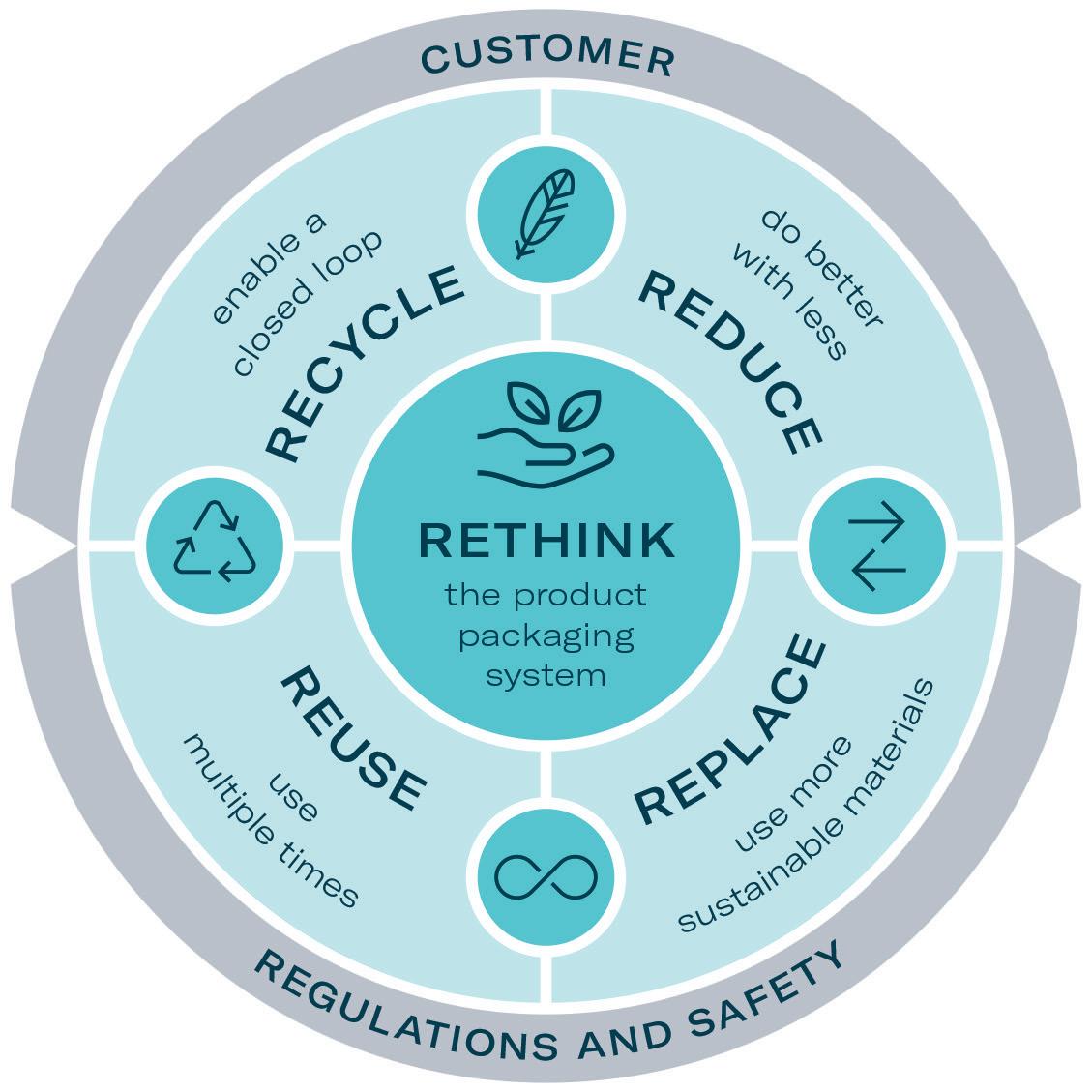
The company is working continuously towards integrating sustainability into process design, product development and decision making. Gerresheimer has defined a set of measurable targets to ensure that the implementation status of the strategy is transparent to internal and external stakeholders. For example, as part of the GxPure pillar, the goal is to reduce Scope 1 and Scope 2 carbon dioxide equivalent (CO2e) emissions by 50% by 2030 (compared with 2019). One main lever to achieve this is to progressively switch to 100% renewable electricity. The company is already on its way to achieving this target, with 35% renewable electricity currently used across its sites.
With these goals and commitments, Gerresheimer contributes to The 2030 Agenda for Sustainable Development adopted by all United Nations (UN) member states in 2015 and the associated Sustainable Development Goals (SDGs). Gerresheimer is also a member of the Alliance for Water Stewardship (AWS) and, in 2021, the company became a member of the UN Global Compact, committing to its 10 principles on human rights, labour, environment and anti-corruption.
In 2022, Gerresheimer was recognised for its ongoing sustainability efforts with a number of awards and successful ratings from independent bodies. Among these was a gold medal from EcoVadis, a leading independent provider of sustainability ratings. This translates to a top 2% score within the industry. Gerresheimer also achieved an A rating from the Carbon Disclosure Project (CDP) and an MSCI environmental, social and governance (ESG) rating of AA in 2022. Even more recently, Gerresheimer signed a commitment to develop a science-based target according to the criteria defined by the Science Based
Targets initiative (SBTi). This means that the company will build on its existing set of climate goals by developing a scope 3 target within the next 24 months.1
Designing for sustainability is a key element of Gerresheimer’s GxCircular strategy. The company has committed to incorporating eco-design principles into all new product development projects from 2023. These activities are linked to the commonly used principles of reduce, reuse, recycle and rethink (Figure 2).
One of the products developed by Gerresheimer following these principles is an on-body injector called Gx SensAir® for subcutaneous delivery of biopharmaceuticals in volumes of up to 10 mL. Right from the project concept stage, two key aims were to optimise the patient experience to support quality of life and to decrease the negative impact on the environment resulting from administration of patient therapy.
Designed as a platform device, the Gx SensAir® responds to the growing pipeline of biopharmaceutical drugs for immunotherapy and to treat conditions such as metabolic disease, which may need to be administered at intervals across several months. It has been designed for at-home use, which eliminates the need for a patient to travel to a healthcare provider for drug administration, thus relieving the burden on the healthcare industry and providing more independence to the patient. With less patient travel, the carbon footprint is also decreased.
Following eco-design principles, the developers sought to increase the lifespan of the device and decrease waste by making it partially reusable, while maintaining critical hygiene standards. Finally, consideration was given to the impact of the required cold storage of biopharmaceuticals and how to minimise the related impact along the value chain.
Patient-oriented, cutting-edge medicine in hospitals is fundamentally accompanied by high energy consumption. In Germany, hospitals are among the sixth-largest energy consumers in the trade, services and commerce sector. As an illustrative example, if the total energy consumption of a hospital is divided by the number of beds,
“Designing for sustainability is a key element of Gerresheimer’s GxCircular strategy.”
the energy consumption represented by one hospital bed is, on average, equivalent to that of four family homes.2
To date, many patients with a wide variety of indications have to endure long and stressful intravenous infusions in a hospital setting to treat their condition. Homecare enables patients to return home as quickly as possible – for example, after a hospital stay – even if they still require certain therapy and care measures due to their illness. Other therapies may not need to be administered in a hospital or other care facility at all, but could be self-administered subcutaneously at home after a single visit to the doctor.
Subcutaneous self-administration has been shown to improve patient quality of life and reduce treatment time. To evaluate patient preference, Gerresheimer conducted a small-scale patient preference study of 40 breast cancer patients in Europe and the US. The results showed that 68% preferred the idea of using an on-body injector versus standard subcutaneous injection and over 70% were in favour of self-administration at home (Figure 3).3
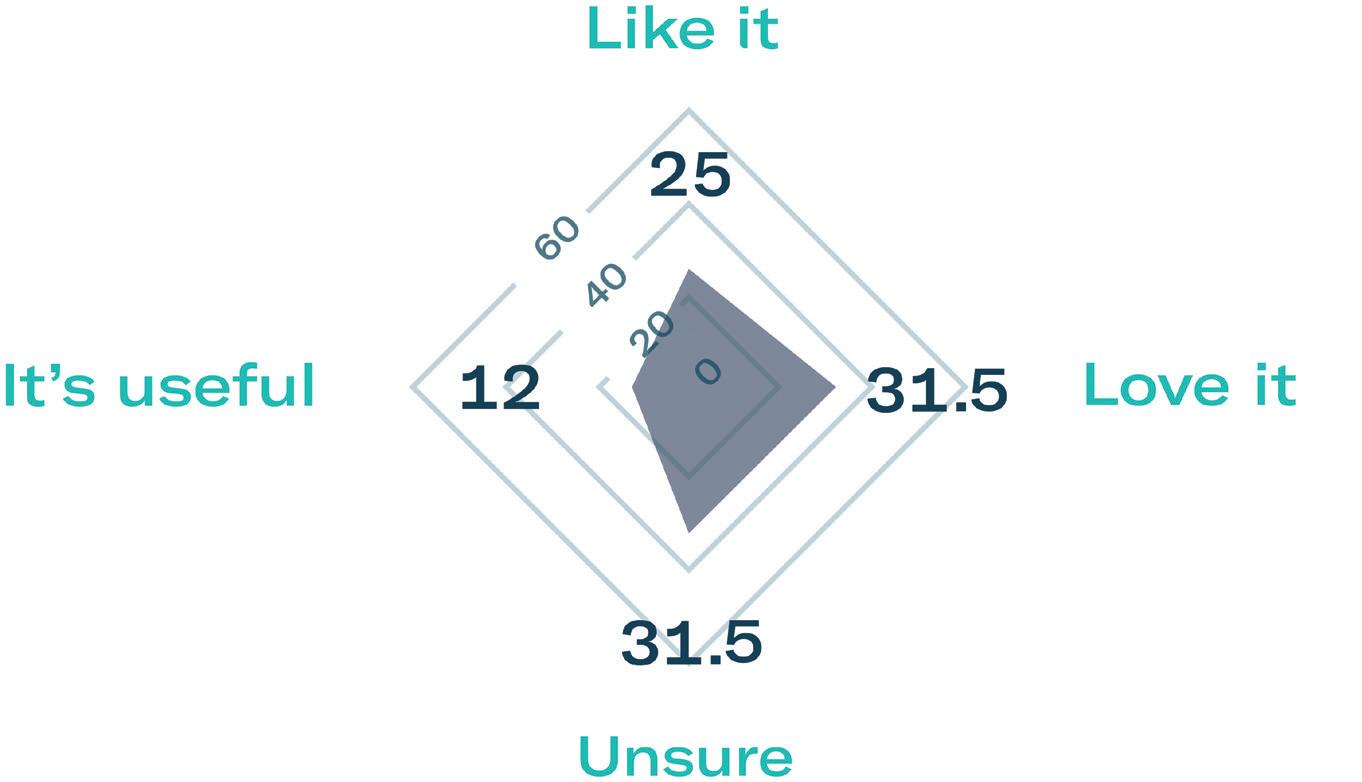
In terms of impact on CO2 footprint, using the example of a 28-year-old Swiss patient suffering from familial hypercholesterolemia since childhood, calculations can be made to determine an approximate decrease in carbon footprint due to at-home therapy administration. With hypercholesterolemia, there is too much cholesterol in the blood, which can cause deposits in the vessels and lead to atherosclerosis-related cardiovascular disease.
By 2025, refractory hypercholesterolemia will be the predominant indication in approximately 4.3 million people.4 Treatment with the fully humanised monoclonal antibody evinacumab has been shown to inhibit lipoprotein lipase and endothelial lipase and would be applied subcutaneously once a month for a period of approximately 17 months.5,6
The average person living in Switzerland generates 14 tons of CO2 per year, according to the myclimate web page. By not travelling to hospital by car for treatment once per month for the 17-month treatment period, the patient
would save 0.208 tons of CO2. If all 4.3 million potential patients worldwide diagnosed with hypercholesterolemia used a self-administration device such as Gx SensAir®, there would be potential savings of an average annual footprint of 30,735 people.
One part of the Gx SensAir® medical device – the reusable module – contains all the electronics and the air pump. The other part – the disposable module – is disposed of after each course of therapy. The disposable module includes the fluidic
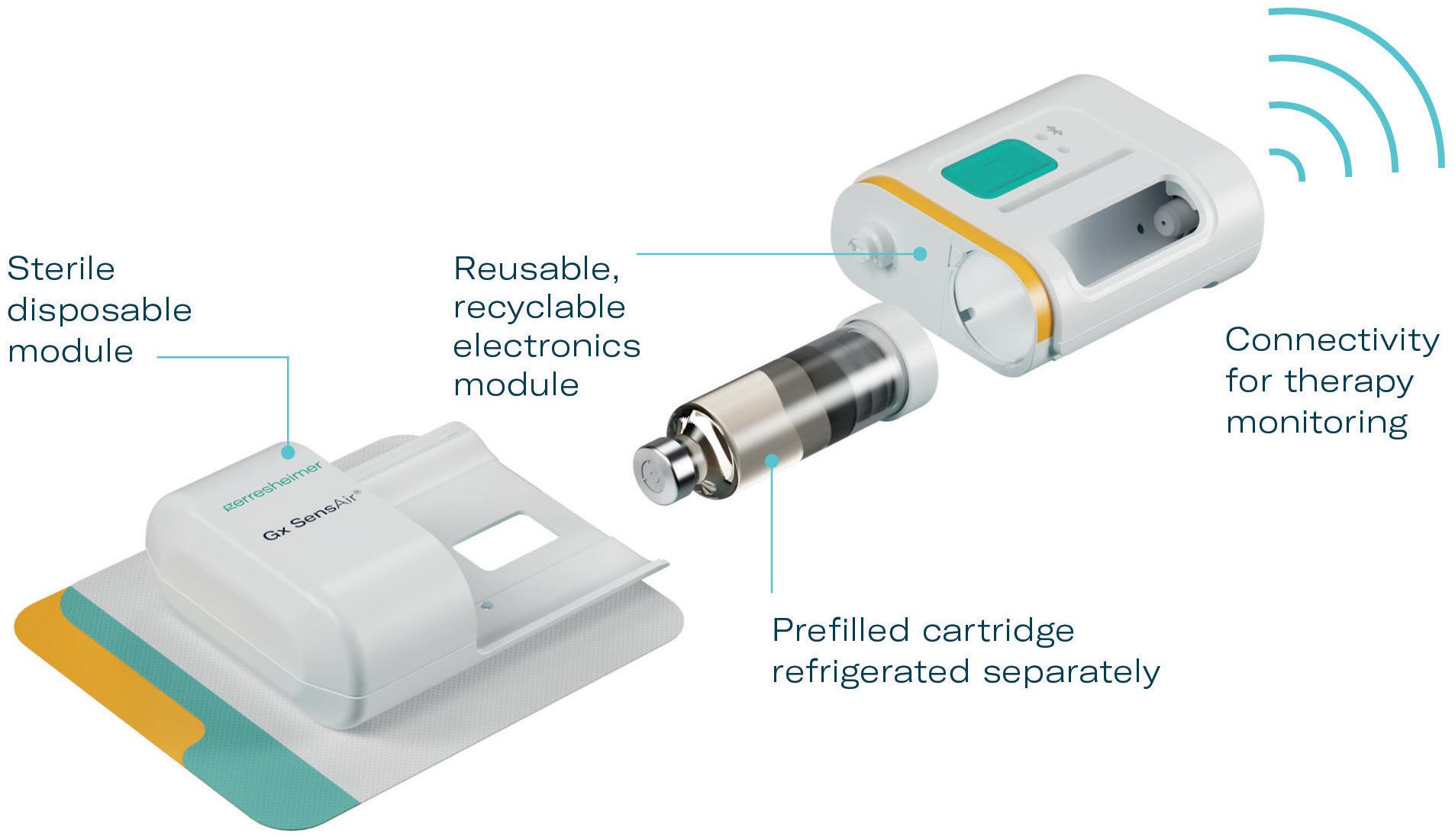
path and needle, which injects the drug automatically. A third element of the design is the primary packaging, in this case, a cartridge that is prefilled with a biologic drug. The cartridge is of standard size with different fill volumes, which avoids additional customisation. The three elements are clicked together by the patient before applying to the body (Figure 4). As the reusable module does not contain a needle, it does not require sterilisation – which reduces energy and water consumption.
The sterilised disposable module, including needle and cartridge, is designed for disposal according to country-specific regulations for waste management of “sharps”. As the device has been designed with minimal materials and without glue or screws, the reusable electronics module can be easily recycled once it has reached the end of its life.
“Subcutaneous self-administration has been shown to improve patient quality of life and reduce treatment time.”Figure 4: Gx SensAir® reusable concept.
In addition to the sustainability aspects of the Gx SensAir®, additional benefits of having a reusable module include those associated with the integration of additional electronics that would not make financial or environmental sense in a single-use device. This includes indicators to show injection progress, occlusion detection, audible signals and automatic needle insertion (Figure 5). All of these features enhance usability and enable at-home administration to limit otherwise unnecessary visits to a healthcare provider. Timing and duration of drug delivery according to therapy needs and drug features, such as viscosity, can also be stipulated for an optimal balance of patient comfort and effective delivery. Additionally, the Gx SensAir® reusable module has Bluetooth connectivity, which can deliver advantages to the patient and valuable data to a healthcare provider, potentially enhancing adherence.
When considering the patient-loading concept that supports sustainability, it was critical to understand the voice of the patient. As the US FDA has said, “Only patients live with their medical conditions and make daily choices regarding their healthcare. Their voices and perspectives are critical to understanding the impact of medical devices.”7 In a usability evaluation for the Gx SensAir®, test subjects who had never previously used an on-body drug delivery device were asked to simulate assembly, drug administration and disassembly. The goal was to observe users and discover any unanticipated use errors, optimise the user experience and foresee misuse.
A few errors were observed and the design was optimised accordingly to further simplify the assembly and usage. Overall user feedback was that the product was “easy to use” and that selfadministration of therapy “can be done before breakfast, half asleep”. Overall, the study showed that the reusable concept, in addition to contributing towards sustainability objectives, was also simple to use for the patient.3
Biopharmaceuticals, such as monoclonal antibodies, require refrigeration, which impacts the entire value chain. In some injectors, where the primary packaging is
already integrated into the delivery device, it is necessary to sterilise, package and cold store the entire device. This increases CO2 emissions throughout the value chain, from manufacturing, to fill-finish, through distribution, to the pharmacy, healthcare provider and, in the case of selfadministration devices, the patient’s own home. With the Gx SensAir®, the patientloading concept means that only the cartridge needs to be refrigerated, which significantly reduces the need for refrigeration space. This corresponds to Gerresheimer’s goals by reducing energy consumption and associated emissions throughout the value chain.
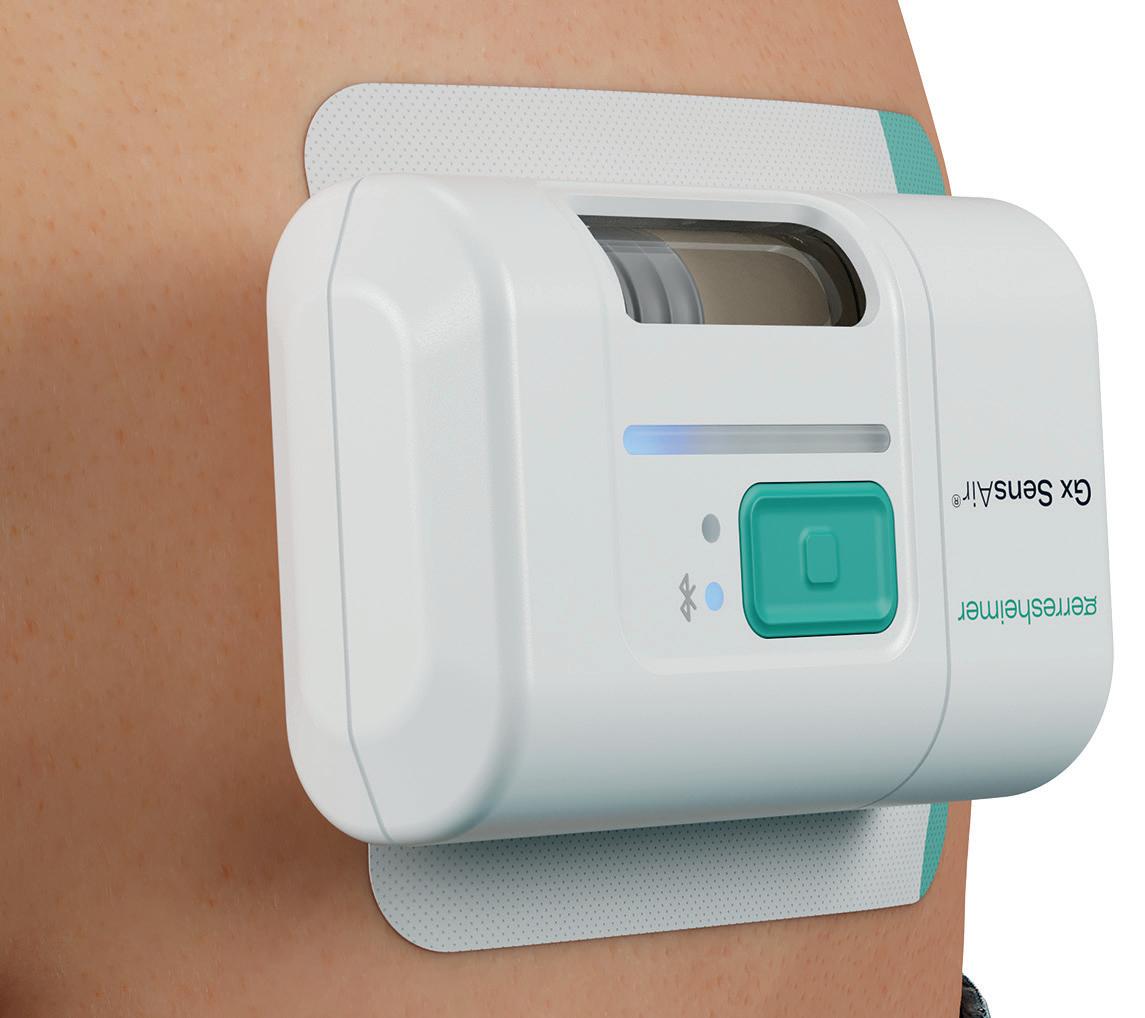
Gerresheimer’s strategic commitment to sustainability and innovation is only part of the story. To be able to fully implement its sustainability goals, collaboration is key. Support from internal stakeholders, external investors, customers and suppliers is needed. When working with suppliers, Gerresheimer assesses compliance with environmental standards and regulations, as stipulated in its supplier code of conduct. All strategic suppliers will be required to acknowledge the code of conduct by 2024.
Gerresheimer also works closely with customers not only to comply with legal requirements and patient usability but also to proactively and systematically integrate eco-design principles into product design throughout the value chain.
With this approach firmly in mind, Gerresheimer aims to combine skills and abilities and create synergies to achieve innovative and integrated solutions that meet customer and patient needs. Providing data and ensuring transparency along the value chain also supports the sustainability efforts of customers.
By embracing sustainability, the medical device industry can mitigate resource depletion, reduce waste generation, maximise energy efficiency and minimise CO2 emissions. Sustainable practices and patient-centric design can be complementary goals, ensuring environmentally responsible solutions that also enhance the patient therapy experience.
Gerresheimer is a global partner for pharmaceutics, biotech, healthcare and cosmetics, with a very broad product range of packaging solutions and drug delivery systems. The company is an innovative
“By embracing sustainability, the medical device industry can mitigate resource depletion, reduce waste generation, maximise energy efficiency and minimise CO2 emissions.”
solution provider from concept to delivery of the end product. Gerresheimer achieves its ambitious goals through a high level of innovative strength, industrial competence and concentration on quality and customer focus. In developing innovative and sustainable solutions, Gerresheimer relies on a comprehensive international network, with numerous innovation and production centres in Europe, the US and Asia. Gerresheimer operates close to its customers worldwide, with around 11,000 employees, and generated annual revenues in 2022 of €1.82 billion (£1.6 billion). With its products and solutions, Gerresheimer plays an essential role in people’s health and wellbeing.
1. Annual Report, Gerresheimer, February 23, 2023.
2. Werner JA (Ed), Struchholz A (Ed), Geuting A (Ed), “Smart Hospital: Digitale und empathische Zukunftsmedizin”, Part III, Chapter 7 (“Smart Hospital und Nachhaltigkeit”), p 163, MWV
Medizinisch Wissenschaftliche Verlagsgesellschaft, 2020. (ISBN: 978-3-95466-495-5)
3. Abedian R, “Patient-Centered Approach to Development of Novel On-Body Drug-Delivery Solutions for Injectable Biologics: A Study with Multiple Target Groups”. PDA Universe of Pre-Filled Syringes & Injection Devices Conference, Palm Springs, CA, US, October 18-19, 2022.
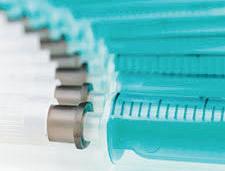
4. “EpiCast Report: Crohn’s Disease - Epidemiology Forecast to 2026”.
Research Report, GlobalData, October 31, 2017.
5. Highlights of Prescribing Information, Package Insert, EVKEEZA™ (evinacumab-dgnb) injection for intravenous use, Regeneron, March 2023.
6. Jeraj N et al, “Treatment of Homozygous Familial Hypercholesterolemia with Evinacumab”. CJC Open, 2022, Vol 4 (3), pp 347-349.
7. “Patient Preference Information (PPI) in Medical Device Decision Making”. Web Page, US FDA, July 3, 2023.

Maike Wolf established Innovation Management at Gerresheimer in 2020 and holds the position of Head of Innovation. She is passionate about the company’s vision of “innovating for a better life” and is committed to building bridges to facilitate development of intelligent, sustainable solutions that contribute to the wellbeing of patients.
Marie Stockton is Marketing Manager in Gerresheimer’s Advanced Technologies division. With extensive experience in the medical device and scientific instrumentation fields, she leads global marketing strategy, planning and execution for the division.
gerresheimer.com
Gx SensAir® on-body injector

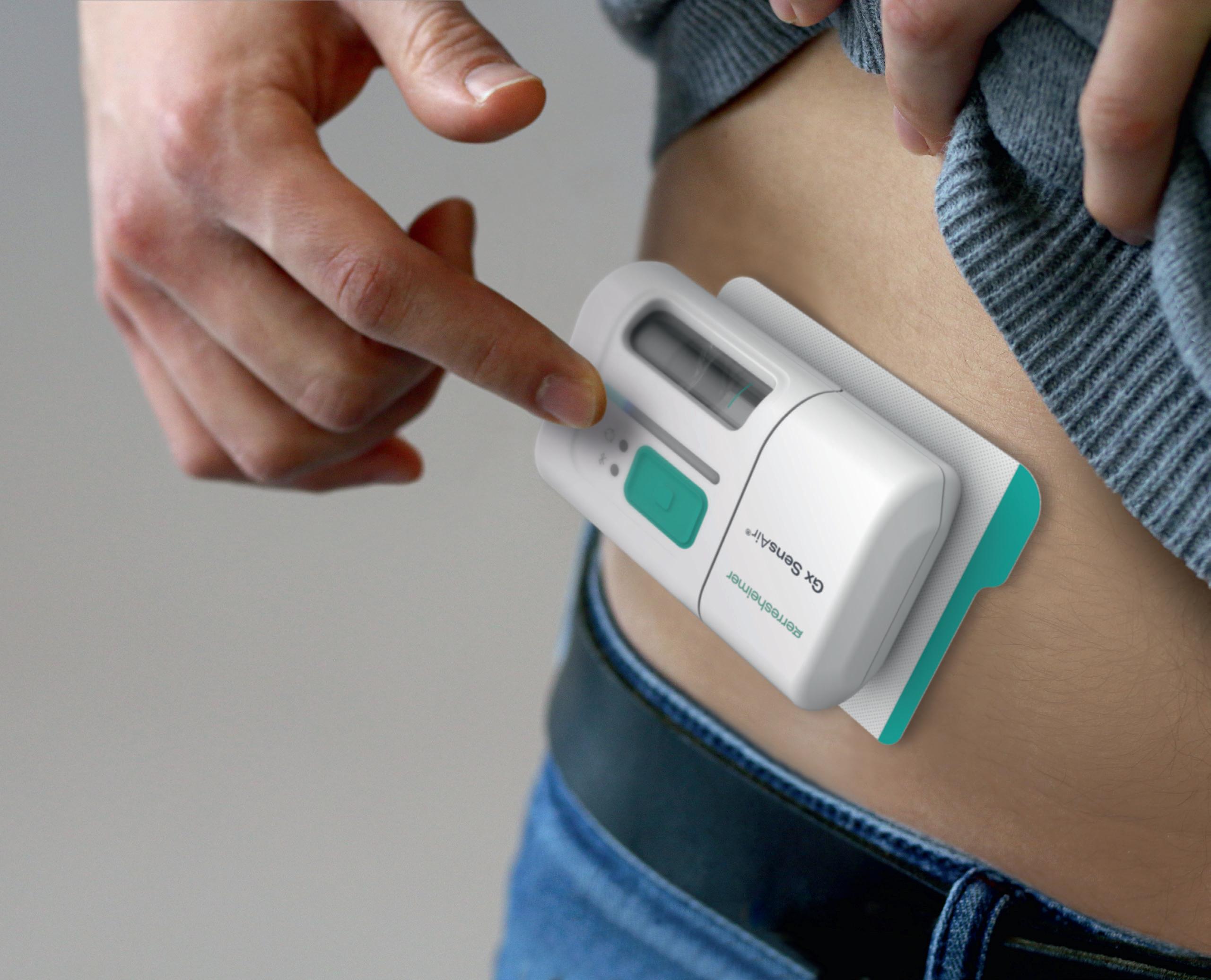
Empowering self-administration of biologic drugs in large volume
Sustainable
Reusable, recyclable electronics module reduces waste
Lower emissions as only the drug cartridge is cold-stored
Patient-centric
— Simple use & automated injection for self-administration
Lightweight so the patient can continue with their day

In this Expert View, Thomas James, Lead Mechanical Engineer at Key Tech, explores how insights from the development of successful in vitro diagnostic instruments can help guide the evolution of wearable injectors.

Self-administered injectable therapies have been improving patient autonomy and reducing the required frequency of clinic visits for years. These therapies, delivered via the subcutaneous route, have historically been delivered in autoinjector, pen injector or accessorised prefilled syringe presentations, with volumes in the 0.2–2.25 mL range. Modern autoinjector platforms are even beginning to boast larger volumes in the region of 5 mL, which can be expected to push the envelope of what is viewed as “possible” in handheld, self-administered drug-device presentations.
As high-dose, high-volume formulations begin to make their way to the forefront of chronic disease management, wearable injectors – or on-body delivery systems (OBDSs) – are increasingly drawing attention as intriguing devices for administering volumes ranging from 10–50 mL. To handle these larger volumes, these OBDSs naturally become larger and more complex than traditional disposable injectors, often with the inclusion of electromechanical elements, such as motors or pumps. As these devices are presented to drug manufacturers, patients and healthcare professionals (HCPs), a natural question arises, “Why do I have to throw this whole thing out?” And, in response, more and more wearable injector development programmes are taking that question to heart, exploring the potential of reusable, durable-and-consumable device architectures.
Long before the patient’s treatment came their diagnosis. The diagnosis process itself was likely performed in a central lab, by an exceedingly complex instrument that took the patient’s sample, mixed it with buffers and reagents, performed controlled thermal steps and agitation processes, and optically, electrochemically or ultrasonically interrogated the resultant analyte to make the test measurement. And after that patient’s sample came
another, and another and another. The complexity of in vitro diagnostic (IVD) instruments requires development of a reusable instrument architecture. And since each diagnostic assay is unique in its workflows and sensitivities, each IVD instrument is a bespoke device. Each requires a robust architecture development process spanning needs assessments and technology feasibility activities through late-stage design, verification and transfer to manufacturing.
As manufacturers explore reusable architectures in OBDSs, insights from successful instruments in the IVD industry can help guide these platforms. Just as with IVD instruments, wearable injector evolution demands thoughtful consideration of usability, complexity, sustainability and functionality to handle high-volume drug administration.
Whether designing IVD devices or OBDS platforms, a clear product definition is an essential prerequisite. That vision comes by way of thorough stakeholder needs assessments – no small undertaking. Although it requires a large upfront investment, having a rigorous understanding of the varied and (almost certainly) conflicting needs of all the system’s stakeholders is truly a luxury once development is underway and allows for efficient decision making and analysis of trade-offs.
Thomas James Lead Mechanical EngineerT:
E:
+1 410 385 0200 tjames@keytechinc.comKey Tech
40 East Cross Street Baltimore MD 21230
United
Stateswww.keytechinc.com
“Wearable injector evolution demands thoughtful consideration of usability, complexity, sustainability and functionality to handle high-volume drug administration.”
It may be tempting to think that a tightly defined, marketable vision only helps to capture the attention of programme sponsors or early supplier partnerships, but it is far more consequential than that. Particularly in reusable architectures, acute points of tension emerge between dispositioning “features” across the durable and the consumable. For example, shifting a subassembly from the durable to consumable may add cost to the consumable but reduce implementation complexity or manufacturing risk in the durable. Alternatively, consider that the durable may have a battery and the computational overhead to support a more complex user interface – but is that part of the vision for the system? Is a more verbose interface a need from patients, HCPs, commercial strategy experts or the regulatory team – or is it simply a case of the design team being “so preoccupied with if they could…”?
In the IVD instrument market, the rationale for reusability is evident, given the significant cost disparity between instruments and cartridges; a classic example of the razorrazorblade costing model. Once IVD chooses reusability, added features like electronic health records integration and a user-friendly interface become a matter of cost and development effort.
The OBDS perspective differs due to the high drug costs, especially in biologics. Given the cost built into consumables by the drug product, the case for a reusable being more cost efficient is diluted. Moreover, therapies with infrequent doses might not generate enough revenue to support a reusable system’s cost.
Sustainability in and of itself may be a compelling justification. However, the dosing frequency again comes into play – a therapy anticipated to be administered only 10 times to a given patient will result in the disposal of one durable item per every 10 doses, on the whole, in the absence of a robust takeback programme. This complicates the sustainability justification when considering the impact of electronics waste streams if material waste is the primary metric. Alternatively, consider the environmental burden of the sterilisation process and the cold chain, both of which are relieved from the burden of carrying the durable element of the OBDS in reusable architectures.
Because of the immense variability in therapeutic regimens, the value proposition of reusable OBDS platforms may lie not in their eventual “break-even” point as IVD systems frequently do, but in value added to patient outcomes. One such value-add may come through the benefits that data collection and transmission could provide; to the HCPs observing compliance, clinical trial facilitators collecting more robust administration data, and manufacturers performing enhanced post-market surveillance. Patient outcomes might also be improved via more accurate dose delivery, reducing injection variability in pharmacokinetics and pharmacodynamics to drive efficacy or by reducing injection duration uncertainty and, thus, improving patient satisfaction and compliance.
Another value-add may lie in the patient’s actual ability to use the device and the acceptability of integrating it into their world. For example, entirely independent of a sustainability lifecycle analysis, a patient’s perception of the device waste could play a significant role in the device preference of that patient between an otherwise equivalent single-use OBDS, driving differentiation in the market.
As touched on above, as the durable of a reusable system increases in complexity and its cost of goods sold sensitivity is relaxed (relative to disposable systems), it can be tempting to add peripheral features that are not central to the product vision.
This is enticing in IVD system development just as it is in reusable OBDS development.
Adding textual displays may seem like a great place to spend the device’s excess processing power, but is it worth the localisation cost of translating each of those screens to the patient’s native language? In a similar vein, Bluetooth or Wi-Fi connection to an optional companion app is often pitched as a mechanism to provide improved product training and troubleshooting resources, without appreciating the wide disparity in digital fluency within the patient population and the additional security and risk management burden associated with digital offerings.
Peripheral automated functions, such as automatic needle insertion and cartridge ejection, should also be considered very carefully – and can often avoid the expense of an additional actuator. There are on-market examples of manually actuated needle insertion mechanisms cleverly hidden in the OBDS’s workflow design. When in doubt, avoid adding additional subsystems and actuation steps, each of which carry their own risk profiles and development burden.
Any OBDS, reusable or single use, must contain a source container, fluid path and fluid motivation subsystem. The source container and fluid path arrangement will almost invariably dictate candidate fluid motivation methods. These, in turn, will be central to the interface specification. As the development programme considers the possibility of an OBDS “platform” to leverage across several product offerings, typically the container and fluid motivation approach must be held constant. In IVD programmes, a next-generation device might have different connectivity features, usability improvements and speed of results, but rarely, if ever, will accept a different sample container or use an alternative fluid motivation method. Similarly, a reusable OBDS platform may have products with different injection speed capability, in-process feedback indicators or volume range, but the type of pump and container are typically set in stone within the platform. It’s worth noting that the fluid motivation portion of the device is typically where most technical risk lives; changing the motivation approach incurs significant new technical risks.
“The value proposition of reusable OBDS platforms may lie not in their eventual “break-even” point as IVD systems frequently do, but in value added to patient outcomes.”
“Shifting a subassembly from the durable to consumable may add cost to the consumable but reduce implementation complexity or manufacturing risk in the durable.”
As soon as the container approach is known, de-risking activities can begin. Container access approach (e.g. with a pierce assembly) is certainly going to be a development challenge, considering workflow and sterility requirements. And among the “standard” containers, such as syringes, cartridges and bags, there are completely different challenges to be tackled. In the cases where the delivery container is patient- or pharmacist-filled, the container filling and installation workflow is going to take a considerable amount of thoughtful design and user feedback. It goes without saying that typical container de-risking activities, such as drug stability, extractables and leachables, biocompatibility, ageing and sterilisation trials, should begin as soon as the container is known. A late-stage container change can be fatal to an otherwise successful development programme.
OBDSs often use an adhesive patch for attachment to areas such as the abdomen or thigh. In reusable designs, this adhesive is single use and part of the consumable. Choosing and assessing its performance can be tricky, so it is important to prioritise an early investigation.
Last, the fluid path and needle assembly typically live in the consumable as they are wetted elements. Depending on the nature of the durable-consumable interface, it may be possible to decouple the fluid path and needle insertion assembly from the durable interface workflow, allowing for focused de-risking of the necessary mechanisms and materials. The fluid path and needle assembly should be reassessed as the product sterilisation plan develops, as it is not uncommon for elastomeric elements to behave in unexpected ways following sterilisation.
Just as an automated pipette or precision syringe pump is the heart of an IVD instrument, so is the fluid motivation subsystem in a reusable OBDS. While there is no shortage of integration and interface definition activities to do in the development programme, the drive mechanism should be assessed extremely early for its ability to achieve any required accuracy targets. The full set of foreseeable delivery conditions (such as the perennially challenging case of viscous drug product delivered while still cold) must be considered.
During these investigations, power consumption should be monitored to aid in building a system power budget and begin battery-scoping activities. Different pump methods will exhibit different sensitivities, but also different strengths. The simplicity of a constant-force actuator is quite attractive, but managing the resultant viscosity-based injection durations tempers its allure. On the other hand, the precise, viscosity agnostic and configurable dosing of an electromechanical syringe pump is compelling, but along with it comes a host of control, power and packaging complexities.
The durable is also where the controller lives – which means that the durable is where the connectivity challenges get solved. Early selection of a wireless communication protocol for data transmission (if applicable to the device) pays dividends down the road. Aside from the wireless communication, the durable typically carries the onus of primary user interface and feedback elements. Early in development, it can be productive to isolate those feedback elements and iterate on them with dedicated, limited functionality prototypes to understand patient expectations around device usage and behaviours.
Finally, a well-formed interface specification is the glue that holds the reusable architecture together. Identifying the functional requirements and constituent connections that must be made (e.g. mechanical, electrical, pneumatic, optical) between the durable and the consumable is essential for ensuring seamless integration and robust performance. A comprehensive interface specification not only details the physical and operational characteristics of each connection but also provides insight into the tolerances, environmental conditions and potential failure modes. Regularly validating and refining this specification throughout the
product development lifecycle can pre-empt many design challenges, thereby ensuring that the durable and consumable components operate in harmony, guaranteeing both safety and reliability for the end user. Proper, thorough documentation, along with iterative testing and feedback, will further ensure that the interface remains adaptive to evolving product requirements and implementations.
The drive towards reusable architectures for appropriate therapies in the OBDS realm mirrors the strides taken by the IVD industry, although with more specific underpinnings of improved sustainability and patient outcomes. The lessons derived from one sector serve as guideposts for another, emphasising the importance of a clear product vision and understanding of the value it aims to deliver, all while addressing the nuanced complexities and challenges inherent in integrating durable and consumable components.
Key Tech is an end-to-end product development firm specialising in the design of complex electromechanical devices and systems for medical applications. The company is 100% employee owned and located in downtown Baltimore (MA, US). It employs 75 engineers and designers focused on transforming complex technologies into simple, intuitive solutions.
Thomas James is a Lead Mechanical Engineer at Key Tech, where he is responsible for both the innovation and development of novel drug preparation and delivery devices. Over his tenure at Key Tech, he has contributed to several in-clinic and in-home infusion and injection systems, from emergency-use, low-cost disposables to highly accurate and flexible advanced-functionality delivery systems. Aside in-the-weeds engineering, Mr James also serves on Key Tech’s business development team, focusing on the pharmaceutical and drug delivery industry. He holds a BS in Mechanical Engineering from the University of Maryland (US).
“A well-formed interface specification is the glue that holds the reusable architecture together.”
In this article, Mehul Desai, PharmD, Vice-President of Medical Affairs, and Daniel Waites, Director of Research and Development, both at Enable Injections, discuss the pros and cons of lyophilisation for biologic injectable drugs, and how Enable Injections’ enFuse device can provide an answer to the challenges of self-injection of large-volume and lyophilised biologics.


Biologics are the mainstay of therapy for a growing number of diseases, as they can provide more effective and targeted treatment than traditional therapies. These drugs are often composed of living organisms or their by-products. The most common format for a biologic drug is a monoclonal antibody (mAb). Biologics, specifically mAbs, can be bioengineered to improve the safety, efficacy, halflife, potency and other characteristics of therapies, which makes them particularly attractive to drug developers.
Since the approval of the first biologic in 1986, the number of biologic drug approvals and submissions has increased steadily. Antibody drugs have taken the spotlight with a steady growth in approvals over the decades in both intravenous (IV) and subcutaneous (SC) formats.1,2 A review
by Strickley and Lambert published in 2021 shows that, of the 136 antibodies identified, 47 were SC (34.5%), 85 were IV (62.5%) and the remainder used other delivery routes (3%).1 The review highlighted that 100 were a liquid solution (73.5%) and 36 were lyophilised (26.5%).
Over a quarter of all mAbs are lyophilised, which is likely due to stability challenges. Similarly, many peptides are also lyophilised due to their high sensitivity to temperature and shear forces. For example, in antibody-drug conjugates (ADCs), the linker is usually a peptide, so in order to minimise the instability associated with the linker, all US FDA-approved ADCs are lyophilised.3 Given the complexity of mAbs and their sensitivity to changes, bioengineering to improve mAb characteristics can often come with physical stability challenges.
mAb drugs are susceptible to conformational changes, protein aggregation and other stability issues. These issues can be caused by changes in temperature, the addition of certain excipients and buffers and other factors. These obstacles are exacerbated when trying to create a highly concentrated format, since protein aggregation is concentration dependent. Trying to develop
Mehul Desai
Vice-President of Medical Affairs
T: +1 513 326 2800
E: mdesai@enableinjections.com
Daniel Waites Director of Research and DevelopmentT: +1 513 326 2800
E: dwaites@enableinjections.com
Enable Injections, Inc 2863 East Sharon Road Cincinnati OH 45241
United States
www.enableinjections.com
“Over a quarter of all mAbs are lyophilised, which is likely due to stability challenges. Similarly, many peptides are also lyophilised due to their high sensitivity to temperature and shear forces.”
a high-concentration, low-volume mAb formulation for SC injection is possible; however, it can be time- and labourintensive, which can delay the clinical trial timeline. If a high-concentration liquid formulation is successfully designed for all characteristics except aggregation, then lyophilisation may be the best approach.4
In addition to its benefits on the formulation process, lyophilisation can also simplify shipping and handling of drugs by eliminating the need for cold chain storage and reducing the weight and volume of the drug. Since lyophilisation removes water from the product, it can also increase the shelf life of drugs as the lack of water creates a challenging environment for microbial growth and chemical reactions. However, while lyophilisation can solve stability issues, it can have negative downstream implications pertaining to patient preference, drug wastage, delivery device selection (if SC delivery is desired) and human risk factors. The need for a diluent for a lyophilised drug adds complexity and the reconstitution process introduces increased time requirements and the potential for human error into the process, which is especially impactful if patient self-administration is the goal. This additional step makes delivering lyophilised drugs with standard syringes and autoinjectors challenging for selfadministration.
This leads manufacturers to options that limit SC delivery volumes (<5 mL), such as complex dual-chamber syringes. Because these dual-chamber syringes use a new storage container for the drug, changing away from the original vial, the developer must go through primary container testing.5
In other words, because the drug is now being stored in the syringe chamber and not in the vial, additional work must be done on the new container, which is cost- and time-intensive.
While lyophilisation of highconcentration formulations is a viable strategy to reduce the risk of aggregation, aggregation risk may also be mitigated by reducing the concentration and increasing the volume of the formulation. Reducing concentration and increasing volume would typically result
in a drug formulation in the 5–25 mL range. There is a common, unsubstantiated belief that volumes this high cannot be administered subcutaneously without a permeation enhancer. However, large-volume SC biologic drugs, such as SC immunoglobulin (25 mL per site on the abdomen), and evolocumab (3.5 mL) were approved and successfully administered for years prior to the introduction of permeation enhancers.
In recent years, multiple large-volume SC drugs have been approved and are successfully administered without a permeation enhancer, including pegcetocoplan (20 mL), ravulizumab (7 mL), rozanolixizumab (3–6 mL), and others still in development. While permeation enhancers may increase absorption, they have not demonstrated a significant impact on bioavailability in prospective human trials.6–15 Delivering these drugs via a syringe, in combination with hyaluronidase, does not allow for patient self-administration and has led to musculoskeletal issues in nurses after repeated administration.16
When considering the large volume of 5–25 mL in the context of patient selfadministration, only two delivery options exist: Enable Injections’ enFuse® or a SC syringe pump. enFuse is the first purely mechanical on-body delivery system with an original container closure and flexible dosing capability and, in a recent study, enFuse demonstrated unanimous patient preference in all surveyed patients versus a SC syringe pump. Patients stated their outstanding preference for the enFuse was due to easeof-use, increased mobility during infusion, reduced setup time and reduced pain at the injection site.17 If lyophilisation is necessary for the structure of the drug, or if the other benefits of lyophilisation are desired, the enFuse has multiple modalities that are designed to enable self-administration of lyophilised large-volume SC biologics.
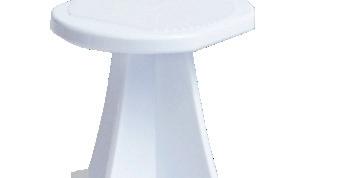
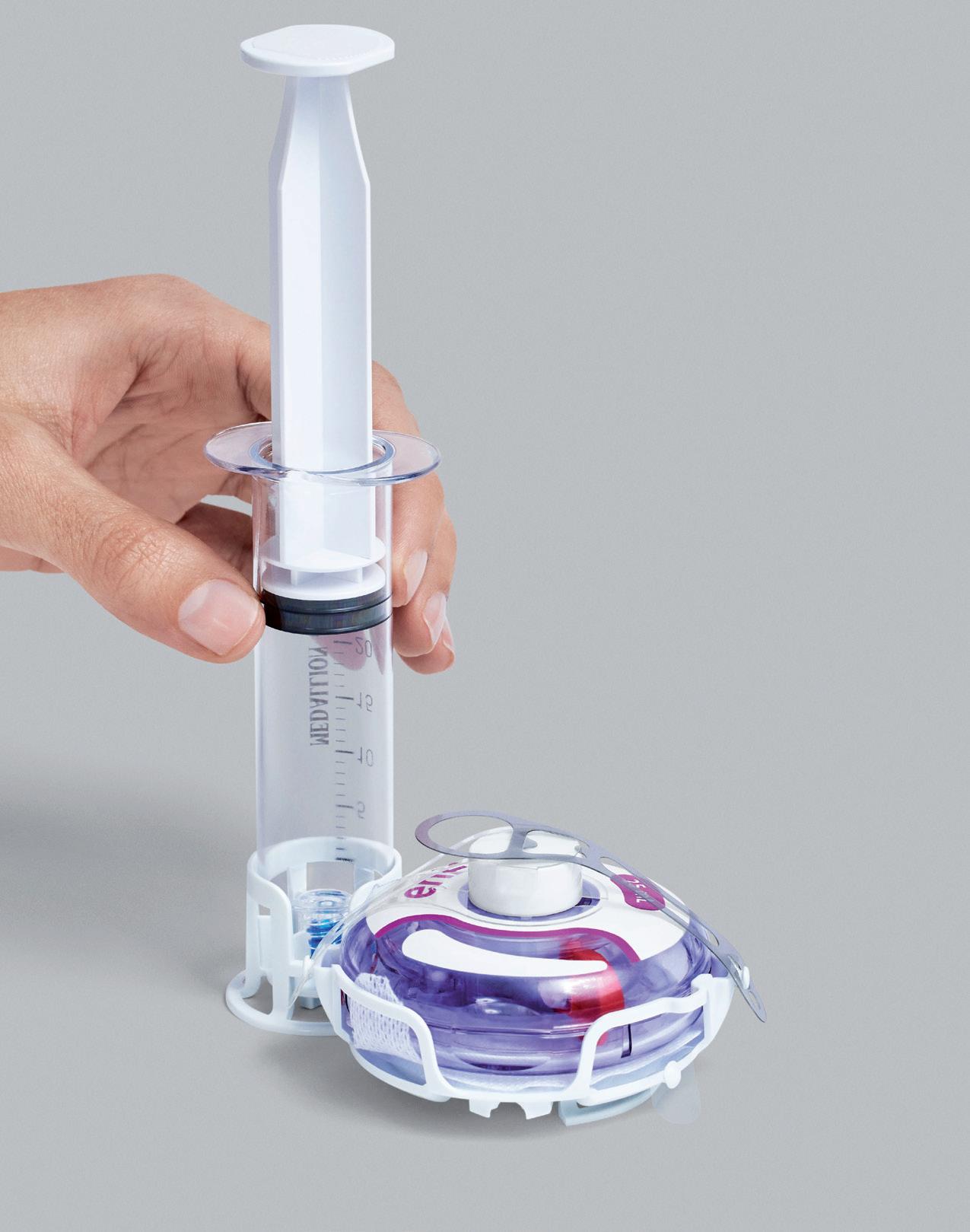
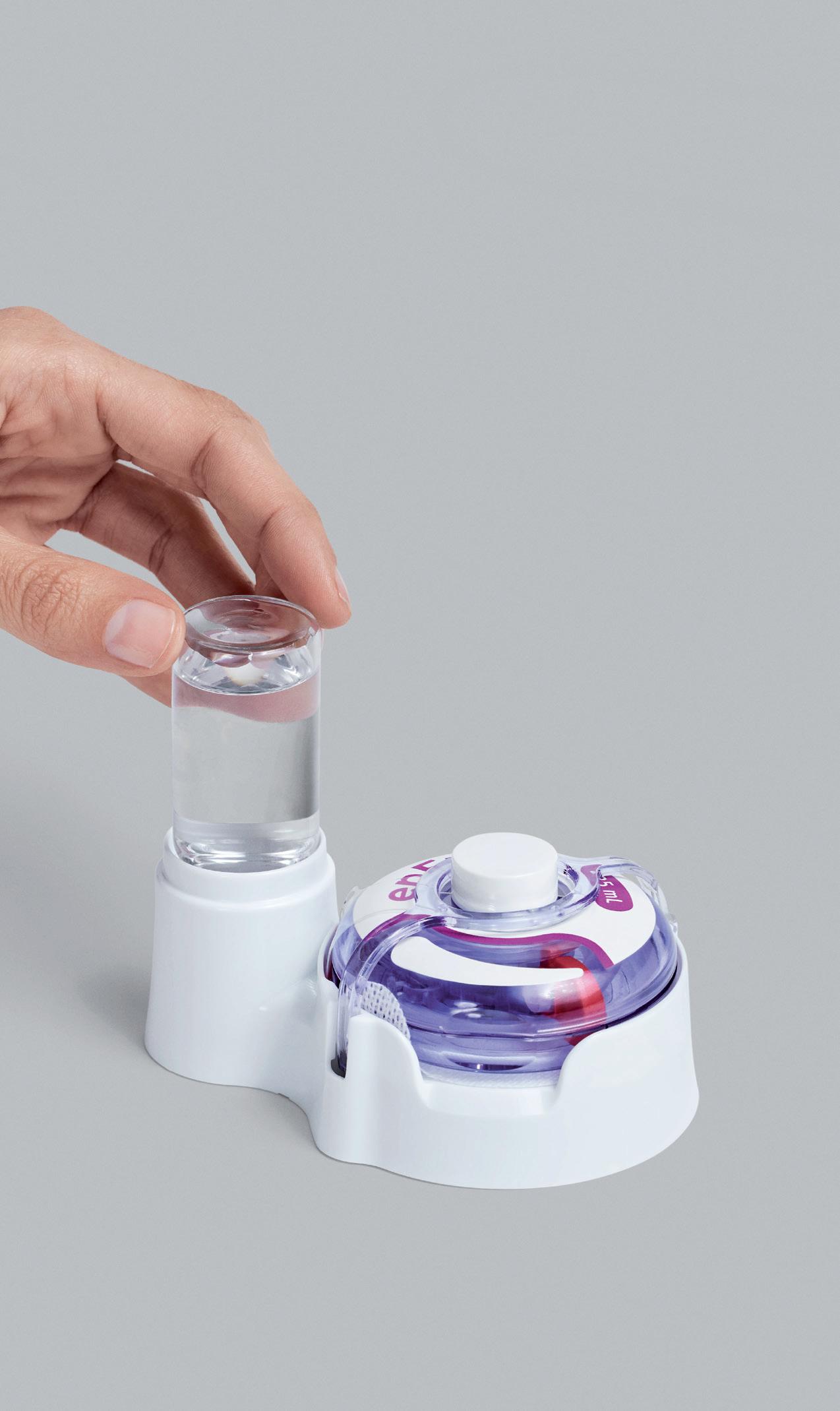
The enFuse system consists of an on-body delivery device coupled to a transfer system, provided to the end user in sterile packaging. The enFuse transfer systems currently consist of a syringe transfer (ST) system (Figure 1) and a vial transfer (VT) system (Figure 2). Additionally, a dual vial transfer (DVT) system is currently in development to support other large-volume SC applications, including lyophilised biologics (Figure 3).
Figure 2: The enFuse® VT system allows the user to insert the vial into the transfer system and the contents to transfer completely without further user input, making it ideal for a range of administration settings, from the clinic to the home.The ST system uses a prefilled syringe or a user-filled syringe to transfer the drug product into the enFuse. The user presses down on the syringe to initiate the transfer. In contrast, the VT system has the user insert a single vial into the system, after which the drug product is automatically transferred into the enFuse. This provides optionality, as manufacturers can choose the system that best suits the needs of their patient population. Both systems can be used for self-administration of lyophilised drug products.
The lyophilised drug product would be reconstituted according to the drug product’s instructions for use. Once reconstituted, the drug product would be transferred to the enFuse using the appropriate system. The ST system is used for drugs reconstituted in a syringe, while the VT system is used for drugs reconstituted in a vial. No changes to the original container closure or additional preparation steps are required aside from insertion into the transfer device.
Leveraging the enFuse system for delivery of SC lyophilised drugs offers several benefits, including ease-of-use, a hidden needle and hands-free delivery, designed to allow patients to perform light-to-moderate activities during injection.
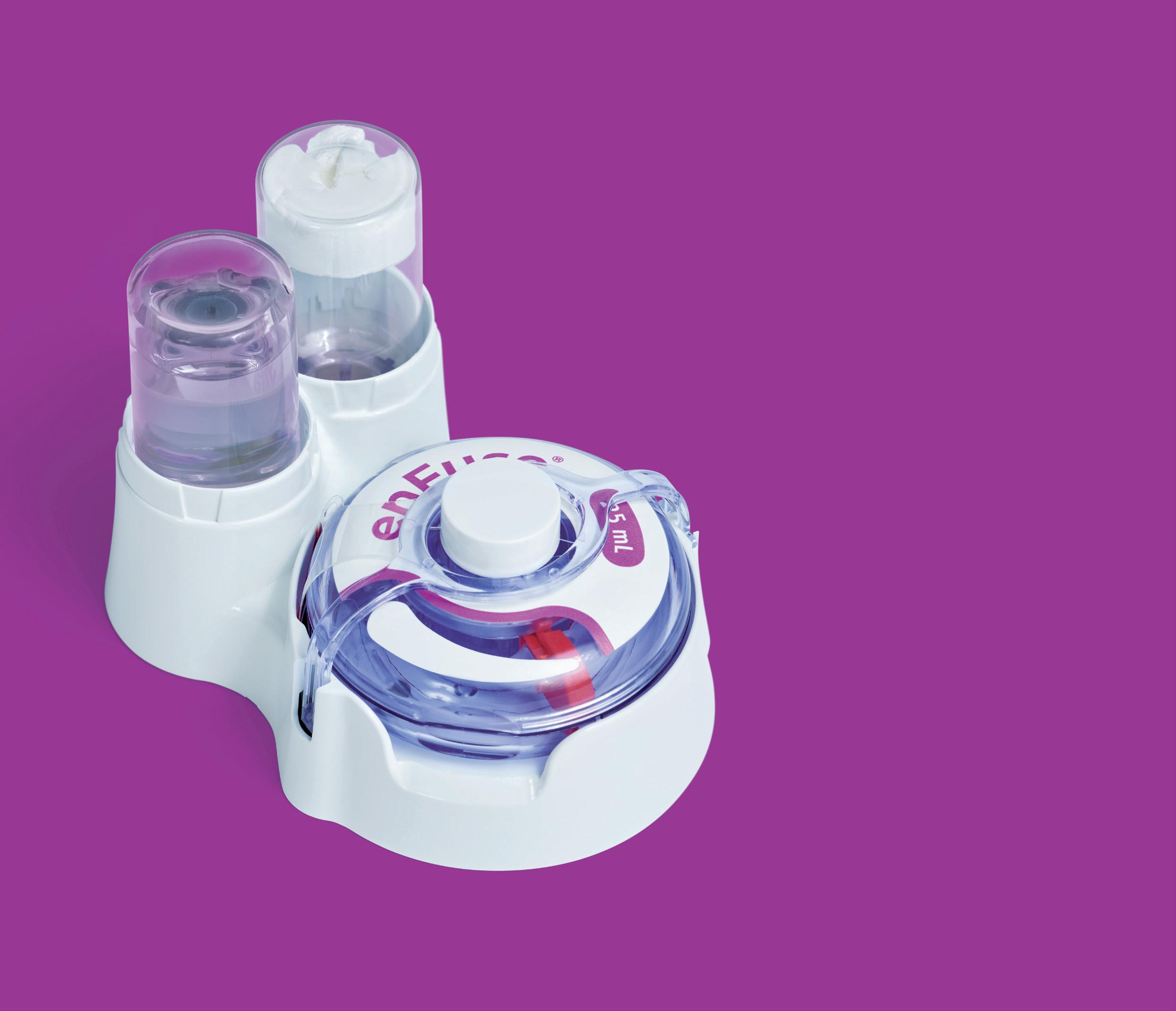
As more and more therapies move away from the clinic to lower cost sites of care (home infusion or self-administration), innovations in drug delivery need to incorporate designs that allow self-
administration at home by the patient. The novel enFuse DVT system focuses on this for lyophilised drug products with large SC drug volumes. The enFuse DVT system is designed to provide a simpler solution to the reconstitution step, which is the largest source of error among patients self-administering lyophilised drugs.18 During the reconstitution step, patients are often confused by the number of steps and supplies, which contributes to instructions for use deviations and sterility breaches.18
The enFuse DVT system is designed to simplify the process, such that the user feels comfortable preparing and administering their own therapies with confidence. The enFuse DVT system incorporates the same philosophy of administration as the enFuse VT system, but includes two vial insertion points, as shown in Figure 3. In the case of a lyophilised drug, one vial slot would include the lyophilised drug product and the other vial slot would include the diluent. Once filling is complete, the user removes the enFuse® delivery device from the transfer base, places it on the abdomen and presses the button to begin SC delivery.
Lyophilised drugs require reconstitution at the time of use, adding additional preparation steps and complexity for the user; however, by using the enFuse DVT system, the process of reconstitution and administration can be simplified.
Enable Injections is a global healthcare innovation company that develops and manufactures drug delivery systems designed to improve the patient experience. Enable’s body-worn enFuse® device delivers high-volume pharmaceutical and biologic therapeutics via SC administration, with the aim of improving convenience, supporting superior outcomes and advancing healthcare system economics.
“The enFuse DVT system is designed to provide a simpler solution to the reconstitution step, which is the largest source of error among patients self-administering lyophilised drugs.”
“Manufacturers can choose the system that best suits the needs of their patient population.”
1. Strickley RG, Lambert WJ, “A review of Formulations of Commercially Available Antibodies”. J Pharm Sci, 2021, Vol 11(7), pp 2590–2608.
2. Sánchez-Félix M et al, “Predicting bioavailability of monoclonal antibodies after subcutaneous administration: Open innovation challenge”. Adv Drug Deliv Rev, 2020, Vol 167, pp 66–77.
3. Cho E et al, “Stability of antibody drug conjugate formulations evaluated using solid-state hydrogen-deuterium exchange mass spectrometry”. J Pharm Sci, 2021, Vol 110(6), pp 2379–2385.
4. Davagnino J, Gabrielson JP, “Developing Lyophilized Formulations for Protein Biopharmaceuticals Containing Salt that Produce Placebos of Corresponding Appearance”. J Pharm Sci, 2022, Vol 111(10), pp 2930–2937.
5. Werk T et al, “New Processes for Freeze-Drying in Dual-Chamber Systems”. PDA J Pharm Sci Technol, 2016, Vol 70(3), pp 191–207.
6. Locke KW, Maneval DC, LaBarre MJ “ENHANZE® drug delivery technology: a novel approach to subcutaneous administration using recombinant human hyaluronidase PH20”. Drug Deliv, 2019, Vol 26(1), pp 98–106.
7. Wasserman RL et al, “Recombinant human hyaluronidase-facilitated subcutaneous infusion of human immunoglobulins for primary
immunodeficiency”. J Allergy Clin Immunol, 2012, Vol 130(4), pp 957–957.
8. Duco MR, Murdock JL, Reeves DJ, “Trastuzumab/Hyaluronidase-oysk: A New Option for Patients With HER2-Positive Breast Cancer”. Ann Pharmacother, 2020, Vol 54(3), pp 254–261.
9. Quartino AL et al, “Population pharmacokinetic and exposureresponse analysis for trastuzumab administered using a subcutaneous “manual syringe” injection or intravenously in women with HER2-positive early breast cancer”. Cancer Chemother Pharmacol, 2016, Vol 77(1), pp 77–88.
10. Hourcade-Potelleret F et al, “Use of a Population Pharmacokinetic Approach for the Clinical Development of a Fixed-Dose Subcutaneous Formulation of Trastuzumab”. CPT Pharmacometrics Syst Pharmacol, 2014, Vol 3(1), e87.
11. Tan AR et al, “Fixed-dose combination of pertuzumab and trastuzumab for subcutaneous injection plus chemotherapy in HER2-positive early breast cancer (FeDeriCa): a randomised, open-label, multicentre, non-inferiority, phase 3 study”. Lancet Oncol, 2021, Vol 22(1), pp 85–97.
12. Luo MM et al, “Exposure-Response and Population Pharmacokinetic Analyses of a Novel Subcutaneous Formulation of Daratumumab Administered to Multiple Myeloma Patients”. J Clin Pharmacol, 2021, Vol 61(5), pp 614–627.
13. Morcos PN et al, “Pharmacokinetics and pharmacodynamics of single subcutaneous doses of tocilizumab administered with or without rHuPH20”. Int J Clin Pharmacol Ther, 2013, Vol 51(7), pp 537–548.
14. Abdallah H et al, “Pharmacokinetic and Pharmacodynamic Analysis of Subcutaneous Tocilizumab in Patients With Rheumatoid Arthritis From 2 Randomized, Controlled Trials: SUMMACTA and BREVACTA”. J Clin Pharmacol, 2017, Vol 57(4), pp 459–468.
15. Dolton MJ et al, “Safety, Tolerability, and Pharmacokinetics of HighVolume Subcutaneous Crenezumab, With and Without Recombinant Human Hyaluronidase in Healthy Volunteers”. Clin Pharmacol Ther, 2021, Vol 110(5), pp 1337–1348.
16. Ammor W et al, “5PSQ-151 Optimisation of the subcutaneous administration of daratumumab”. Eur J Hosp Pharm, 2022, Vol 29(Suppl 1), Article 165.
17. Wasserman RL et al, “Systemic IgG exposure and safety in patients with primary immunodeficiency: a randomized crossover study comparing a novel investigational wearable infusor versus the Crono pump”. Immunotherapy, 2022, Vol 14(16), pp 1315–1328.
18. Franzese C et al, “The burden of at-home preparation of lyophilized parenteral medications: an analysis of contributing factors and implications for chronic disease patients and caregivers”. Expert Opin Drug Deliv, 2019, Vol 16(3), pp 187–198.
Mehul Desai, PharmD, MBA, serves as Vice-President of Medical Affairs at Enable Injections. His experience includes development and execution of tactical plans, driving strategic direction through key opinion leader insights, supporting clinical trial execution and contributing to business development activities across various therapeutic areas. His background includes being the Associate Medical Director for the haematology franchise at argenx. Prior to this, his experience included field medical assignments in rare disease for haematology at argenx, haematology/nephrology at Alexion, and nephrology/neurology at Mallinckrodt Pharmaceuticals. Dr Desai holds a Bachelor’s degree in Biochemistry and Business Foundations from Indiana University (Bloomington, IN, US); a PharmD from Purdue University (West Lafayette, IN, US); and an MBA in Pharmaceutical and Healthcare Business from the University of the Sciences (Philadelphia, PA, US).
Daniel Waites, PE, serves as the Director of Research and Development at Enable Injections, leading the innovative programmes and future development of the enFuse, from reconstitution to connected healthcare. Mr Waites has over 18 years of experience in medical device development and currently supports all due diligence processes and feasibility programmes with potential and current partners. Mr Waites holds a Bachelor’s degree in Mechanical Engineering from the University of Cincinnati (OH, US) and is a licensed professional engineer.
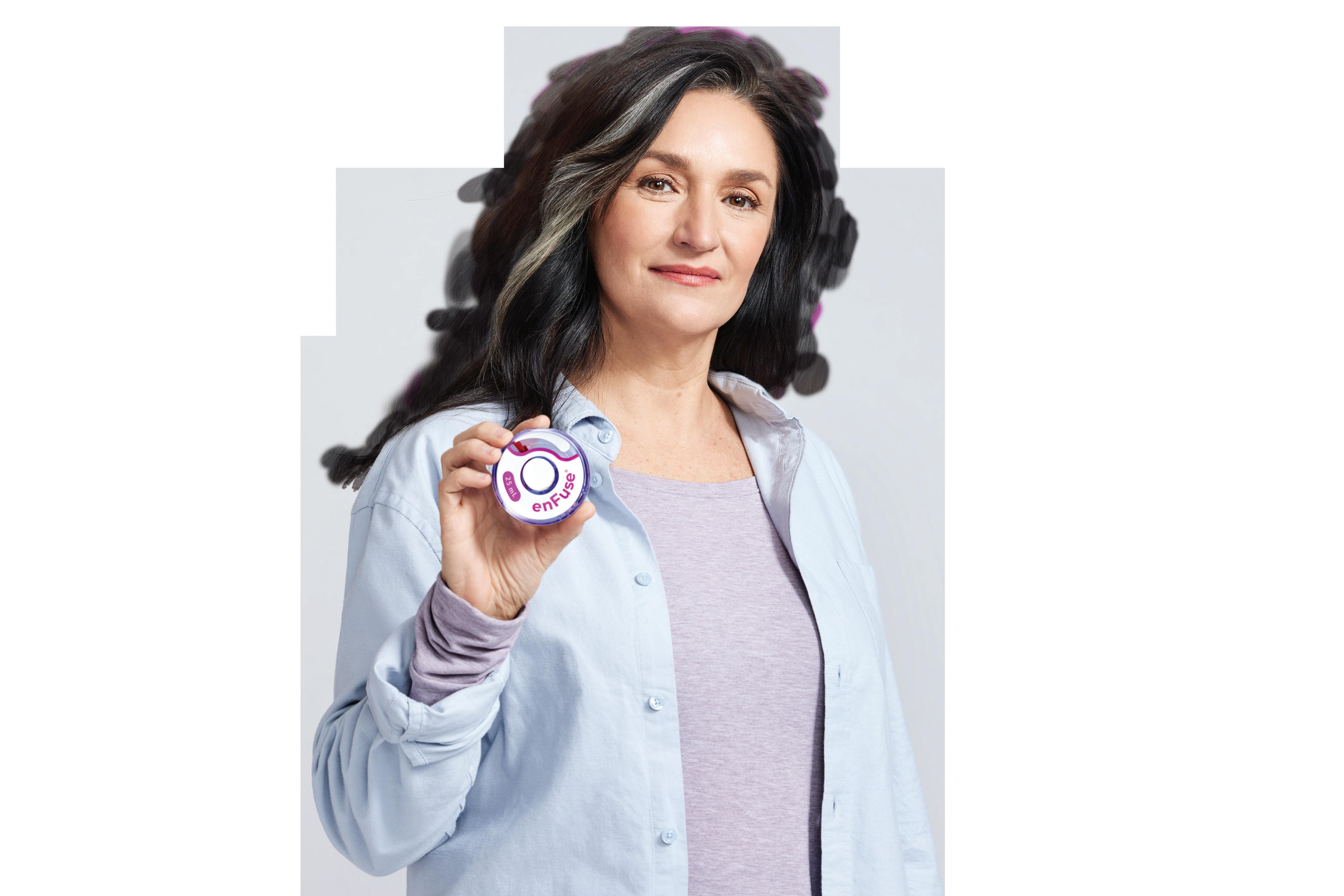
Here, Dave Beckstoffer, Business Development Manager at Portescap, discusses the often overlooked importance of including motion system design considerations from the very earliest stages of wearable injector development, and how doing so can reduce costs, shorten timelines and improve patient outcomes.

Engineering teams developing wearable drug delivery systems have a host of design considerations, so planning the motion solution is commonly not reviewed in the early stages of development. However, motor, gearbox and feedback specifications have far-reaching implications for the overall device design. Involving motion solution development at the outset can lead to a more efficient development programme, as well as a better outcome for the patient.
The motion solution driving a wearable drug delivery system plays a vital role in accurately actuating the injector for effective disease management. This means that, when designing a wearable system, the motion solution must be considered at the outset. Furthermore, motion solution specifications can have a farreaching impact on the overall wearable injector design.
Therefore, it’s crucial to involve motion system considerations as soon as possible within project development (Figure 1). This can help deliver an efficient and timely schedule, both for the engineering team and the pharmaceutical company. Ultimately, this approach will also ensure the best experience for the patient by optimising the usability of the drug delivery system itself.
Whether a design contractor is creating a wearable device for one-toone administration of a single drug, or a manufacturer is designing a system that can inject a range of drugs with differing
viscosities, optimising the speed of the product development stage is paramount. When executed correctly, it will help ensure that the pharma product and device follow the same timeline, while reducing the costs and resources required by the developer. However, to achieve this, accurate and realistic planning is required from the start to avoid unnecessary design iterations and delays.
To achieve the best project outcome, the design of the motor, gearbox and feedback options should be included from the outset. Though a wearable injector will typically be powered by a DC motor (Figure 2), specifying the full motion solution involves an array of options that have implications for each following project stage (Table 1).
When the engineering team begins ideation, the motion designer should ideally be involved in the first phase of development. Even though this creative stage typically introduces various project options, the potential approaches for drug delivery are highly dependent on motion system development. This means that, if the motion solution design is not considered from the outset, subsequent design steps can be impacted, or even constrained, which can result in a compromise that could otherwise be avoided, or else require additional reworks.
“If the motion solution design is not considered from the outset, subsequent design steps can be impacted, or even constrained, which can result in a compromise that could otherwise be avoided, or else require additional reworks.”
Looking in more detail at how motion development impacts ideation, a key aspect in the design consideration of a wearable device is the mode of drug delivery. This includes a decision on the preferred mechanism, such as a syringe plunger or a peristaltic pump, combined with an understanding of the ideal delivery scenario and duration.
To optimise the patient experience accordingly, the overarching criteria for wearable injector design includes size, weight and form factor. The motion solution specification, including its requirement for battery capacity, is crucial to meet these fundamental requirements. Additional considerations before and during therapy, including storage conditions, lifespan and patient usage, may also impact the motion solution selection.
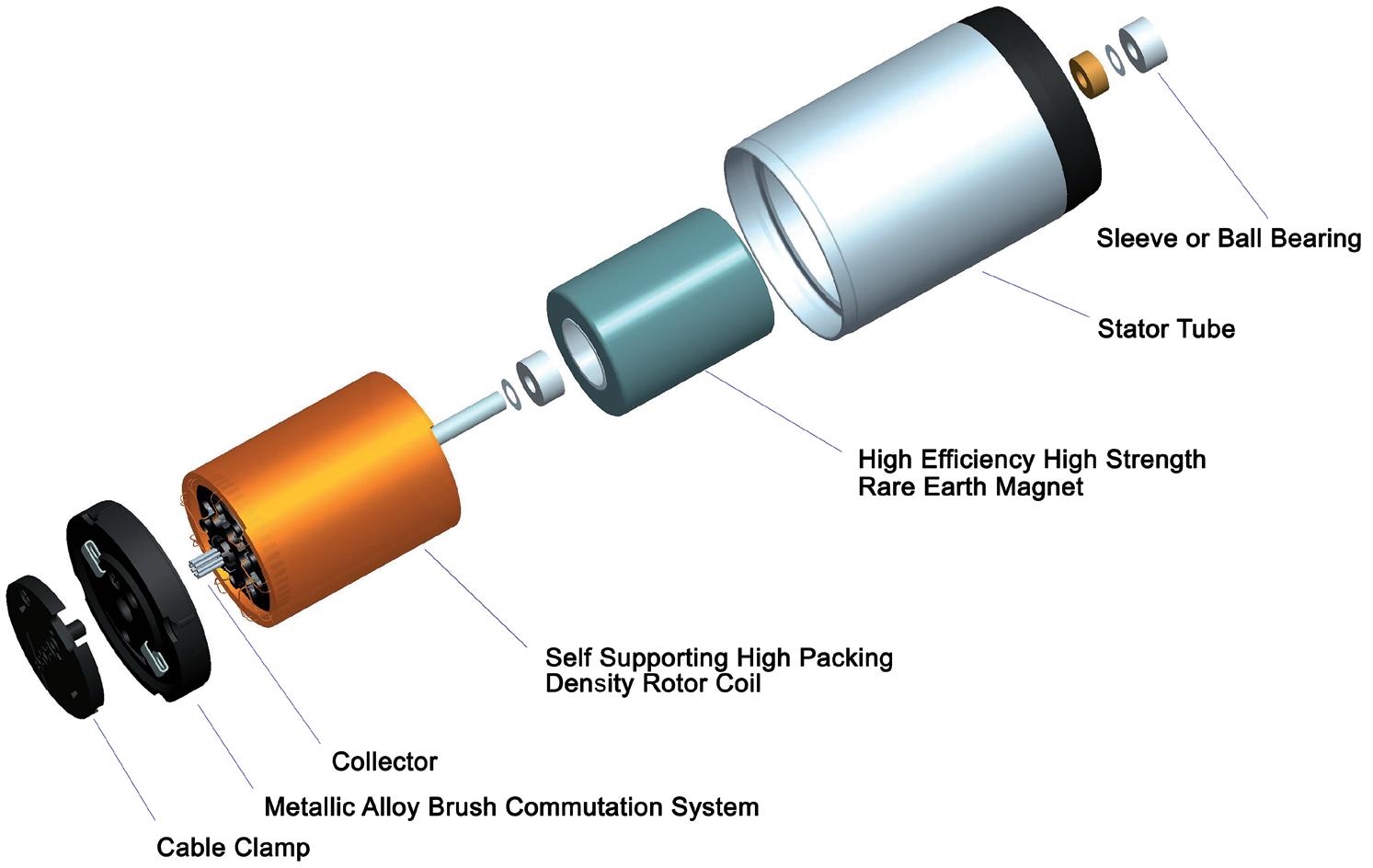
From a drug performance and safety perspective, the level of accuracy required in drug delivery must also be determined at the ideation stage. This can combine the timespan and phases of the injection cycle with the force requirements contingent on drug viscosity. These crucial attributes depend exclusively on the motion solution specification.
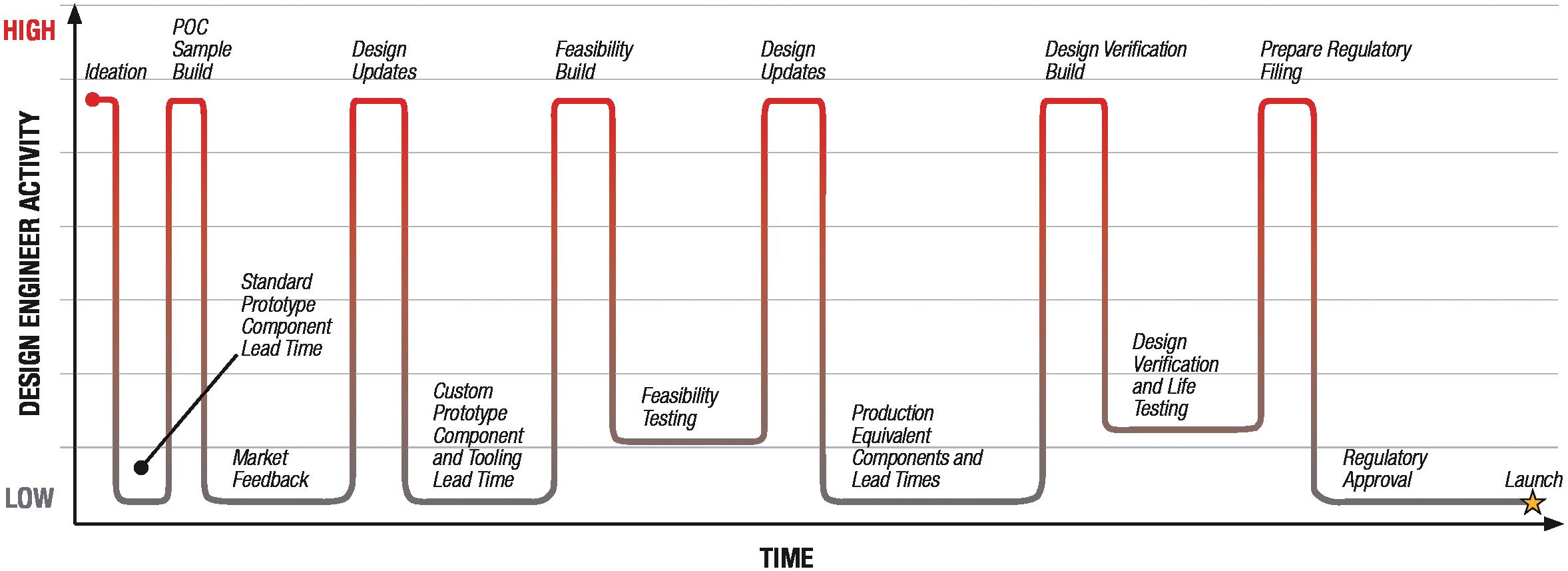
Motion solution considerations could be handled post-ideation, but doing so usually comes at a cost. As a result of the impact that motion specification has on both the wearable injection system’s performance and the overall device, considering motion design at a later stage could impose changes at a more critical time in project delivery.
Figure 2: Exploded view of brush DC coreless motor. Table 1: Benefits of brushed DC coreless technology for wearable injectors.Establishing a realistic project schedule is another reason to include motion solution design during ideation. Considering the extent of design decisions that the choice of motion system has ramifications for, the involvement of a motion designer from the outset, and the experience they bring, will help create a more reliable development pathway. The motion designer’s experience can also be useful for clarifying the number of design iterations realistically required.
Progressing to the concept stage, the objective of the engineering team is to formalise and clarify the proposal to resolve general challenges. Even though this stage is necessarily broad, and more than one proposal for achieving the objective might still be on the table, the design and timescale can be impacted adversely later if fundamental parameters haven’t yet been confirmed.
For motion solution design, when the concept phase is reached, an off-the-shelf motor, gearbox and encoder solution is typically introduced as the initial testbed. However, if the engineering team isn’t sufficiently concentrated on motion requirements during ideation, an oversized specification is normally used. This is based on the rationale of starting with a system that can drive the injector or pump at concept, based on mathematical calculations and prototype parts, and then scaling it down accordingly later in the process to optimise the design. However, it is key at this stage to accurately determine the torque and speed requirements – the fundamental aspects of motion specification.
Equipped with accurate data across each motion cycle, a designer is in a much stronger position to request further enhancements from the motion supplier to meet the overall objectives, such as reduced weight, more compact dimensions or greater energy efficiency. By confirming motion control performance at this stage, the design can build from a foundation that provides a head start and a smoother way towards achieving wider benefits.
The simplest way to determine motion performance requirements for a wearable device is to measure the current in the device as it is running through the different delivery cycles and flow rates. This will give a comprehensive and accurate assessment of the generated torque and duration for each working point. In a syringe drive, for example, there is typically a peak torque requirement as it overcomes friction, followed by torque stabilisation as the drug is delivered. Once the complete drug is delivered, the retraction phase requires a reduced torque level. This motion cycle assessment should be completed for each drug the injector may be required to dispense.
It is also fundamental to optimise motion control performance, particularly when high accuracy is important. The feedback system, and where measurements should be taken, also need to be specified at the concept stage to ensure accuracy.
The feedback point is typically positioned behind the motor – this is nearly always the case with an off-the-shelf motion solution. This means that the feedback device measures the rotational position of the motor as it turns and provides resolution of the rotation generated by the subsequent gearing system. However, with the feedback device located in this pre-motor position, inaccuracies in the position of the lead screw driving the syringe may not be detected. Dependent on priorities, this consideration can inform where the feedback device should be installed, and even whether dual feedback, covering both the motor position and lead screw actuation, might be required.
One advantage of motion development at the concept phase is that these considerations will inform whether an off-the-shelf design can meet project requirements or if a custom solution is needed. Understanding
this requirement before moving into the feasibility stage will save time by reducing the amount of design planning required during later design phases, which are typically more complex and less adaptable, resulting in increased effort being required for any reworks.
Feasibility is the longest stage for any project, with the objective of confirming and fixing the design to make it ready for validation and verification. Often within wearable drug delivery system development, the manufacturer or engineering contractor divides motion feasibility into two separate phases. Broadly speaking, the first phase of feasibility deals with confirming the motion performance specification and its required form factor. The second phase typically involves optimising the user experience, including optimisation of the motion solution within the wearable injection device.
However, when motion design has not been sufficiently involved at a prior stage, these two separate phases of feasibility usually proceed sequentially, rather than in parallel. This results in additional time and cost for design iterations, as well as a longer project timescale overall. In this scenario, the delivery device engineering team usually specifies the motion system, confirms it during the first phase of feasibility, and then approaches the motion supplier.
If, however, the motion specification hasn’t been confirmed with a full prior assessment of the motion cycles, the motion developer has the combined task of optimising both the motion performance and design integration at the same time. As this approach is likely to involve changes to the motor specification and the form factor, just as the wearable injection device
“It is also fundamental to optimise motion control performance, particularly when high accuracy is important.”
engineering team expects to progress to device integration, the project has to take a step back and may require a design iteration of the motion system.
Instead, it is possible to run both phases of feasibility, including motion specification and integration optimisation, in parallel. If the motion solution designer is involved early enough, they can optimise the motion performance and fix the footprint. The form factor and actuation requirements of the drive mechanism then typically do not change significantly during feasibility.
This reiterates why it is crucial to confirm motion requirements, including torque, speed and the profile of the relevant cycles, sufficiently early in the project development. This will help avoid the need for fundamental
design changes at a later stage that will have to be handled while trying to integrate patient optimisation changes.
Fixing the design during feasibility enables the wearable injection system to proceed into the verification and validation stage. With the motion designer involved throughout, the device engineering team can progress to this stage with far greater speed and efficiency. Ultimately, if the motion system is not optimised for delivery of the specific drugs, patient welfare will be impacted. Either an over-specified system will be used, thereby costing more than it needs to, or else it will be less likely to suit the needs of the patient.
Considering the fundamental importance of a motion system to the usability of a wearable drug delivery system, involving a motion designer from the start is the most effective approach.
Portescap, part of Regal Rexnord, offers a broad range of miniature and specialty motor products, including coreless brush DC, brushless DC, stepper can stack, gearheads, digital linear actuators and disc magnet technologies. Its products have served diverse motion control needs in a wide spectrum of applications for more than 70 years, including medical, life sciences, instrumentation, automation, aerospace and commercial.
Dave Beckstoffer is a Business Development Manager in the medical team at Portescap, with over 31 years of experience in the motion control industry. He brings a customer-focused mindset to every application, understanding the tie between the end product features and the motion system design. Mr Beckstoffer is leading the development of drive mechanisms tailored for the specific requirements of infusion systems, marrying motor, gearing and feedback technologies with multiple drug delivery methodologies to achieve the optimum design for each device.
Quote ONdrugDelivery and save $100
PharmaED’s
PharmaED’s Extractables & Leachables Summit, 2023

Ensuring Quality, Safety, Suitability & Regulatory Compliance for Drugs, Biologics and Med Devices

& Regulatory Compliance for Drugs,
Philadelphia, PA
Conference Highlights Include:
April 2023
• Designing and Improving Risk-Based Assessment of E&L Data for Drugs, Biologics, and Medical Devices
• Implementing ISO 10993-17 & ISO 10993-18 Standards
• AETs and Response Factor Variation for E/L Studies
• Uncertainty Factors Reconsidered: Toxicological & Chemistry Perspectives
Featured Speakers Include:
Featured Speakers Include:
• James Norman, FDA
• David Saylor, FDA (on approval)
• Dennis Jenke, Triad Scientific
• Dennis Jenke, Triad Scientific
• Prabhakar Reddy, USP
• Nicole Soucy, Boston Scientific
• Ping Wang, Janssen R&D
• Sherry Parker, SParker Consulting
• Ping Wang, Jannsen Pharmaceutical
• Dujuan Lu, SGS
In this article, Thomas Mayer, Medical Business Unit Manager, Nicolas Bailo, R&D Manager for the Business Unit Medical, and Martin Liniger, R&D Manager for electronics hardware and software, all at Sonceboz, highlight some of the key challenges that mechanical and mechatronic drug delivery systems must overcome when delivering large volumes of biologics subcutaneously and explain the solutions that the company has considered during the development process of the company’s large-volume injector.
“Innovation in delivery technologies and strategies has been catalysed by the identification of unique delivery challenges associated with each class of therapeutic [small molecules, nucleic acids, peptides, proteins, and cells].” — Vargason AM, Anselmo AC, Mitragotri S (2021)1
Sonceboz is dedicated to innovation in the subcutaneous (SC) delivery of biologics, as advocated by the Subcutaneous Drug Development and Delivery Consortium.2
A unique delivery challenge for some biologics, primarily in oncology, neuroscience and rare diseases, is the ability to deliver large fluid volumes (>3 mL); such drugs are typically incompatible with the oral delivery route and require either intravenous (IV) or SC delivery. The extracellular matrix limits the
volume of fluid that can be injected into the SC space. While large bore needles or long infusion times can accomplish high-volume SC deliveries, these are not patient-preferred solutions.
One solution has been to increase the concentration of the therapeutic formulation, thereby exponentially increasing the viscosity. This, too, has issues, including decreasing the chemical and physical stability of the molecule, pain on injection for the patient and a requirement for increased force or administration time.2 Pain at the injection site could reduce patient adherence to treatment.3
The invention of new on-body delivery systems (OBDSs) has been driven by the need to deliver biologic drugs subcutaneously in greater volumes or higher concentrations.4 Some of these OBDSs are powered by electronics, with reason – mechatronic systems are already found in several applications ranging from automotive, medical, aerospace, defence, robotics, manufacturing, instrumentation, Internet of Things and consumer products, and will continue to revolutionise the future (Figure 1).
As a leading provider of mechatronic systems, with over 50 million systems manufactured and shipped across the globe each year, Sonceboz stringently follows
Thomas Mayer
Medical Business Unit Manager
E: thomas.mayer@sonceboz.com
Nicolas Bailo
R&D Manager for the Business Unit Medical
E: nicolas.bailo@sonceboz.com
Martin Liniger
R&D Manager for electronics hardware and software
E: martin.liniger@sonceboz.com
Sonceboz SA
Rue Rosselet-Challandes 5 2605 Sonceboz-Sombeval Switzerland
www.sonceboz.com
“While large bore needles or long infusion times can accomplish highvolume SC deliveries, these are not patientpreferred solutions.”
design-for-manufacturing principles, ensuring Swiss quality for its customers in the medical and automotive industries (Figure 2). Regarding novel drug delivery systems, the company takes great care and time identifying the SC delivery challenges of biologics with mechatronic wearables. This article explains some of the identified challenges and the solutions a mechatronic OBDS could offer.
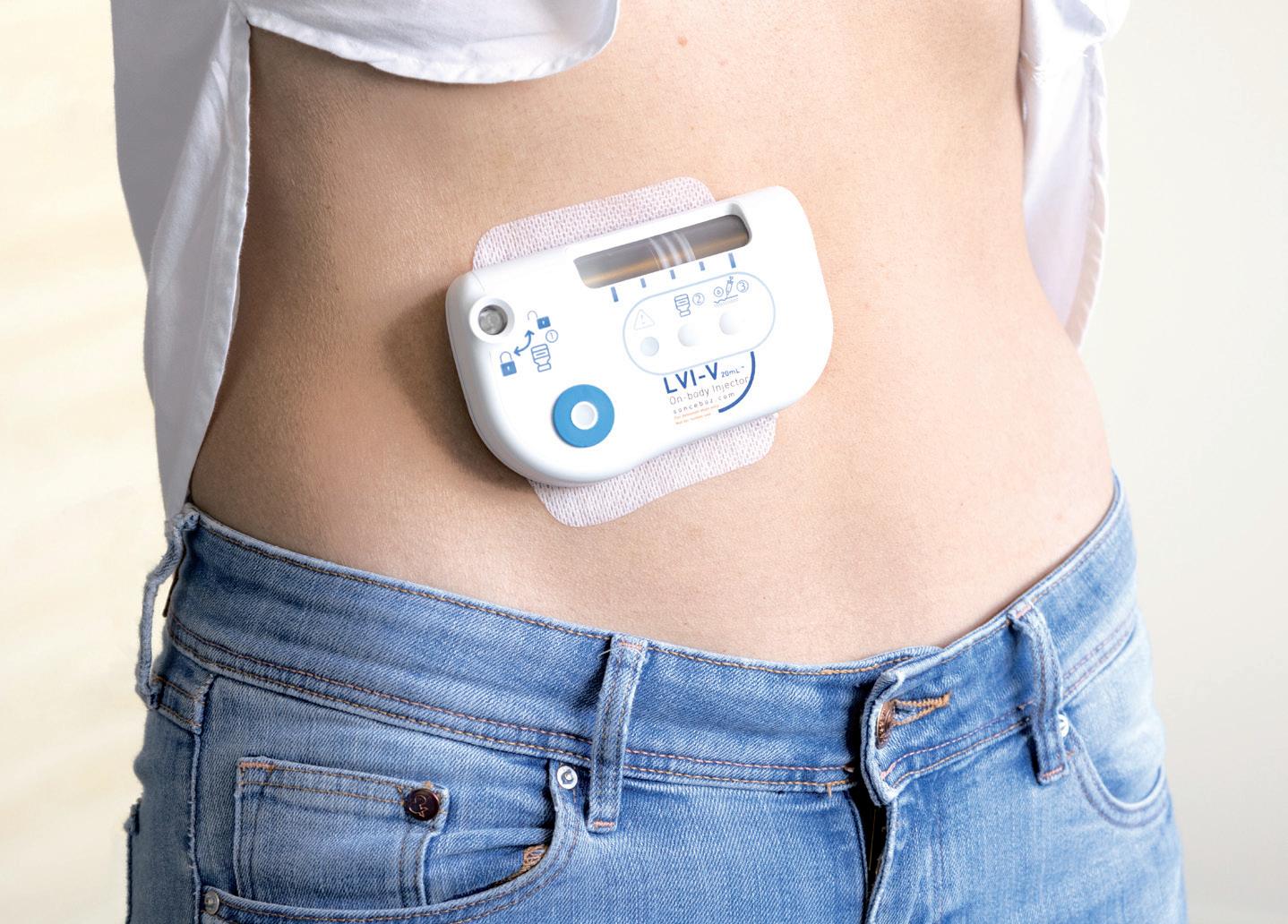
Starting with a general overview of how pump infusion systems work: fluids are transferred from the device into the patient through a pump. That pump requires an energy source that can be mechanical or electromechanical (electronic).
In simple terms, a mechanical pump requires the movement of a structure – an actuation device – to actuate the flow of liquid. That mechanical structure can be a spring, balloon, pressurised vapour, etc. Consider how energy is transferred
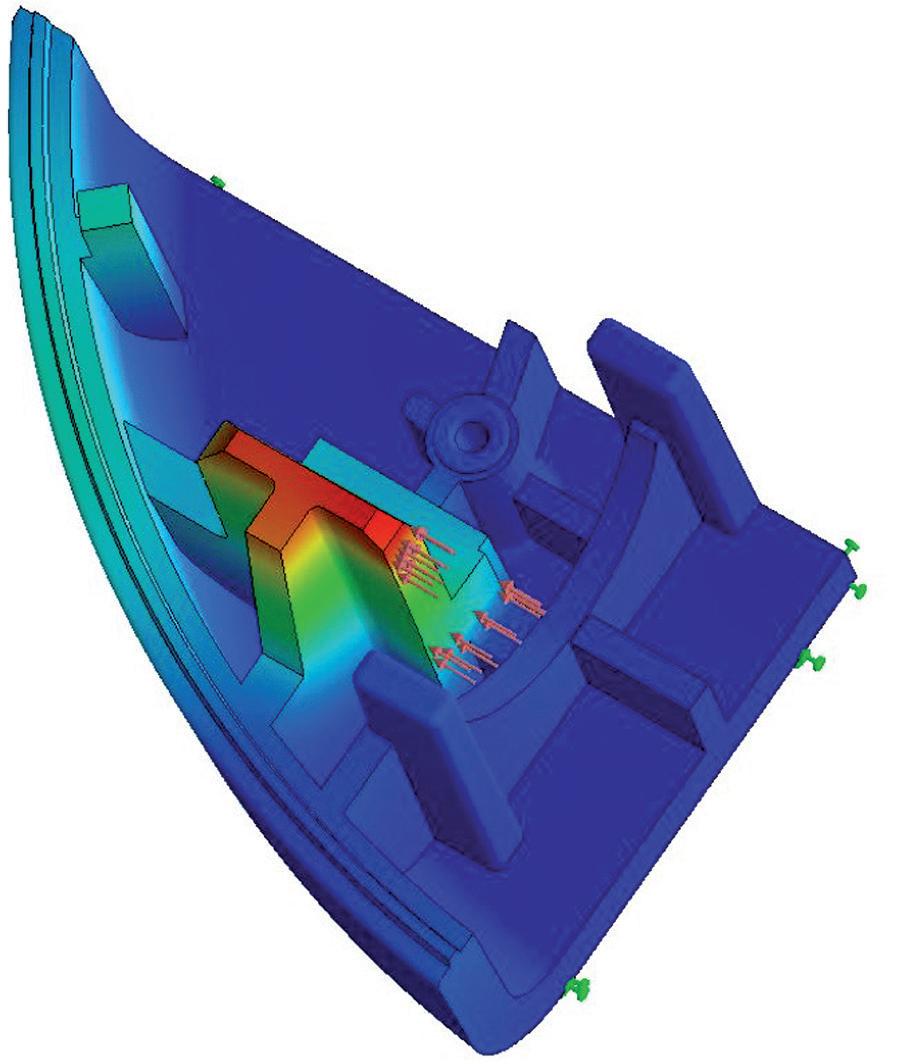

through a plunger in a syringe to displace the fluid within the drug reservoir.
A mechatronic pump has electrically controlled energy release, which uses an electric current to drive a motor or other motion-generating element that controls the actuation device.
To reduce risk and time to market, pharmaceutical companies may prefer to use the standard drug containers (“primary containers”) that they are
already accustomed to using, with the attendant fill-finish infrastructure already in place – vials, cartridges, etc – rather than using the custom primary drug containers required by some OBDS designs. Potential interactions between container materials (e.g. stoppers, closures, plungers and lubricants, such as silicone oil), coupled with the complex molecular structure of long-chain biologics, may reduce the efficacy of these drugs, which is why custom drug containers require extensive risk analyses and stability tests before regulatory approval.5 For example, silicone oil is incompatible with some biologics. In most cases, fully validated internal, or even external, fill-finish solutions for custom containers do not yet exist.
Using existing primary drug containers is the easiest, fastest and most cost-effective solution; however, clinical batches may be filled in containers that do not hold the total intended dose for clinical evaluation, especially during the early clinical phases of drug development. Multiple vials may need to be connected to the OBDS in sequence to deliver the intended dose when the dose requires a volume that exceeds the available volume of one vial. This capability is also beneficial for therapeutic regimens that use a combination of drugs.
The Sonceboz LVI-V model has both functionalities, making it highly versatile. At the heart of the company’s unique patented pump device are two electrically powered, low-noise stepper motors accurately driving two pump pistons that control the omnidirectional flow of liquid
“In most cases, fully validated internal or even external fill-finish solutions for custom containers do not yet exist.”Figure 1: Sonceboz’s large-volume injector (LVI V 20 mL).
according to programmed parameters. Examples of those parameters could be:
• Flow from one drug container to another* (e.g. vial to vial, vial to cartridge, cartridge to cartridge, etc) if reconstitution is needed.
• Flow from up to two drug containers* into the patient’s SC tissue.
The two pistons work as follows: a valve piston connects to three ports successively (the connection points for the external drug containers and injection needle), selecting the ports needed for pumping. The second piston, a pump piston, generates flow by creating a vacuum in the primary drug container(s), actively drawing the liquid in a non-turbulent and gentle manner, similar to filling a syringe. The liquid is then “pushed” into another port.
Connecting to three ports is useful for loading the device with more than one primary drug container. The Sonceboz platform allows delivery volumes of 1–20 mL in its basic configuration. It also allows the delivery of highly concentrated formulations of up to 200 cPs.
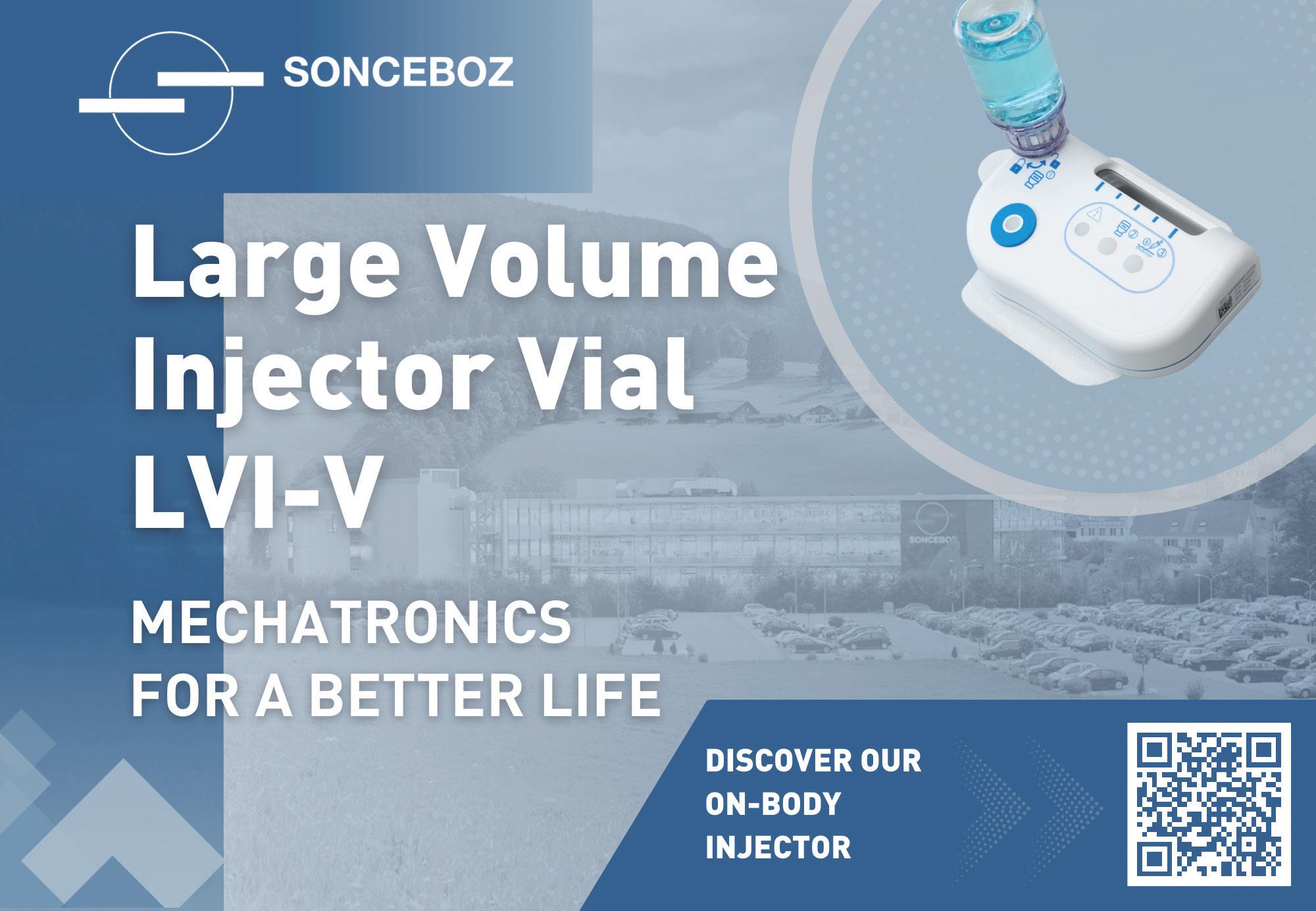
That is the heart. The brain is the smart microprocessor on the circuit board, which can be programmed to ensure that the intended dose is delivered in a predefined time and deliver drugs according to patientand drug-specific profiles.
A well-designed pump should reduce dead volume and ensure that the intended dose indicated on the drug label is delivered, regardless of placement orientation or injection site variation. Sonceboz’s design accomplishes these things with the following features:
• A vacuum to maximise the volume of drug drawn from the primary container
• A device that transfers the drug from the primary drug container (usually a non-collapsible container, such as a vial or cartridge) to a collapsible container (the internal reservoir with a trailing plunger), ensuring that the pump can access the drug regardless of the device’s or patient’s spatial orientations.
Maintaining a precise and constant flow rate across the total container volume is essential to ensure that the intended dose is delivered in a predefined time window. For this, the actuation component matters. A linear spring, for example, cannot provide a constant force; as a spring becomes less compressed, the force exerted on the fluid decreases correspondingly. Theoretically, with mechanical systems, if the force of the actuation component on the liquid is not greater than the force of resistance (the back pressure) of the fluid being displaced, it is possible that the mechanical system would not deliver the total dose to the patient. Consequently, the injection time is affected by the back pressure.
With a mechatronic system, this is a nonissue. Sonceboz’s mechatronic drive system achieves extraordinary flow accuracy of ±5% and has a factory programmable injection rate of up to 3 mL/min.
Furthermore, Sonceboz has used its know-how in motor driving to incorporate a sensorless system that detects pressure on the cannula and responds by automatically decreasing the flow rate in a predefined way, as excessive tissue pressure can lead
to pain and leakage at the injection site, potentially leading to an incomplete injection or loss of drug. Such a system will also detect occlusions more accurately, allowing for an appropriate device response (Figure 3).
A programmable delivery device can be beneficial during the commercial phase and Phase I and II clinical trials when an investigational new drug’s optimal dose and flow rate have yet to be established.

Using near-field communication (NFC) technology to set a delivery program while the device is still in its sterile packaging allows new possibilities for use in clinical trials, as well as when patient-specific dosing is required (e.g. weight-based regimens).
With wide-ranging programming options, pharma companies can easily leverage Sonceboz’s pump across multiple drug products, as well as across a single product’s lifecycle and different patient needs.
Many OBDS designers promote the design of custom primary drug containers, which they suggest would improve the ease of use for patients. However, such custom components may require a substantial redesign of both the device and the drive system of a mechanical device whenever there is a change to the format or size of the primary container. A mechatronic device with a pump system independent of the drug container would only require software adaptations whenever the format or size of the primary container changes, as sometimes happens throughout a product’s lifecycle.
Sonceboz’s mechatronic OBDS makes it possible to connect to various existing primary drug containers of capacities up to 20 mL or even higher, if needed, such as vials or cartridges – without changing the overall system architecture of the OBDS.
In addition to NFC technology, the Sonceboz OBDS will come with built-in Bluetooth low energy connectivity, enabling the device to connect to cloud-based digital healthcare systems, thus allowing healthcare professionals to monitor adherence and provide engaging feedback to patients.
Simplifying the user experience relates to ensuring that the intended dose is delivered; mechanical systems generally have more assembly and preparation steps for the user than automatic mechatronic systems, creating more opportunities for human error. The Sonceboz system has been tested in multiple formative human factors trials and was found to be intuitive and easy to use for healthcare professionals and patients alike in both the USA and the EU.
Even when the battery is fully depleted after use, NFC technology allows an authorised user to collect data (Figure 4). Sonceboz pays great attention to cybersecurity issues and has implemented protective features, such as password-protected access and data encryption. Sonceboz also complies with Europe’s General Data Protection Regulation by pseudonymising all data collected from the device to protect each patient’s personal information.

“The Sonceboz system has been tested in multiple formative human factors trials and was found to be intuitive and easy to use for healthcare professionals and patients alike in both the USA and the EU.”Figure 4: Near-field communication interface for parameterisation of the device’s volume and flow rate depending on drug viscosity.
Over the past few decades, there has been much innovation in delivery technologies and strategies for all therapeutics, including biologics, which were historically only delivered by IV infusion. SC delivery continues to be preferable to IV infusion for several reasons, including:
• The patient or a caregiver can administer the treatment at home instead of visiting a clinic or hospital to have the treatment administered by a healthcare professional
• Fewer medical appointments mean treatment is less time-consuming and inconvenient for the patient, especially if therapy requires frequent administration or if the disorder is a chronic condition requiring long-term treatment
• A lower overall cost of healthcare
• Improved patient adherence
• Possibly fewer infusion-related reactions.2
While there have been many novel drug delivery systems released on the market during this time, including OBDSs, the SC delivery of large-volume (>3 mL) biologics through a simple, wearable device that can be programmed with adjustable delivery profiles without changing the drive system or drug containers has yet to become available.
Sonceboz’s goal is to provide a single multifunctional device that is tried and tested across a range of volumes and viscosities and can be tailored to its intended delivery regimen at the point of care, without the need for hardware modifications and with the ability to set selected parameters in the software.
Sonceboz’s OBDS is ready for evaluation by pharmaceutical companies. The company is here to help pharmaceutical companies and partners deliver drugs at various speeds across various volumes and viscosities while providing safe and consistent drug delivery.
* Sonceboz’s large-volume delivery platform comes in different variants: the vial-connecting injector (LVI-V), the prefilled and preassembled injector (LVI-P), the prefilled injector assembled by the user at the point of use (LVI-U), the dualcartridge injector (DCI) and the autoreconstitution injector (ARI). Both DCI
and ARI can direct flow from one drug container to another. The LVI-V can mix two drugs within its internal reservoir. Some variants can direct flow from up to two drug containers sequentially, while the LVI-V holds both drugs in its internal reservoir and delivers the drugs simultaneously.
Sonceboz’s core competencies consist of design, development and production of mechatronic drive systems. Since 1936, the company’s focus has been on innovation and best-in-class quality and service. Sonceboz is ISO 13485 certified and active in wearable drug delivery, medical devices and the laboratory industry. Customised technology modules, including motor drives, electronics, pumps and needle insertion systems, are available for medical device manufacturers. Sonceboz’s activity in medical devices is based on long experience in the automotive sector, where top quality, reliability and cost effectiveness is key.
1. Vargason AM, Anselmo AC, Mitragotri S, “The evolution of commercial drug delivery technologies.” Nat Biomed Eng, 2021, Vol 5(9), pp 951–967.
2. Badkar AV et al, “Subcutaneous Delivery of High-Dose/Volume Biologics: Current Status and Prospect for Future Advancements.” Drug Des Devel Ther, 2021, Vol 15, pp 159–170.
3. Usach I et al, “Subcutaneous Injection of Drugs: Literature Review of Factors Influencing Pain Sensation at the Injection Site.” Adv Ther, 2019, Vol36(11), pp 2986–2996.
4. Oakley T, “Wearable Injectors, Latest Devices and Recent Trends.” ONdrugDelivery, Issue 111 (September 2020), pp 6–9.
5. Bauert D, Kumar Busimi A, “Expert View: Primary Packaging for Wearable Injectors.” ONdrugDelivery, Issue 100 (Sep 2019), pp 26–28.
Thomas Mayer leads the Business Unit Medtech at Sonceboz Medical. Prior to joining Sonceboz in 2016, he held various management positions at Boston Scientific. Mr Mayer holds an advanced degree in Medtech and Pharma Management from EPFL Lausanne (Switzerland), a diploma in Medical Engineering and an MBA.



Martin Liniger is R&D Manager for electronics hardware and software for the Business Unit Medical at Sonceboz. He started his career as electronics engineer and was active in the development of Medtech products, such as syringe pumps and peristaltic pumps for dialysis machines. Mr Liniger holds a Master of Sciences in Microengineering and an advanced degree in Medtech and Pharma Management from EPFL Lausanne (Switzerland).
Nicolas Bailo is R&D Manager for the Business Unit Medical at Sonceboz. With over 20 years’ experience in developing mechatronics systems in several fields, he put a particular focus – with his strong team – on medical device platform development. Involved in intellectual property and innovation, he looks for elegant and efficient solutions. Mr Bailo holds a Master of Science in Mechanical Engineering, a Master’s degree in Innovation and Management from Ecole Centrale Paris (France) and an advanced degree in Management of Biotech, Medtech and Pharma Venture from EPFL Lausanne (Switzerland).




















































































Here, Iris Schnitzler, PhD, Head of Marketing and Market Services at LTS Lohmann, discusses the benefits of on-body delivery systems, including the flexibility and convenience they bring to patients managing chronic conditions, and how the Sorrel platform overcomes some of the inherent complexities and challenges of developing such a device. Dr Schnitzler then goes on to speak with Bas van Buijtenen, Chief Executive Officer of LTS, and Andrei Yosef, General Manager and President of LTS Device Technologies, about the Sorrel platform and how its integration within LTS supports the company’s fundamental objectives of enabling partners and empowering patients.
While the idea of being able to address the multiple challenges of on-body drug delivery with a one-size-fits-all solution would certainly have mass appeal among pharmaceutical companies, this simplified vision does not reflect the true complexity involved in the development of wearable device technology.
In reality, the breadth of variables at play requires pharmaceutical companies and their partners to hit a vast number of specific targets unfailingly to bring a product or device to market successfully. And in a world where most new molecular entities are biologic in nature, and where increases in viscosities and volume to be infused are challenging conventional delivery devices, decisions about formulation, delivery platform and administration method must be addressed both individually and then as part of a complete solution.
Further to the content of a drug product, the method of delivery must also accommodate context. It is vital to support the needs and wishes of patients and maintain flexibility and comfort to increase the likelihood of compliance and adherence, and increasingly this means providing
highly convenient, easy-to-administer delivery solutions that can be controlled directly by the patient themselves, either at home or via a transportable system that can fit with the fast pace of modern, mobile living. It is also important not to forget all the economic factors regarding device manufacture, assembly, storage and supply, all of which will collectively have a strong bearing on total cost.
These considerations all underline the tricky balancing act of establishing the optimal form of drug delivery for a given molecule, ensuring not only that it supports efficacy and meets regulatory standards, but also that it answers the critically important demands of the target patient population.
LTS’s approach to drug delivery has always been underpinned by a sensitivity
Author:
Dr Iris Schnitzler
Head of Marketing and Market Services
E: iris.schnitzler@ltslohmann.com
Interviewees:
Bas van Buijtenen
Chief Executive Officer
E: bas.vanbuijtenen@ltslohmann.com
Dr Andrei Yosef
General Manager and President
E: andrei.yosef@ltslohmann.com
LTS Lohmann Therapie-Systeme AG
Lohmannstraße 2
56626 Adernach Germany
www.ltslohmann.com
“The breadth of variables at play requires pharmaceutical companies and their partners to hit a vast number of specific targets unfailingly to bring a product or device to market successfully.”
to patient requirements. The philosophy that drives the company’s growth and fuels its innovation – We Care. We Create. We Deliver – is built on a belief of continued improvement in the experience of patients accessing essential medicines. This is evident in established platforms, such as transdermal patches and oral thin films, as well as emerging technologies, including micro array patches (MAP) for the transdermal delivery of large-molecule, biological actives. These methods all bring common benefits to patients in the form of simple, discreet and pain-free self-administration.
Following the integration of Sorrel into the LTS group under the LTS Device Technologies division, this extensive portfolio now also includes a wearable injector platform that supports large-volume drug delivery through a vial or cartridgebased on-body device system (OBDS). This is an important expansion of LTS’s patientfriendly drug delivery capabilities, creating opportunities for wearables in a range of delivery applications.

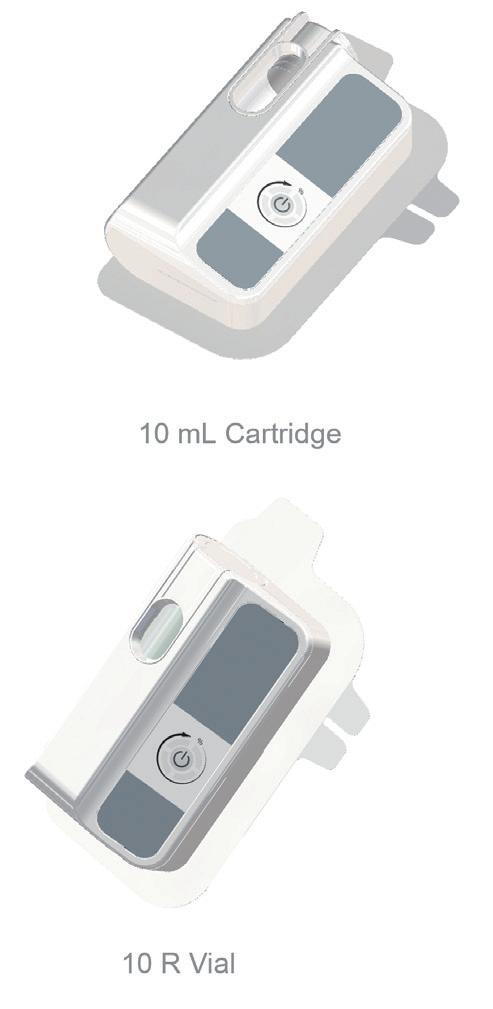
The OBDS market has attracted significant attention in recent years because this type of device can bring flexibility and convenience to patients who are managing chronic conditions through regular injections. By simplifying and automating the injection process, OBDSs often represent an easier pathway for patients, which can improve adherence and lead to better outcomes.
For the pharmaceutical companies developing a combination product, flexibility and comfort at the patient level can, however, add complexity to
the fill-finish process. For example, many current OBDSs require the pharmaceutical company to decide between a patientfriendly, prefilled, preloaded device that uses a proprietary cartridge or a pharmafriendly device that will accept standard ISO vials and commercially available containers, but which requires additional steps to be carried out by the patient during dose administration.
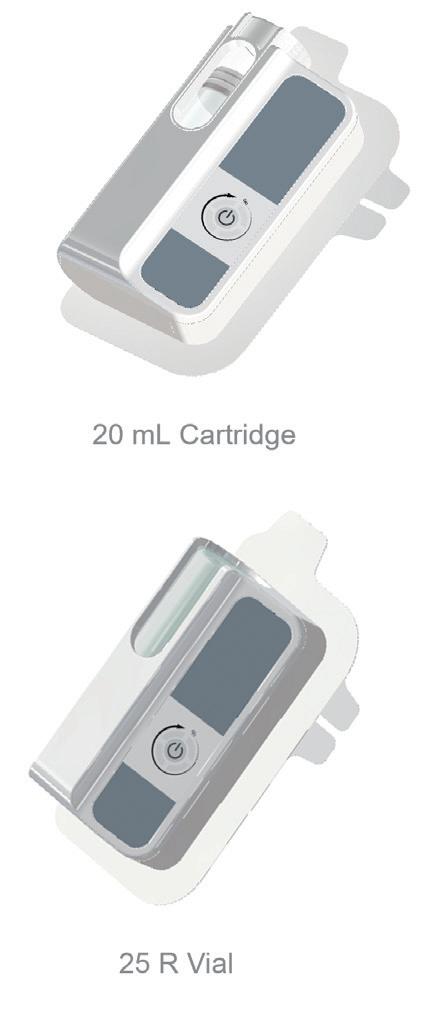
The Sorrel platform addresses all these challenges in a market-ready vial or cartridgebased OBDS for the subcutaneous delivery of large-molecule drugs (Figure 1). The ergonomic, user-friendly system incorporates a disinfection chamber with an integrated UV-C LED, meaning it can be presented to a patient prefilled and preloaded, simplifying use and optimising uptake without having to replace the current primary container.

“The Sorrel platform will also benefit from being part of a strong market-leading brand that has global presence.”Figure 1: The Sorrel OBDS: an innovative platform design enabling customer flexibility during development.
Here follows the Q&A with Bas van Buijtenen and Andrei Yosef (Figure 2):
QWhat do you see as the key benefits of bringing the Sorrel platform to LTS?
AYLooking at it from the perspective of the device technologies division (formerly Sorrel), the ownership of LTS brings real strength by facilitating investment and supporting growth at a much faster rate. The platform has passed an inflection point in its growth. The first combination product containing our device has imminent US FDA approval, with several drugs close behind in the clinic. So, by facilitating investment and supporting our growth, being part of LTS will help us expand our manufacturing footprint and “future proof” ourselves for expected expansion as more of our in-clinic partnered programmes commercialise.
The Sorrel platform will also benefit from being part of a strong market-leading brand that has global presence. It will mean we can offer a more “turnkey solution” for our pharma partners in addition to our device platform.
BvBAt LTS, we have a longstanding passion to bring convenient drug delivery solutions to our pharmaceutical customers and their patients, evidenced by the billions of transdermal patches and oral thin films that we have safely supplied over the years. Bringing that ease of administration to the world of large molecules has been a central part of our strategy, as can be witnessed through our innovation in MAP technology. The addition of the Sorrel business accelerates that strategy and brings our customers access to an entirely new technology. It allows LTS to take a big step forward into the world of biologics and biosimilars, bringing greater balance to our product portfolio, and opening up tremendous potential for further innovation.
QCan you elaborate on what this means to your pharmaceutical partners?
AYOver the last year we have installed and validated two semi-automated production lines, which brings our commercial-ready capacity to 1.5 million units per year (Figure 3). We have engineered a very efficient, scalable manufacturing process and, with
the acquisition, we now have the potential to increase this output significantly and at multiple sites all over the world.
Beyond investment in innovation and capacity growth, our capabilities have also been broadened through the acquisition, allowing us to serve our partners more fully. We are extremely excited to offer pharmaceutical companies a solution for the assembly of primary containers into the device and final packaging. We can place this technology at our partners’ facilities or manage the entire process within LTS facilities in the EU or US.
BvBPharma companies will seek to qualify solutions from their suppliers on many fronts before committing to bring them to market commercially. A lot of that is, of course, about the technology: does it meet our technical requirements and has that been

validated and documented robustly? How well does it do on human factors? Next to that, our customers need to trust the organisation: does it have the talent, the capabilities, the quality mindset, the capacity, the capital and commitment to tie it to the fortunes of a blockbuster drug? With the progress that the Sorrel technology has made, and with the broader LTS organisation’s backing, we will help our customers tick all of those boxes.
AYAs part of our strategy, and as a market leader, we need to keep driving innovation. We have just completed clinical evaluation of our new platform device featuring a unique insert module. This new platform device offers a range for both vials (6–25 R) and cartridge (5–20 mL) while using exactly the same device. This will allow our pharmaceutical partners with a large pipeline of drugs to focus on one device only that can serve most of their drug needs. Not only does this allow for faster time to market but also even faster time to clinic. BvB
We will continue to innovate around these platforms, guided by the LTS mission of “We Care. We Create. We Deliver”. What the platforms
“Pharma companies will seek to qualify solutions from their suppliers on many fronts before committing to bring them to market commercially.”
The ground-breaking design of the Sorrel™ Drug Delivery Platform is suited for multiple configurations, molecules, and indications to enable smart, reliable, simple drug delivery at home. Therefore it mitigates the risks associated with original development including safety, efficacy, cost and time to market.
Meet our team at upcoming PDA, PODD and CPHI events or contact us: contact.sorrel@ltslohmann.com

have in common at a fundamental level is that they are geared to making patients’ lives easier, creating access to immunisation and therapies more quickly and minimising disruptions to patients’ lives. Both our MAP and OBDS technologies are at a stage where they have demonstrated consistent clinical performance, making them ready for commercialisation and scale-up. We are closest to market entry with our wearable devices, where our first customer is anticipating a commercial launch before the end of the year. Our teams are working on a rich pipeline of opportunities for wearables and MAPs to help more customers follow in those footsteps. In each of those projects, customers benefit from the foundations that have now been laid, de-risking and accelerating all future projects.
QWill growth at LTS continue to be supported by acquisitions in the future?
BvBTo clarify, LTS is not a company that makes acquisitions for the sake of it. Our growth strategy is clear and for every element of that strategy there is an organic action plan. Mergers and acquisitions are effectively a lever we can pull to accelerate that underlying strategy.
In recent years, we have used it to fulfil two strategic priorities. The first was strengthening our position in North America, with the acquisition of our Saint Paul (MN, US) site facilitating a major step forward for LTS by giving us, among other capabilities, an R&D facility in that market.
Now, with the acquisition of the Sorrel business, we have accelerated another growth priority: bringing breakthrough technologies to the world of large molecules, and thus extending our portfolio of patient-friendly solutions. Our next priority is, of course, to integrate these businesses in such a way that we maximise their organic contribution and make them part of the foundations upon which new growth can be built. Innovation breeds further innovation.
In conclusion, while wearable devices and OBDSs must be as simple as possible from a user’s perspective, these are highly sophisticated platforms that are evolving to meet complex drug-delivery challenges, for everything from small-molecule therapies to large-volume biologics and biosimilars. It is less a case of one size fits all and more a case of employing the right platform to reach the
market in the most effective way. With the addition of Sorrel’s vial or cartridge-based OBDS, LTS has the breadth of platforms to deliver on this promise for pharma partners and patients alike.
We Care. We Create. We Deliver. The driving philosophy behind LTS Lohmann Therapie-Systeme AG. As a trusted technology partner for the pharmaceutical industry, LTS develops and manufactures innovative drug delivery systems, such as transdermal patches (TTSs) and oral thin films (OTFs) as well as wearable drug delivery devices. LTS’s commercial offering encompasses more than 20 marketed products
and a diverse pipeline of more than 40 development projects targeting multiple disease indications. LTS’s innovation pipeline contains both partner-funded as well as proprietary, LTS-funded projects. LTS maintains its leading position through the continuous refinement of its core TTS and OTF technologies and by advancing emerging drug delivery technologies, including MAPs for the transdermal delivery of large-molecule, biological actives. With its Sorrel™ wearable drug delivery platform, LTS offers patient-friendly solutions for complex drug delivery. Founded in 1984, LTS operates today from four sites: in Andernach (Germany), West Caldwell (NJ, US), St Paul (MN, US) and Netanya (Israel). LTS also has a representative office in Shanghai (China).
Iris Schnitzler, PhD, studied chemistry and received her PhD in Bioorganic Chemistry from the University of Bonn (Germany). She started her career at LTS in 1999 as Head of R&D in the cosmetics subsidiary. Very quickly, Dr Schnitzler realised that her passion lay more in dealing with people than in research behind the laboratory bench. Therefore, in 2001, she became Head of Business Development for the cosmetics business and then Head of Sales. In 2013, she moved to the pharmaceutical business, where she now heads the Marketing and Market Services department.

Bas van Buijtenen is a Business Executive and Non-Executive Board Member who has devoted his career to growing businesses in drug delivery, health and nutrition, pharma packaging and (speciality) materials. In 2020, he joined LTS Lohmann Therapie-Systeme AG as CEO and Chairman of the Executive Board to drive the development and execution of its corporate strategy, building on LTS’s impressive track record as a leader in transdermal and transmucosal drug delivery.

Andrei Yosef, PhD, is the General Manager and President of LTS device technologies. Dr Yosef is a recognised expert in drug delivery device technology with over 20 years’ experience, having established and served as an executive in several companies in the field. Sorrel, which Dr Yosef led from its inception, has become a renowned leader in the field of wearable injection devices and was recently acquired by LTS Lohmann Therapie-Systeme AG. Dr Yosef holds a PhD in Biomedical Engineering from the Technion –Israel Institute of Technology.

In this article, Adam Stops, PhD, Head of Product Management for Drug Delivery Systems at Stevanato Group, introduces Vertiva™, the company’s next-generation on-body delivery system platform, and discusses how it meets the needs of pharma companies looking to deliver large-volume doses in a patient-centric manner.
Sitting at the intersection of many trends currently shaping the future of healthcare, on-body delivery systems (OBDSs) can be seen as a breakthrough area in drug delivery. Indeed, the potential of this device segment is reflected in analyst forecasts, with over 6,350 patients having been enrolled in 35 clinical trials worldwide, a trend that has grown at a compound annual growth rate (CAGR) of 33% over the past decade.1 The market is now predicted to grow at a CAGR of over 40% in the period 2021–2035, with North America and Europe expected to dominate, representing 80% of the total market share.1
This predicted rise is based on the capability of OBDSs to support patients in easing the burden of a broadening range of chronic conditions. As well as more familiar applications, such as diabetes and pain management, this also includes using OBDSs to deliver treatments in areas such as oncology and for conditions such as hypertension.
A fundamental advantage of OBDSs is that they offer patients the ability to self-administer therapies in their own homes. This fits with the recognised global shift in the delivery of care away from hospital or clinic settings in cases where the therapy being administered, and the delivery method, allow. This shift has many benefits for patients, not least because their lives are less disrupted by enforced travel, but also because they are able to retain a greater sense of control and agency over their own health.
Furthermore, a shift to home-based self-administration by patients has the potential to reduce costs for payers and free up time for healthcare professionals (HCPs) as patients take more responsibility for the delivery of their own medications. And, rather than weakening the link between patient and HCP, the connected nature of devices such as OBDSs introduces the potential to improve data capture around a patient’s engagement with their treatment. Crucially, this process does not depend
Dr Adam Stops Head of Product Management for Drug Delivery Systems
E: adam.stops@stevanatogroup.com
Stevanato Group
Via Molinella 17 35017 Piombino Dese Padova Italy
www.stevanatogroup.com
“A condition of moving towards more patient-centric delivery is that device and therapy must combine in a form that makes it easy for an individual to self-administer a subcutaneous injection, minimising the risk of errors and enhancing the potential for adherence.”
on often unreliable self-reporting by an individual, meaning this valuable information can highlight issues around adherence and help refine treatment pathways.
As mentioned previously, a condition of moving towards more patient-centric delivery is that device and therapy must combine in a form that makes it easy for an individual to self-administer a subcutaneous injection, minimising the risk of errors and enhancing the potential for adherence. As such, therapies that might have been delivered intravenously at a hospital under the supervision of an HCP will need to undergo a reformulation process to make them suitable for patient-led delivery via a prefilled syringe, autoinjector or OBDS. However, particularly in the case of biologics, this can result in highly concentrated drugs with high viscosity or formulations that must be delivered in high volumes. In light of this, OBDSs have the distinct benefit of being able to deliver volumes of between 3 mL and 10 mL, and potentially more.
Zooming out from industry-specific challenges to overarching macro issues, OBDSs can also provide answers when it comes to the question of sustainability, which has rightly become a growing concern among global populations and is now a key priority for device manufacturers. OBDS platforms can contribute to this by integrating consideration for sustainability into device design, maximising opportunities for re-use by patients, extending the device’s lifetime and minimising the potential for waste.
Stevanato Group has worked to integrate all these aspects into Vertiva™, its next-generation OBDS device platform (Figure 1). Vertiva™ shares its DNA with the OBDS that was first developed by Stevanato Group as an alternative to pen injectors for diabetes patients and then evolved through a successful partnership with Bexson Biomedical (CA, US) to create a discreet wearable device for the safe and convenient management of acute pain through delivery of Bexson’s proprietary subcutaneous ketamine formulation, BB106.
Further evolution of the platform means that, today, Vertiva™ offers pharmaceutical partners a highly flexible system that can be fully customised according to specific application requirements. It is based on an integrated unit made up of two parts – a single-use pod that contains the prefilled and preloaded drug cartridge and a smart controller that contains the electromechanical elements of the device, which can be re-used for multiple therapy cycles.
Vertiva™ has been designed to minimise the risks associated with one of the major issues in home-based medicine delivery – patient behaviour. There is no doubt that providing patients with greater autonomy over their own care can be highly beneficial, but it can also introduce greater potential for treatment regimens to be compromised by poor adherence. Furthermore, devices that place a high level of demand on the user in terms of priming and administration can elevate the risk of medicine self-administration errors, which are known to compromise patient safety and are of particular concern among older populations.2
In contrast, the Vertiva™ platform’s prefilled and preloaded pod requires no manual intervention from the patient to load the drug container, avoiding the need for any drug or device preparation steps to be carried out. This makes the device intuitive to use, with the process of needle insertion and retraction carried out completely automatically, and with sensors employed to prevent premature activation. This dramatically reduces the burden on the patient, supporting improved uptake in the critical early stages of adoption when patients are acclimatising themselves to a new form of drug delivery and adjusting to a novel, non-clinic setting. Having laid a positive foundation, Vertiva™ then supports improved adherence over time as patients are less likely to suffer from the fatigue associated with more high-friction, effort-intensive devices.


“Vertiva™ has been designed to minimise the risks associated with one of the major issues in home-based medicine delivery –patient behaviour.”Figure 1: Vertiva™, Stevanato Group’s next-generation OBDS.
Unlike fully integrated OBDS devices, the two-part structure of Vertiva™ ensures all electromechanical elements are contained within the smart controller, which co-ordinates drug delivery through a magnetically coupled drive mechanism and could support the transfer of essential data on dosing and patient activity via optional Bluetooth functionality (Figure 2). Since the pod is free of electronic components, it allows for simple disposal after use. The smart controller, meanwhile, can be reused multiple times, with the precise number of repeated uses determined by the complexity of the specific delivery profile in question. For example, for typical bolus delivery durations of 30 minutes to a couple of hours, the patient may only need one controller per year for a monthly regimen. This not only enhances the sustainability of the platform, it also allows the cost of the controller to be spread across multiple doses.
In a novel innovation, the user interface of the Vertiva™ can be tailored according to therapy need, with the potential to customise visual, audible and tactile feedback. Buttons, icons and indicator lights can provide users with information on injection progress and dose monitoring, as well as the option to include more specific therapy support features, such as an on-demand bolus counter. The use of such features will depend entirely on the dosing profile required by the therapy in question. Vertiva™ can be programmed to control a combination of everything from micro-precision basal doses to full-content bolus injections, with a delivery duration ranging from minutes to several hours.
Within the pod element, further customisation can be achieved in terms of the choice of plunger, septum and crimped cap. These options all open the door to more diverse treatment options and yet they are all based around standard primary container components that are both readily available at commercial quantities and compatible with well-established fill-finish processes. This helps to minimise overall costs while also providing customers with the assurances that come from specifying industry-proven container solutions.
To further support customers in the evaluation of drug container integration with Vertiva™, 3 mL engineered samples are available for testing and technical assessment. This proposition is enabled by Stevanato Group’s significant investment in OBDS manufacturing capabilities at its site in Germany to facilitate the manufacture of Vertiva™ devices.

Stevanato Group’s high-precision moulding machines, based in Germany, feed into a sophisticated device assembly line that is staffed by specially trained, expert operatives (Figure 3). Stevanato Group’s broad strengths in pharmaceutical manufacturing and its in-house production capabilities are complemented by the provision of high-quality components from its supply-chain partners, providing assurance of a robust source of supply, with all output closely controlled through a series of comprehensive in-process checks and a robust quality management system.
Flexibility and collaboration are key factors in establishing a scalable production framework for the Vertiva™ platform. As such, Stevanato Group can integrate directly with a pharmaceutical partner and their chosen fill-finish and final assembly contract manufacturing organisation by supplying containment systems, support services at fill-finish and equipment for automated inspection and final assembly in the final stages of preparing Vertiva™ for market.
To ensure customers are fully supported in bringing Vertiva™ to market, Stevanato Group has also leveraged its recently announced collaboration with Thermo Fisher Scientific (MA, US). This provides pharmaceutical partners with access to a streamlined, integrated and fully scalable framework for orchestrating the manufacture of a complete combination product system, from the first stages of formulation development through compounding, aseptic cartridge filling and automated inspection to final assembly, serialisation and packaging. Along with the proprietary Vertiva™ device platform, this offering also incorporates provision of Stevanato Group’s bulk and pre-sterilised EZ-fill® cartridges as drug containment solutions, as well as assembly equipment provided by Stevanato Group and pre-installed at Thermo Fisher, while Thermo Fisher will provide fill-finish and final assembly services.
The strength of this partnership, allied to the innovative nature of the Vertiva™ platform, provides pharmaceutical companies
“Flexibility and collaboration are key factors in establishing a scalable production framework for the Vertiva™ platform.”
with a powerful end-to-end pathway for developing an advanced OBDS comparatively quickly and cost effectively. It helps minimise potential technical challenges related to the interfaces between device, primary packaging, filling and final assembly before installation and customer onboarding, enabling a reduction in overall development timelines, costs and risks to accelerate time to market.

Backed by its streamlined development and production process, Vertiva™ offers pharmaceutical customers the means to open up a range of new opportunities for convenient and effective on-body medicine delivery, allowing patients to manage the symptoms of their condition from the comfort of their own homes. This vision might not be new, and it certainly requires the management of a great deal of complexity, but, with the right platform and the right partners in place, perhaps it is now truly an idea whose time has come.


Founded in 1949, Stevanato Group is a leading global provider of drug containment, drug delivery and diagnostic solutions to the pharmaceutical, biotechnology and life sciences industries. Stevanato Group delivers an integrated, end-to-end portfolio of products, processes and services that address customer needs across the entire drug lifecycle at each of the development, clinical and commercial stages. Stevanato Group’s core capabilities in scientific

research and development, its commitment to technical innovation and its engineering excellence are central to its ability to offer value-added solutions to clients.


1. “The large volume wearable injectors market is anticipated to grow at an annualized rate of over 40%, claims Roots Analysis”. Press Release, Roots Analysis, Dec 2021.



2. Aldila F, Walpola RL, “Medicine self-administration errors in the older adult population: A systematic review”. Res Social Adm Pharm, 2021, Vol 17(11), pp 1877–1886.

Adam Stops, PhD, is Head of Product Management for Drug Delivery Systems at Stevanato Group, managing autoinjectors, prefilled variable and fixed-dose pen injectors, large-volume wearable injectors and inhalers. With a PhD in Mechanical Engineering and an MBA in Business Management, Dr Stops has broad experience in the design, development and product management of devices and parenteral products. Throughout his career, he has worked with innovative multinational companies leading teams of experts in device research, design and industrialisation.
SAE Media Group Proudly Present the 16th Annual Conference…

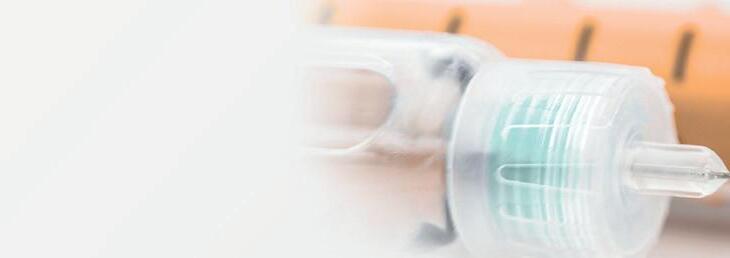
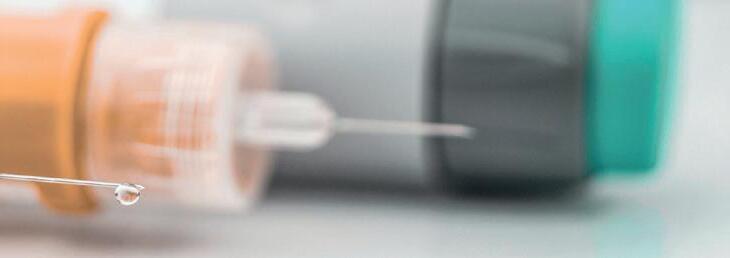
9 - 11 January 2024
Leonardo Royal Hotel London, Tower Bridge, London, UK
GOLD SPONSORS:


STREAM SPONSORS:






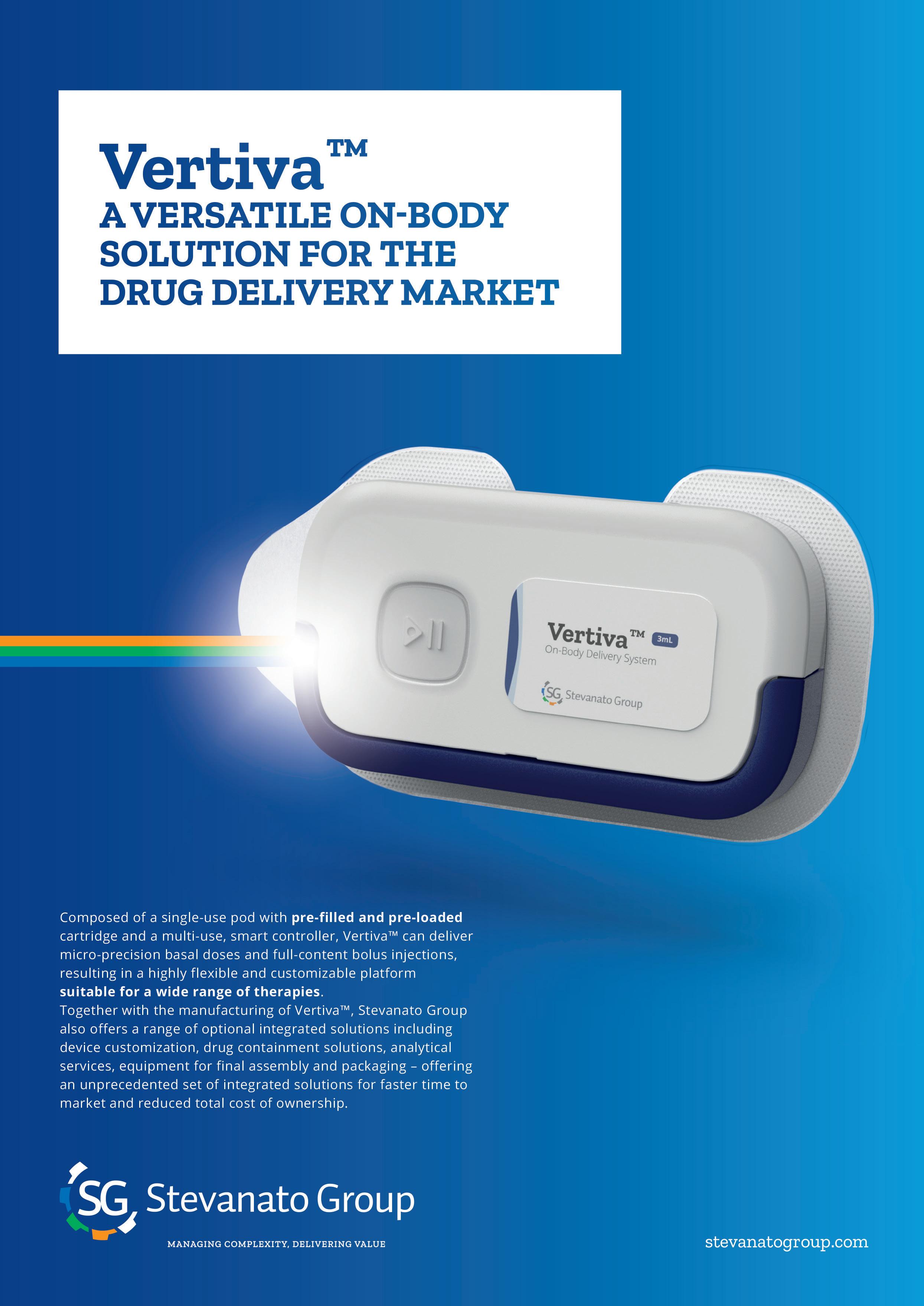
In this piece, Cécile Gross, Global Category Manager, Parenteral, and Mark Tunkel, Global Services Director, both at Nemera, discuss the role of patient-centricity in the development of the company’s sustainable on-body injector platform.
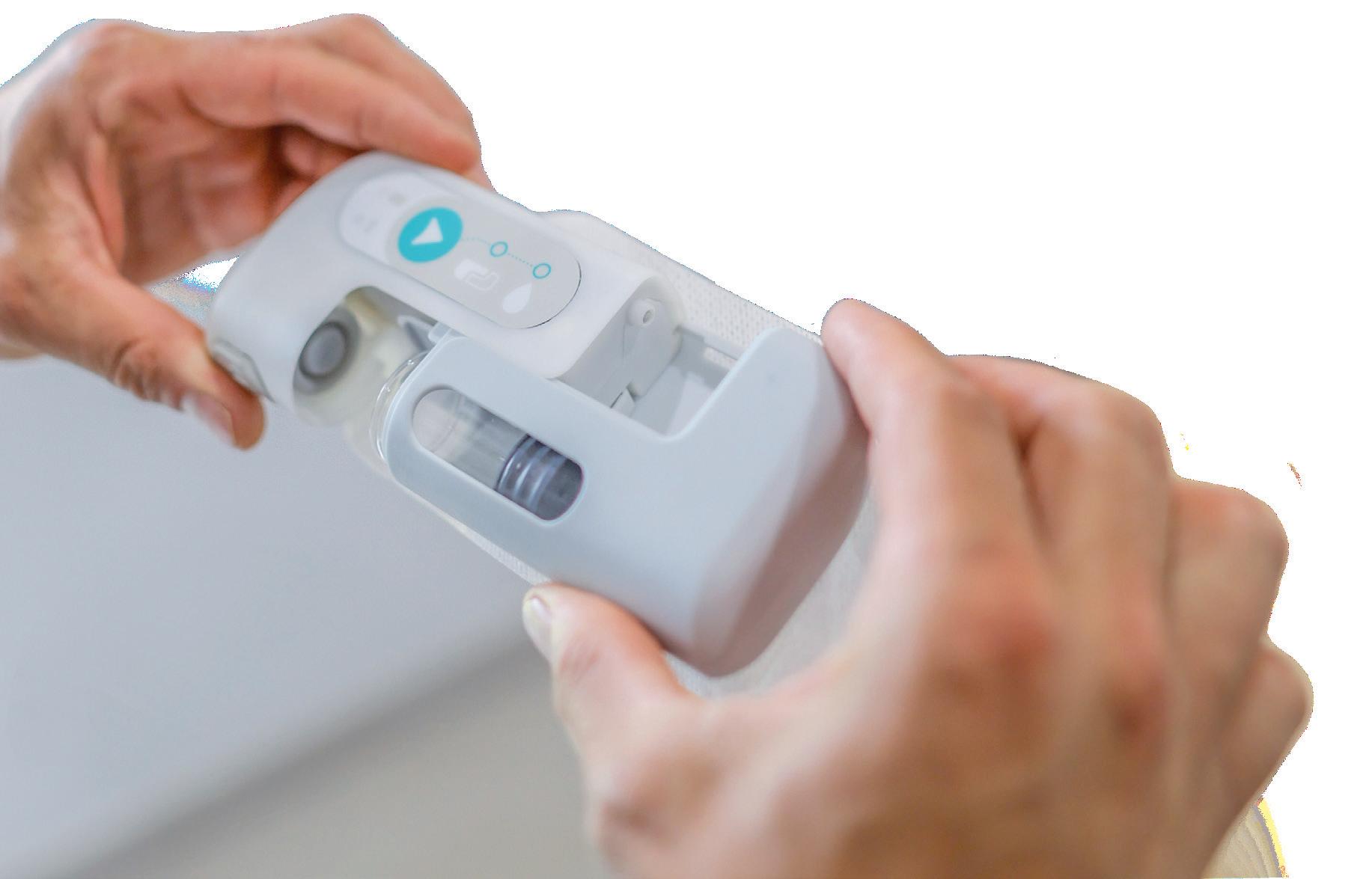
“Putting the patient at the centre of healthcare” and “patient-centred care” are objectives that have been stated for more than two decades in the medical world, whereas “patient-centricity” has appeared in the life sciences field more recently but covers the same principles. These terms are still relevant today, as there is definitively room for improvement. This is reflected in the 2022 article from W Baldwin, Associate Director Life Sciences and Patient Experience Center of Excellence Lead at Accenture (Dublin, Ireland), evocatively titled “Why does patient centricity matter to pharma?”
It is true that, beyond the nice concepts and the humanistic vision that build community consensus, turning these principles into tangible assets is not as easy as it seems. “Zeal without knowledge is like fire without light,” as one might say. Specifically, the parenteral field is
Cécile Gross Global Category Manager, Parenteral cecile.gross@nemera.net Mark Tunkel Global Services Director mark.tunkel@nemera.net
Mark Tunkel Global Services Director mark.tunkel@nemera.net
Nemera 63-65, avenue Tony Garnier 69007 Lyon France

“A new drug delivery system for a bolus injection was needed for patients outside diabetes.”
formulation, as well as the rise in use of biologics, have led to the development of large-volume injectors. So far, safety systems, pen injectors and autoinjectors have been constrained by the drug dose and their primary drug container fill volumes.
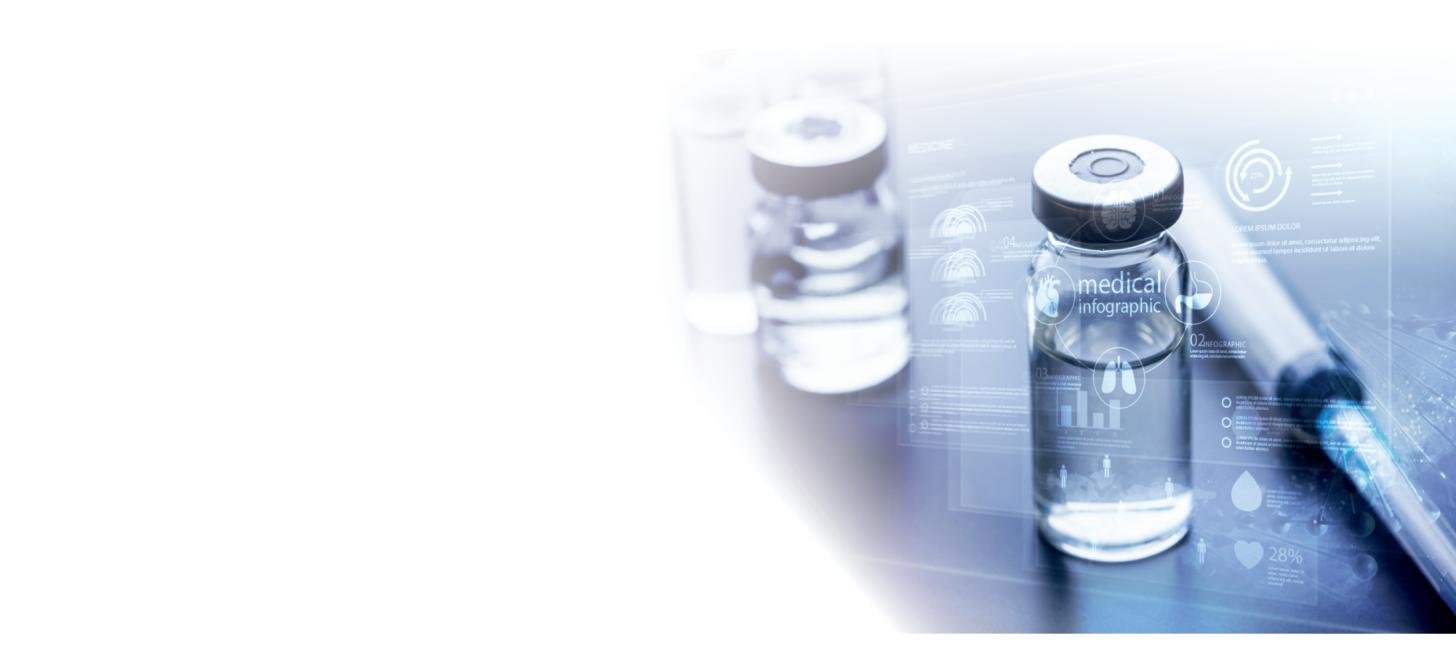
In parallel, large-volume injections have been performed subcutaneously for a long time in the diabetes space, coupled with continuous blood glucose management. However, the dose is variable, and the entire injection is spread over a long period of time. Thus, a new drug delivery system for a bolus injection was needed for patients outside diabetes.
To revisit the challenges mentioned above, the question is how to take a patient-centric path while considering

both a novel drug delivery device and a new patient population? Nemera chose to address this question with a twin-track strategy. On the one hand, identifying the patient journey and preferences and, on the other, building a sustainable on-body injector platform (Figure 1).

Four main therapeutic areas have been identified, all of which are considered to be “chronic diseases”, but with different treatment regimens, durations and injection frequencies. Nemera commissioned its Insight by Nemera capability to conduct several studies. One usability study
focused on this typology of therapies. Patients were recruited in the following categories: oncology (e.g. multiple myeloma, acute myeloid leukaemia, lung cancer, breast cancer), autoimmune diseases (e.g. rheumatoid arthritis, Crohn’s disease, Ankylosing Spondylitis, atopic dermatitis, psoriasis), haematological immune deficiencies (e.g. haemophilia A) and disorders of the central nervous system (e.g. multiple sclerosis, Parkinson’s disease, Alzheimer’s disease).
Many of these patients have made the switch from intravenous to subcutaneous injection, with relief according to the latest systematic review,1 which is in line with the assessment obtained for the forerunners trastuzumab2 and rituximab.3
The primary beneficial outcomes of such a switch are time savings, which have a positive impact on daily life, and flexibility in terms of scheduling and care.4 Therefore, there is a need to understand the impact on biological tissue (Figure 2). Skin modelling is an ongoing task at Nemera, trying to answer questions related to drug distribution, skin back pressure and pain. In parallel, Nemera is also collaborating with the Subcutaneous Drug Development & Delivery Consortium (OR, US) via a peer-to-peer sharing of experience, especially in the high-dose highvolume sub-team5 for which pain is the focus of 2023.


On the device side, Nemera has leveraged its experience in designing and manufacturing parenteral devices and applied it to this patient environment. The result is a two-step device following a “click, patch and go” operation. As shown in Figure 3, the reusable module must be assembled with the disposable one to perform the injection. Everything is automated once
the patient presses the green button, and the disposable module comes preloaded and preset. Connectivity features are also embedded to secure the proper and complete bolus is delivered, and to allow disease management with an app keeping the link between patient and healthcare professional active.
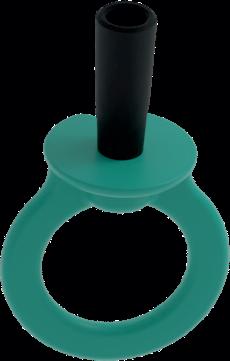
To fine-tune the development of the electronics and software parts of the platform, Nemera has entered into a partnership with Zollner Elektronik AG (Zandt, Germany), one of the largest electronic manufacturing service providers. Zollner specialises in advanced mechatronics for healthcare and life sciences, railway technology, aerospace, defence, automotive technology and many other sectors. As a partner-of-choice, it will support the design, development and manufacturing of electronic drug
delivery systems for both Nemera’s proprietary and customer-owned products. This collaboration will begin with Symbioze™ platform.
To quote Erwin Stöckinger, Senior Vice-President Business Division Electronics at Zollner, “From the very beginning, Nemera has been a remarkable match for Zollner on both a technological and human level for mutually developing groundbreaking solutions toward a sustainable society. [This] partnership [will] open up new growth markets.”
In the same way, Nemera is expanding its view of the patient journey beyond the treatment journey to embrace the patient’s perspective more holistically; adding sustainability is a means for Nemera to show its commitment as a company to the climate, as well as being consistent with its motto, “We put patients first”.
“Nemera is expanding its view of the patient journey beyond the treatment journey to embrace the patient’s perspective more holistically; adding sustainability is a means for Nemera to show its commitment as a company to this topic.”
Partnering with Nemera can simplify the process of integrating the Symbioze™ platform with drug products, accelerating the development of combination products and expediting time to market while managing the complexities associated with on-body injectors. Nemera ensures that the Symbioze™ device platform is tailored to the specific needs of the patient populations, drug characteristics, delivery time and regulatory requirements of each individual project. The company’s comprehensive services and capabilities cover critical areas essential for the success of combination products:
• Analytical services and design verification
• Human factors and user experience management
• Regulatory strategy and submission authoring
• Drug/device assembly and packaging support.
Collaborating with an integrated partner provides several advantages, including a patient-centric approach that considers
the device and its surrounding support elements, such as instructions for use, packaging, digital experiences (including mobile applications), and training solutions to increase adherence and engagement. Nemera recognises that navigating the complex ecosystem for combination products to achieve market success can be challenging. Its services are designed to align with the expectations of various stakeholders, including healthcare professionals, networks, payers and regulators.
To address the challenges of product development, Nemera leverages its endto-end expertise throughout the process, ensuring consistent execution. Its approach minimises the risk of essential information being lost at different stages or when working with multiple partners. With Nemera’s experience in managing complex user needs and regulatory requirements, the company can accelerate its customers’ time to filings and market entry.
Ultimately, the value of Nemera’s integrated services lies in the flexibility it offers, allowing customers to focus on their core business of drug discovery and development. As a partner and extension of customer teams, Nemera delivers bestin-class solutions, ensuring no compromises are made when collaborating with it.
Symbioze™ is a registered trademark of Nemera La Verpillière SAS in the EU.
As a world-leading drug delivery device solutions provider, Nemera’s purpose of putting patients first enables it to design and manufacture devices that maximise treatment efficacy. Nemera is a holistic partner and helps its customers succeed in the sprint to market with its combination
products. From early device strategy to state-of-the-art manufacturing, Nemera is committed to the highest quality standards. Agile and open-minded, Nemera works with its customers as colleagues. Together, it goes the extra mile to fulfil its mission.
1. Overton PM et al, “Patient Preferences for Subcutaneous versus Intravenous Administration of Treatment for Chronic Immune System Disorders: A Systematic Review”. Patient Prefer Adherence, 2021, Vol 15, pp 811–834.
2. Waller CF, Möbius J, Fuentes-Alburo A, “Intravenous and subcutaneous formulations of trastuzumab, and trastuzumab biosimilars: implications for clinical practice”. Br J Cancer, 2021, Vol 124, pp 1346–1352.
3. M. Rummel et al, “Preference for subcutaneous or intravenous administration of rituximab among patients with untreated CD20þ diffuse large B-cell lymphoma or follicular lymphoma: results from a prospective, randomized, open-label, crossover study (PrefMab)” Ann Oncol, 2017, Vol 28(4), pp 836–842.
4. Jackisch C et al, “White Paper on the Value of Time Savings for Patients and Healthcare Providers of Breast Cancer Therapy: The Fixed-Dose Combination of Pertuzumab and Trastuzumab for Subcutaneous Injection as an Example”, Adv Ther, 2022, Vol 39(2), pp 833–844.
5. Gandhi R, Badkar A, LaBarre M, “Subcutaneous Delivery of High-Dose/ Volume Biologics: Current Status and Prospect for Future Advancements”. US National Library of Medicine, National Institutes of Health, Jan 2021.
Cécile Gross is Marketing Global Category Manager at Nemera, focusing on parenteral devices. She oversees the product portfolio strategy, development and lifecycle for safety system, pen injector and on-body injector platforms. She has more than two decades of experience in the medical device industry, marketing business-to-business technological products and implementing product lifecycle management for various kinds of devices. Ms Gross holds a degree in International Business and completed her initial training with a Master’s degree in Marketing and Management in the Healthcare Industry at IMIS Institute, Lyon France.
Mark Tunkel is Global Category Director, Services at Nemera. He was previously a partner at Insight Product Development, which was acquired by Nemera in 2019 and became the Insight Innovation Center. With more than 20 years of global business development experience and a deep understanding of the marketplace challenges and trends impacting the pharma industry, Mr Tunkel has advised many of the world’s leading companies on their product development and innovation strategies, with an emphasis on driving realisation and the most favourable business outcomes.
“Nemera ensures that the Symbioze™ device platform is tailored to the specific needs of the patient populations, drug characteristics, delivery time and regulatory requirements of each individual project.”

Traditional analogue medical devices, such as autoinjectors, are now being designed to leverage the capabilities of the Internet of Things (IoT). Connected medical devices provide enhanced monitoring, data collection, connectivity and, more importantly, patient safety. Patient acceptance to mission-critical connected pharmaceutical delivery devices is dependent on innovative designs that offer ease of use, accuracy of dosage delivery and affordability. Autoinjectors, inhalers and wearable infusion device designs require component technologies that ensure proper and safe performance. In addition, designs must go through rigorous testing to meet global and regional safety standards and regulations.
There are an estimated 1.3 billion medical injectors used today in hospitals, medical centres and homes around the world. According to Grand View Research, the global injectors market size was valued at US$6.66 billion (£5.24 billion) in 2021. The market is expected to expand at a compound annual growth rate of 15.29% from 2022 to 2030.
The main market-driving factors are the prevalence of chronic illnesses, technology advancements and an increased desire for in-home care:
• Chronic illnesses: an ageing population and the rising prevalence of chronic ailments such as diabetes, cardiovascular disease, obesity, cancer, psoriasis, arthritis and migraines. Currently, the highest volumes of injectable medicine use are for Type 1 diabetes, psoriasis, arthritis and migraines.
• Technology innovations: technological advancements, both in terms of the delivery system and the development of new drugs. Many drugs require special delivery devices to be administered efficiently to patients. The rapidly
expanding biopharmaceutical industry is driving the development of innovative drugs, which in turn encourages the growth of the global injector market.
• In-home care: rising demand for homebased treatments as they require less hospitalisation, minimal expertise and lower medical costs.
Analogue medical devices refer to traditional, non-electronic devices that are typically used for therapeutic or diagnostic purposes. These devices have an enormous amount of engineering and science designed into the delivery system. Today, designers are adding even greater device functionality. This includes increasing the complexity of the device, while not impacting the mechanical performance of the delivery system. However, analogue medical injectables are limited in their ability to provide real-time data and patient insights. As a result, doctors are dependent on patient insights, record keeping and results alone.
Roger Global Medical Segment Leader“The main market-driving factors are the prevalence of chronic illnesses, technology advancements and an increased desire for in-home care.”
“Moving to IoT connected injectable devices holds great promise in revolutionising healthcare by providing more comprehensive and patient-centric solutions.”
Bohannan
IoT connected devices incorporate digital technologies, sensors and wireless connectivity to collect data and provide real-time monitoring (Figure 1). IoT connectivity facilitates data exchange with other devices or cloudbased platforms. Moving to IoT connected injectable devices holds great promise in revolutionising healthcare by providing more comprehensive and patient-centric solutions. A connected autoinjector, inhaler or wearable infusion device that has US FDA approval, a CE mark or Chinese NMPA (National Medical Products Administration, previously the CFDA) certification allows for the data from these devices to be actionable for medical professionals. IoT connectivity offers the following advantages compared with traditional analogue devices:
• Enhanced monitoring and data collection: collects and transmits data on various parameters, such as medication delivery timing, dosage and patient responses. This data can be invaluable for healthcare professionals in making informed decisions and adjusting treatment plans.
• Personalised healthcare : allows for personalised healthcare solutions. By continuously monitoring patients and collecting data, these devices can provide tailored treatment plans based on individual needs and responses. This personalisation can lead to better patient outcomes and improved quality of life.
• Remote patient monitoring (RPM) : enables remote patient monitoring, where healthcare providers can track patients’ health status without the need for frequent in-person visits. RPM can be especially beneficial for patients with chronic conditions, as it allows for early detection of potential issues and timely interventions.
• Data integration and analysis : seamlessly integrates with other healthcare systems and platforms, such as electronic health records or telemedicine platforms. This integration streamlines data analysis, enables datadriven insights and facilitates better communication between patients and healthcare providers.
• Medication adherence and compliance: monitors medication adherence and alerts patients or healthcare providers if doses are missed. This feature can
significantly improve patient compliance with prescribed treatments.
• Improved safety features : offers safety features, such as dose-limiting and tamper-detection mechanisms, to ensure the device is used correctly and prevent misuse.
• User engagement and experience : features interactive user interfaces that enhance the overall user experience of patients. This can lead to increased patient engagement and better treatment adherence.
• Data security and privacy: addressing concerns about data security and patient privacy, original equipment manufacturers (OEMs) are deploying the most advanced remedies available today and continue to evolve as the threat evolves. Today, they are implementing robust data-encryption and authentication mechanisms to safeguard sensitive health information.
As IoT technology has become more accessible and affordable, the cost of manufacturing and deploying connected medical injectables has decreased significantly. This scalability enables wider adoption of such devices, making advanced
healthcare solutions available to more patients. Users desire sleek and compact medical injector devices with enhanced functionality. IoT connected devices must also have a simplified interface with pleasing haptics that confirm actuation.
Ensuring precise dosage accuracy, confirmation of dosage delivery and recording of patient data in a small package can be a significant challenge. In addition to small size, weight and power requirements play a role in designs. Patients want lightweight devices with a long battery life. Designs must also feature rugged and reliable construction that meets environmental performance testing, such as drop tests and temperature cycling. Combining all these requirements can lead to a complex design cycle. Working with experienced partners who navigate these challenges daily helps speed up the design cycle.
Because of the mission-critical nature of connected medical injectable devices, designs often require the customisation of miniature IP67-rated components. IP67-rated components are sealed for protection against solid objects such as dust and sand, as well as liquids such as water or sweat.

From a patient protection standpoint, data encryption and security are vital. Implementing security features, such as encryption modules and secure authentication mechanisms, protects sensitive health data transmitted over the internet.
Autoinjectors, inhalers and wearable infusion devices must also meet various government and safety testing standards to ensure their safety, effectiveness and compliance with regulations. The specific
“Users desire sleek and compact medical injector devices with enhanced functionality.”
standards applicable to medical devices depend on factors such as the device’s intended use, classification and the geographical region in which it will be marketed. Here are some commonly referenced standards and regulations for medical injectable devices:
• FDA: in the United States, the FDA sets forth regulations for premarket approval, quality system regulations, labelling, adverse event reporting and post-market surveillance. The specific regulatory pathway and requirements depend on the device’s classification (Class I, II or III) and the associated level of risk.
• Medical Device Directive/Regulation: in the EU, medical injector devices must conform to the Medical Device Regulation (MDR) or the previous Medical Device Directive (MDD). These regulations outline requirements for conformity assessment, clinical evaluation, postmarket surveillance and labelling.
• ISO 11608-1: an international standard that specifies the requirements and test methods for needle-based injection systems intended for medical use. These systems are designed to deliver drugs or medicinal products to patients via subcutaneous, intramuscular or intradermal injections. The standard outlines the essential characteristics of these injection systems to ensure their safety, reliability and performance in medical applications.
• ISO 11608-4:2006 : an international standard that specifies requirements and test methods for electromechanically driven injectors intended to be used with needles and with replaceable or non-replaceable cartridges. The injector may be for single use or multiple use.
• IEC 60601: an international standard that specifies the essential safety and performance requirements for medical electrical equipment and medical electrical systems. The standard is
designed to ensure the safety of patients, medical personnel and others in the vicinity of the equipment. It covers a wide range of medical devices and technologies, such as diagnostic equipment, monitoring devices and surgical instruments, to ensure they meet the necessary safety and performance criteria for medical use.
• IEC 60529: an international standard that outlines the degrees of protection provided by enclosures of electrical equipment against the intrusion of foreign objects (such as dust and water) and the access of human body parts to hazardous parts inside the enclosure. The standard is commonly referred to as the ingress protection code (IP code) and is followed by a two-digit number (e.g. IP65) to indicate the specific level of protection provided by the enclosure. This standard is widely used in various industries to define the environmental protection capabilities of equipment and to ensure their safe and proper operation in different conditions.
• IEC 60068: a collection of methods for environmental testing of electronic equipment, components and electromechanical products to assess their ability to perform and survive under conditions such as transportation, storage, operational environments and extreme cold and heat.
Navigating the complex nature of connected medical injectable design requirements with global and region/nation-specific design regulations can be challenging.
Manufacturers must stay informed about the latest requirements and consult with regulatory experts to ensure compliance with the most up-to-date standards in the relevant jurisdictions.
OEMs that partner with component manufacturing companies that have dedicated medical engineering and product development teams can help simplify the design cycle. Dedicated medical teams are accustomed to handling design challenges ranging from miniaturisation requirements and tolerance stack-ups to environmental testing performance and confirmation of data accuracy under extreme testing environments. They collaborate with OEMs throughout the entire journey of product development. From product inception to prototyping and IEC and ISO testing standards, and all the way through to product launch, dedicated medical component partners keep development costs down and get autoinjectors, inhalers and wearable infusion devices to market faster with a better solution.
Littelfuse is a diversified industrial technology manufacturing company empowering a sustainable, connected and safer world. Across more than 20 countries, and with approximately 18,000 global associates, the company partners with customers to design and deliver innovative, reliable solutions. Serving over 100,000 end customers, its products are found in a variety of industrial, transportation and electronics markets – everywhere, every day. Headquartered in Chicago (IL, US), Littelfuse was founded in 1927.
Roger Bohannan, Global Medical Segment Leader Electronic Products, has had numerous leadership roles in the medical industry, driving innovation and process, most notably at IBM, Integer and now Littelfuse. His achievements have included work on miniaturisation, enhanced functionality and exceptionally lightweight solutions in the medical sector. He championed the implementation of chip-scale packaging for integrated circuits, revolutionising defibrillators and pacemakers. Today, Mr Bohannan’s focus is on connected technologies that seamlessly integrate into portable, personal medical devices. With a customer-centric approach, he is at the forefront of delivering advanced solutions for emerging healthcare needs.
“Navigating the complex nature of connected medical injectable design requirements with global and region/ nation-specific design regulations can be challenging.”


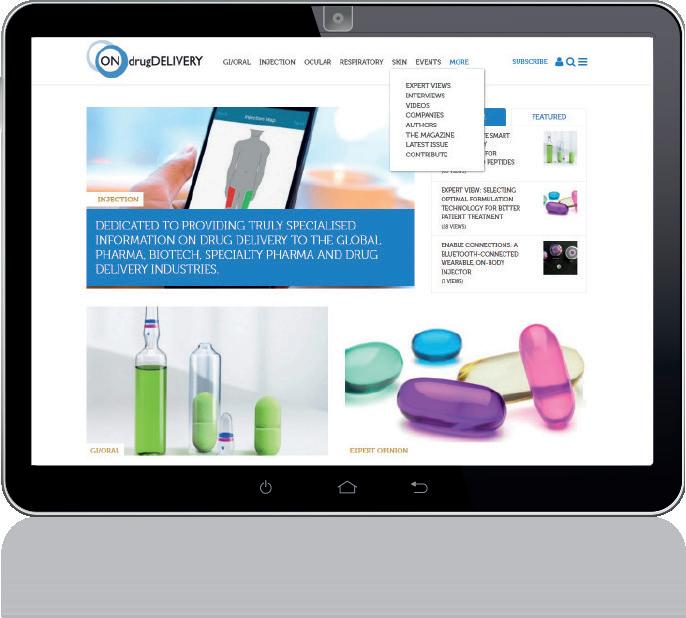

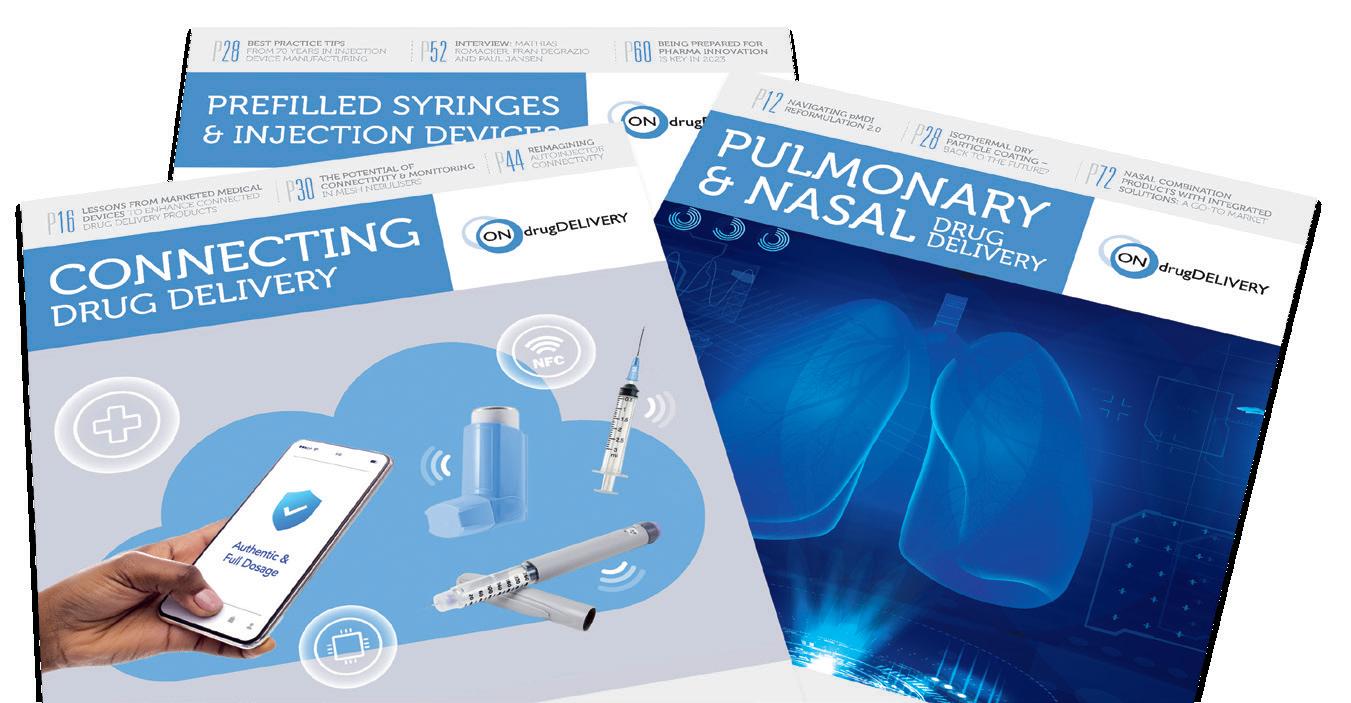
Transitioning from intravenous (IV) to subcutaneous (SC) injections has several advantages – SC injections are more comfortable for patients during administration, more convenient, don’t require finding a suitable vein and can
be self-administered, empowering patient autonomy. SC injections also reduce the requirement for hospital visits, achieve more stable drug absorption, allow for lower drug dosages and minimise side effects by reducing direct contact with blood and
organs. Transitioning to SC administration offers a more comfortable, patientcentric experience, reducing healthcare resource use and improving drug delivery effectiveness. As such, SC administration emerges as the preferred drug delivery method in various scenarios.
Felice Dose is a revolutionary on-body injector (OBI) designed to address the challenges of traditional IV injections and SC drug administration (Figure 1). The device aims to provide a more efficient and comfortable drug delivery method for patients and meet the evolving needs of the pharma and biotech industries.
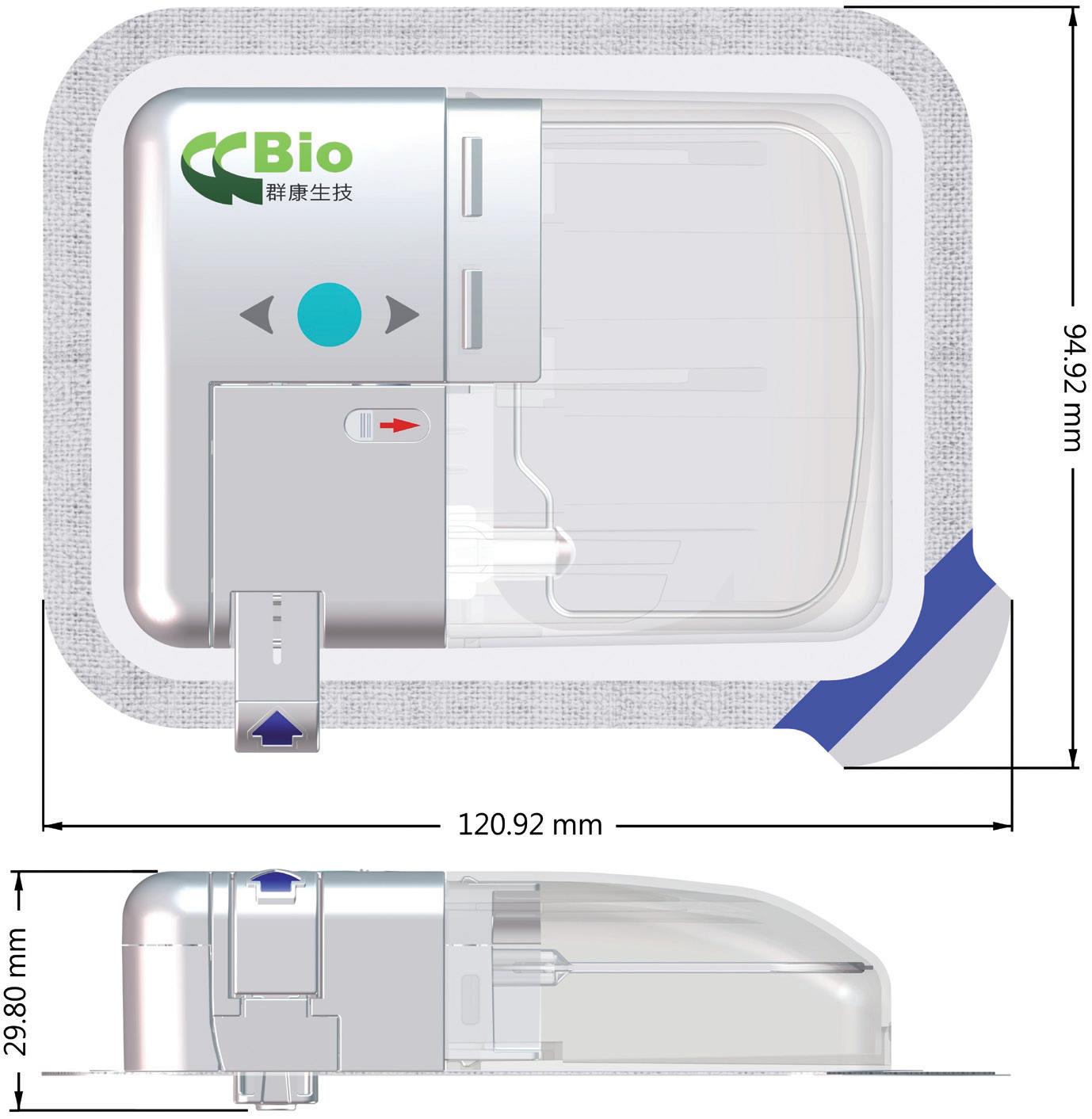
Felice Dose addresses the high failure rate of IV injections due to vein inflammation or phlebitis by offering an SC drug delivery device with a stable delivery motor system. This ensures a stable dose of the drug per unit time, reducing swelling and pain underneath the skin through a discontinuous pressure mechanism that prevents discomfort during administration (Figure 2).
One of the key advantages of Felice Dose is simplifying SC infusion. Previously, patients have had to spend an hour or more in the hospital for SC infusions, but Felice Dose enables them to perform an SC infusion conveniently at home or work, or during travel, while meeting safety
Contact:
Jimmy Fan
Marketing Vice-President
T: +886 384 5868
E: jimmyfan@ccbio.com.tw
CCBio
No. 68, Gongye 5th Rd
Annan District
Tainan City 709015 Taiwan
www.ccbio.com.tw
Figure 1: Felice Dose – CCBio’s on-body injector.“SC injections are more comfortable for patients during administration, more convenient, don’t require finding a suitable vein and can be self-administered, empowering patient autonomy.”
and hygiene standards. This convenience improves patients’ quality of life, offering flexibility and reducing the burden of needing to visit a hospital or clinic.
Felice Dose is capable of handling large drug volumes, varied and long-duration
injections and different drug viscosities (Figure 3). It offers flexibility in terms of primary drug container, needle gauge, needle length and user interface, allowing pharma to customise the drug delivery experience according to their patients’ specific needs and preferences.
Felice Dose uses a mini-bag elastic polymer container system, allowing dose volumes to be adjusted from 5 to 250 mL. The device also incorporates steel needles of varying gauges and soft needles to maximise patient convenience and minimise pain during skin penetration. Felice Dose empowers patients by giving them a greater sense of control and autonomy over their treatments. With medical guidance, patients can independently manage their treatment process, leading to improved treatment effectiveness and overall satisfaction.
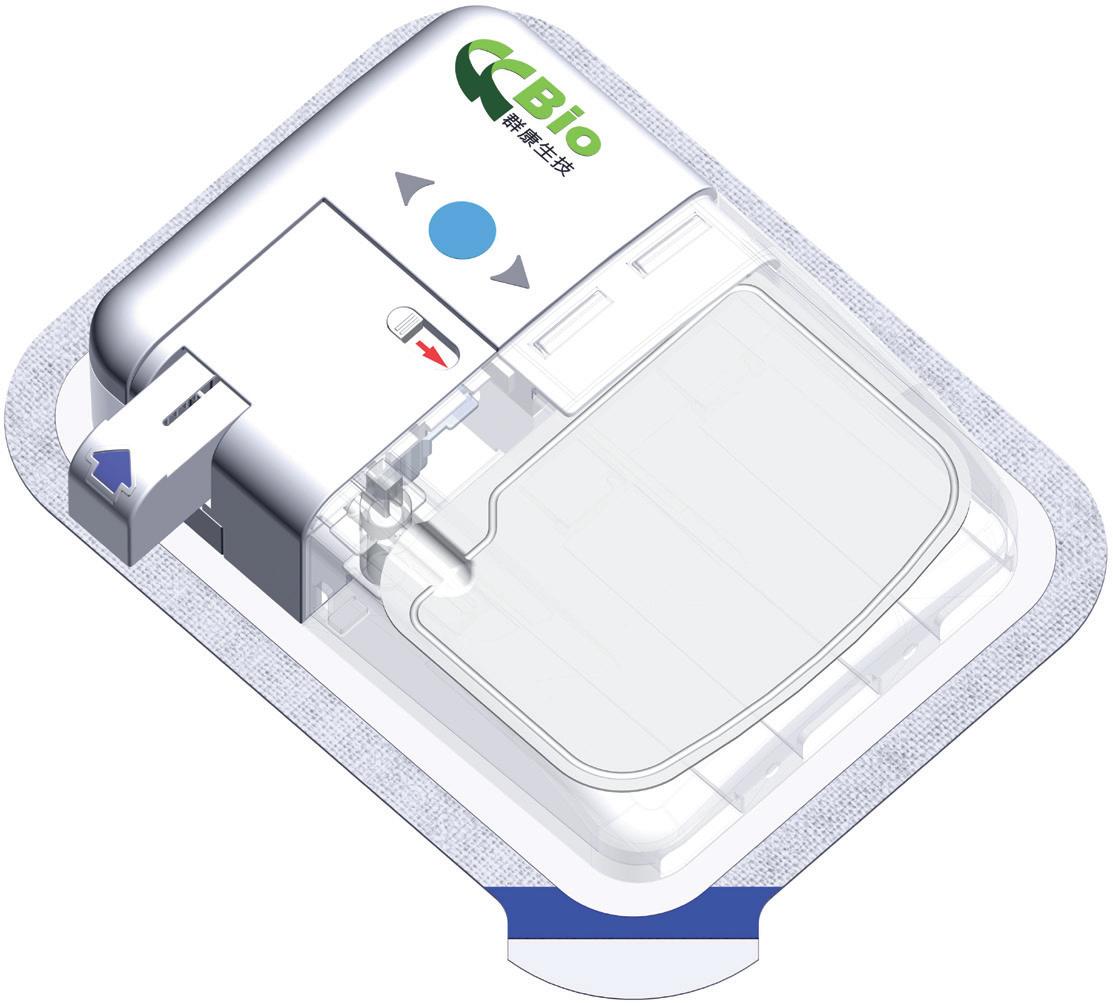
The user interface of Felice Dose is well designed and technologically advanced, featuring options for WiFi, near field communication (NFC) and Bluetooth connectivity. The fully-customisable programmability empowers patients to take control of their treatment, making their daily lives easier and more comfortable. With this level of control and connectivity, the need for frequent hospital visits and healthcare provider involvement is reduced.
The use of a lithium battery and the delivery motor system’s capability to function without continuous power contribute to the device’s overall lightweight design, enhancing patient comfort during wear. This design also aligns with the industry’s increasing interest in SC drug formulations and wearable OBIs.

The Felice Dose device has undergone successful experiments, proving its capability to handle a 20 mL injection for up to one hour. In this experiment, CCBio used a standard viscosity solution without any drug. During the experiment, a flexible drug bag was filled with 21 mL of the non-drug standard viscosity solution. The drug bag was then placed on a microbalance with a precision of three decimal places to continuously record data, including the accumulation of the solution over time.
From the experimental results, it was observed that the accumulation of the solution during the injection process exhibited a linear slope, and the injection of the solution was completed within the predetermined standard time, leaving approximately 1 mL of residual solvent (Figure 4).
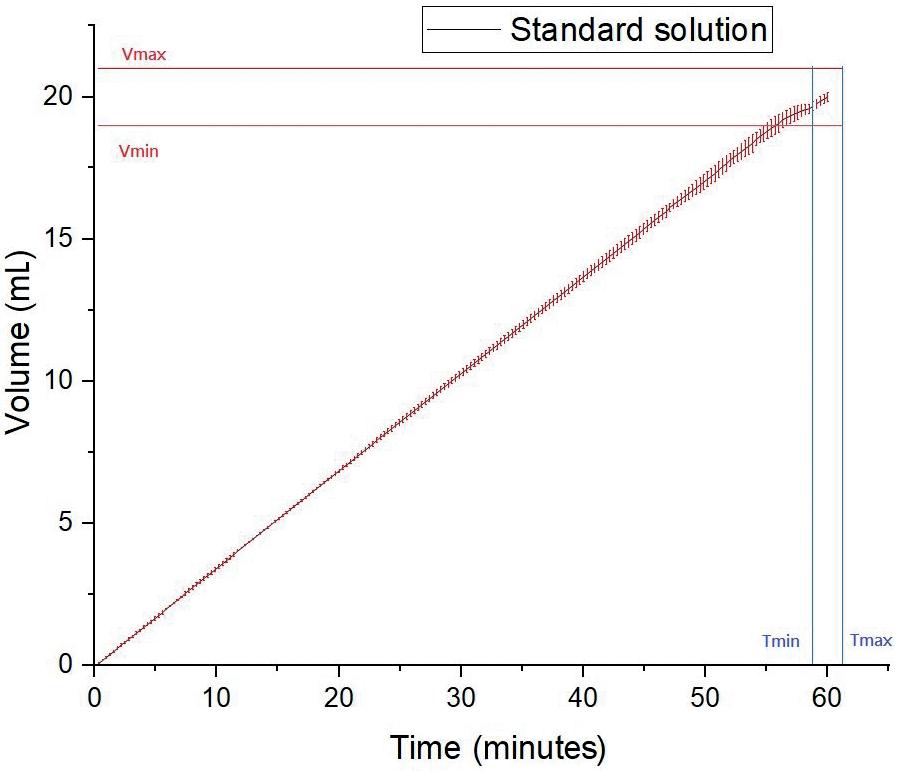
“Previously, patients have had to spend an hour or more in the hospital for SC infusions, but Felice Dose enables them to perform an SC infusion conveniently at home or work, or during travel.”Figure 2: Felice Dose delivers a stable dose of drug per unit time. Figure 3: Felice Dose is capable of delivering large volumes, longduration injections and varying drug viscosities.
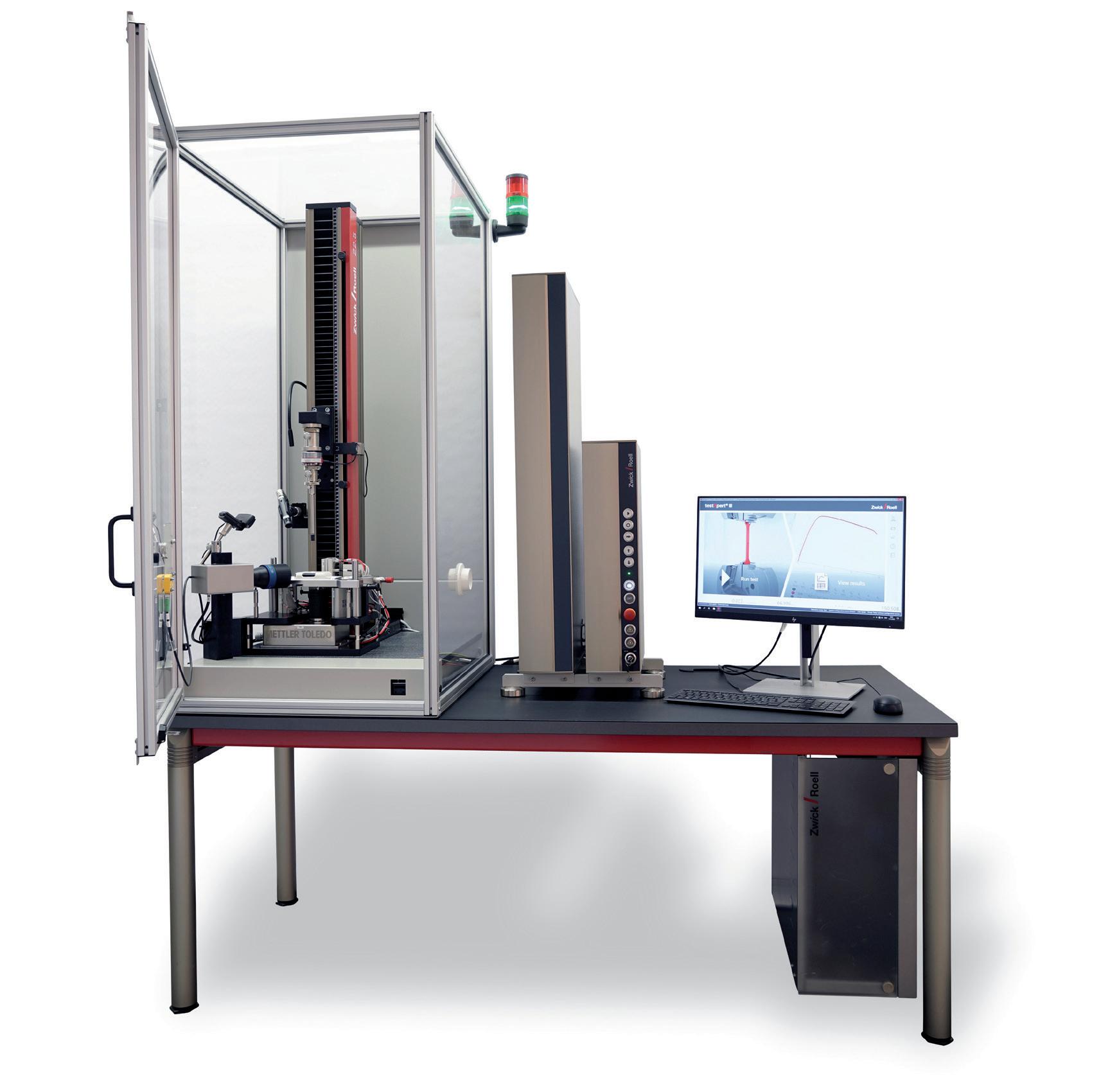
One of the most exciting areas of development in injectable drug delivery is on-body delivery systems (OBDSs), also known as wearable autoinjectors or simply wearables. These are devices that automatically administer highly viscous biologic drugs, while attached to the patient’s body. In the fast-growing market for biotechnological applications, machine manufacturer ZwickRoell now offers a customised, comprehensive solution for performing functional tests in accordance with the ISO 11608-6 standard.
People suffering from an illness are likely to recover faster in a familiar environment – in other words, at home. For chronically ill patients, shortening the healing process is of particular significance and OBDSs can help achieve this. They not only reduce the cost of long-term therapies; they also have the ability to promote patient comfort by allowing them to set up and undergo treatment in their own surroundings. These systems can reduce the required frequency of visits to a clinic or doctor’s office for injections that would otherwise have to be administered by qualified personnel.
The benefits provided by an injection system securely attached to the patient’s body are clear – they reduce the possible risks that result from the administration of medicines through more commonly used needle-based injection systems. Additionally, they are capable of optimally dispensing drug volumes ranging from 2 mL to 20 mL, in time intervals from as little as a few seconds up to several hours. This form of therapy is ideal for daily self-treatment and can be implemented without having to spend time in a medical facility. The adhesive side of the injection system is attached directly to the patient’s skin, and the injection is administered through a needle or cannula integrated in the device.
Heiko Haller Business Development Manager –Medical Industry heiko.haller@zwickroell.com
heiko.haller@zwickroell.com
“ZwickRoell now offers a customised, comprehensive solution for performing functional tests in accordance with the ISO 11608-6 standard.”Figure 1: Universal testing system for function tests on OBDSs.



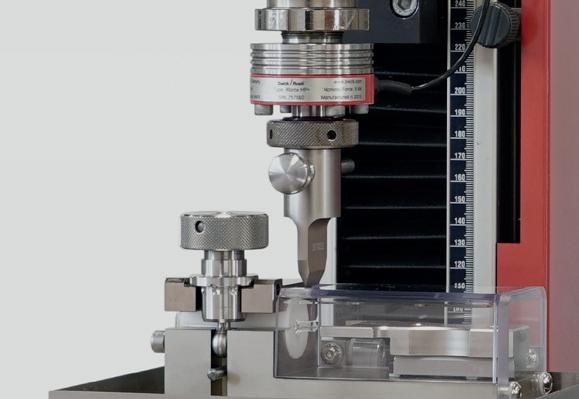
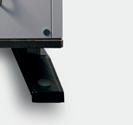

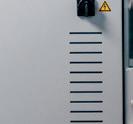

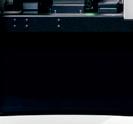


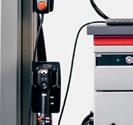
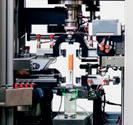
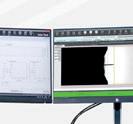
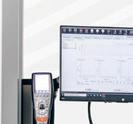
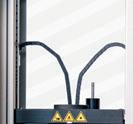
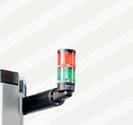
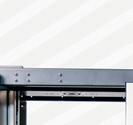
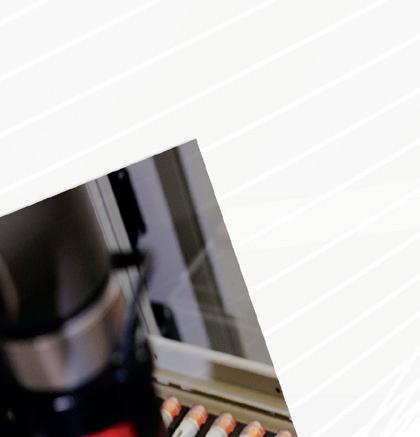
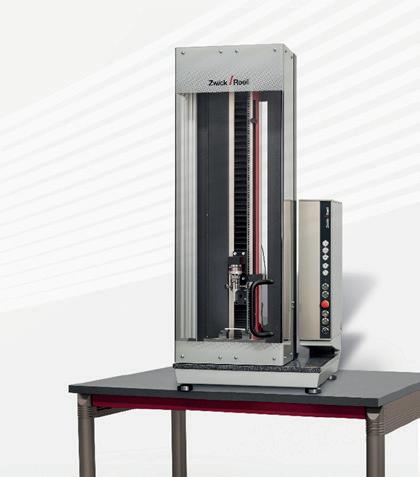

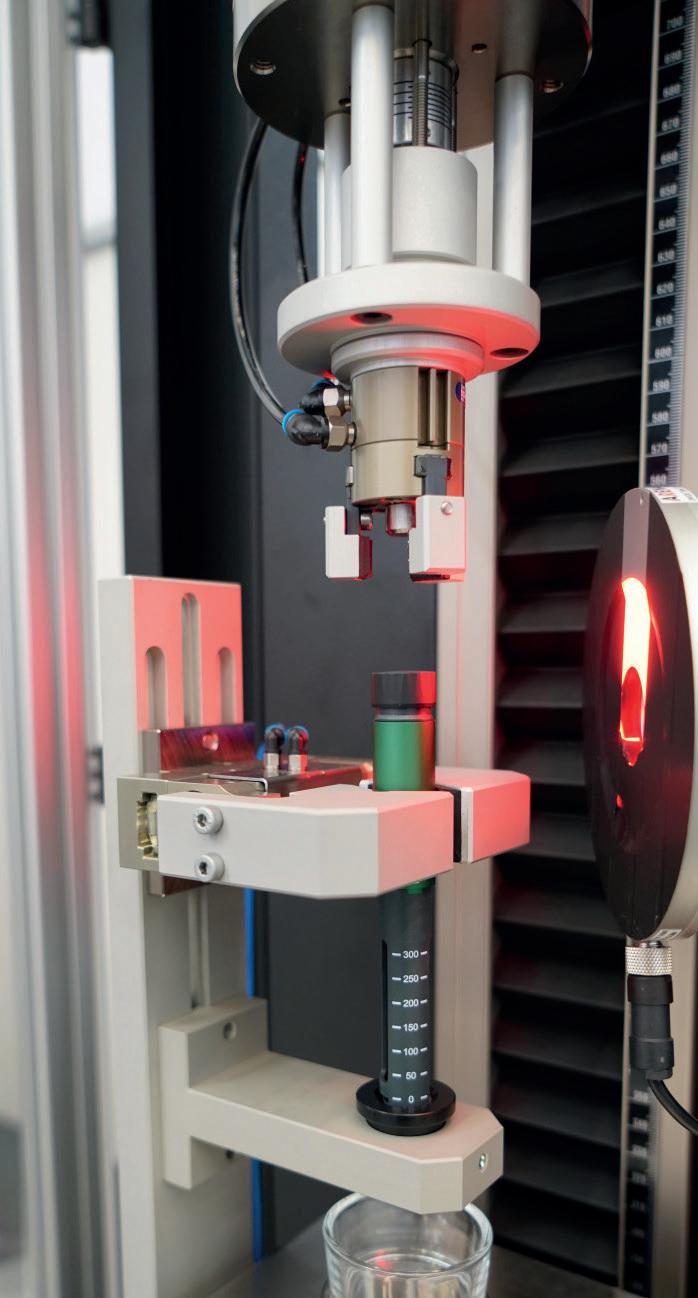



· Manual, semi-automatic and fully automated testing solutions for therapy systems (needles, (pre-filled) syringes, insulin pens, auto injectors)




















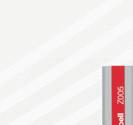
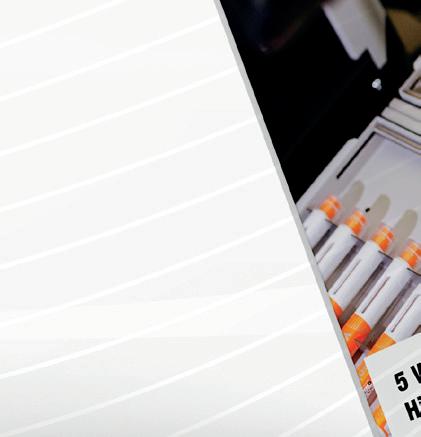

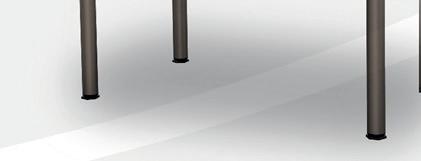


























· Traceable and tamper-proof test results in accordance with FDA 21 CFR Part 11 ZwickRoell supports customers with DQ, IQ and OQ services

















What is your testing challenge? info@zwickroell.com



However, in today’s OBDS market – which is growing by more than 20% annually –manufacturers face a number of challenges when it comes to developing large-volume injectors. More specifically, ISO 11608-6 requires them to test the forces experienced by the device during the injection process due to the viscosity of the drug, the high volume, the injection time, the internal diameter of the syringe and needle, the needle length and any frictional forces (including static friction).
ZwickRoell has responded to this challenge by applying its many years of experience in materials testing and collaborating with pharmaceutical companies and autoinjector device manufacturers to develop a sequential testing solution for OBDSs (Figure 1). The solution is based on the zwickiLine 2.5 kN static testing machine.
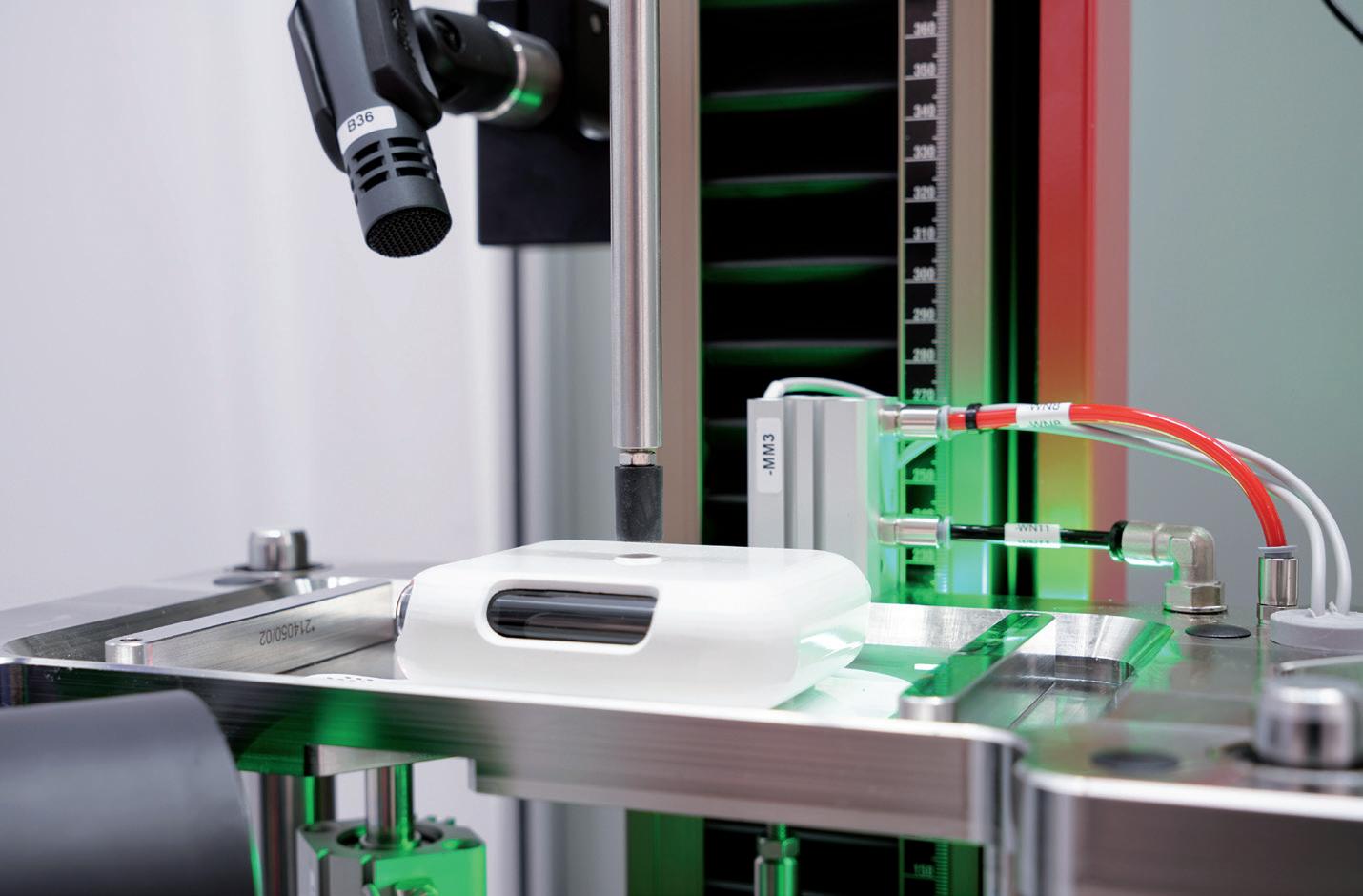
With a number of newly designed adaptations, the machine now measures the force required to trigger the actuation button (Figure 2), as well as the injection depth, injection time and the amount of liquid delivered using a high-resolution, camera-based measuring system (Figure 3). An integrated camera records the process to verify how the sequences of the display elements react and documents the audible signals (clicking sounds) of the injection system via a microphone.
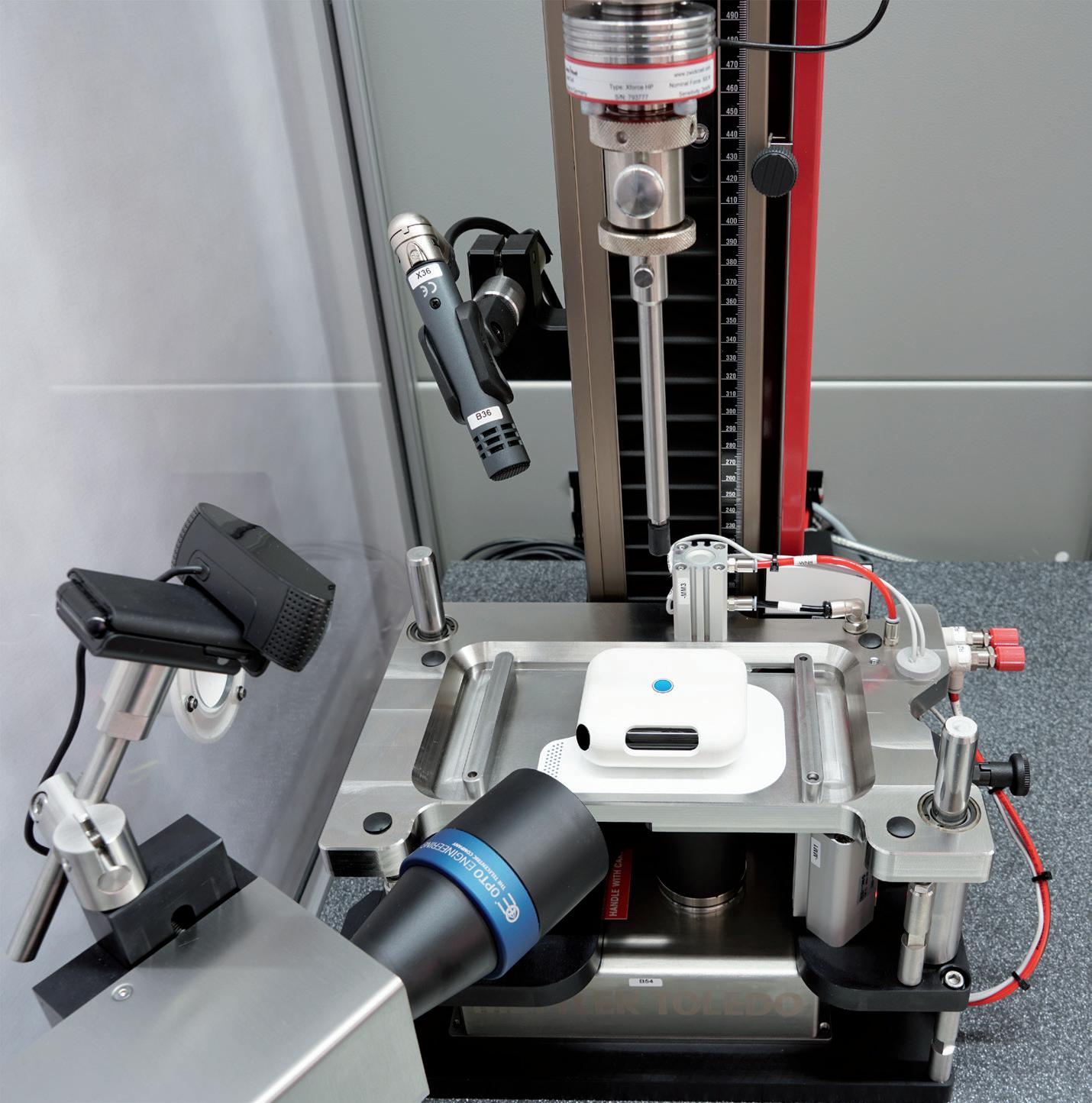
In a second test area, the testing machine optionally supports additional tests, such as determining the adhesion force of the bonding surface.
Another advantage of ZwickRoell’s comprehensive solution is the corresponding test sequence for its testXpert III testing software. It not only documents the obtained results, but also quickly displays them in a clearly presented format. For maximum transparency and secure traceability for validation and quality control, the machine performs the tests reliably and according to the required standards. This is important because, in the biotechnology sector and the pharmaceutical industry, it is imperative to know who did what, when and why, and who is responsible. Every action must be documented in a tamper-proof and traceable manner, according to US FDA CFR Part 11.
Throughout the machine development process, ZwickRoell accounted for every requirement specification included in the standard. The result is a complete solution for the development of autoinjectors for cancer treatment therapies, autoimmune diseases and neurological disorders. ZwickRoell says this is very close to meeting every customer requirement and is ultimately intended to benefit the patient.
“Throughout the machine development process, ZwickRoell accounted for every requirement specification included in the standard.”Figure 2: The machine measures the force
required to trigger the actuation button.
